Topic pack - Marketing - introduction
Welcome to this Triple A Learning topic pack for Marketing. The pack has a wide range of materials including notes, questions, activities and simulations.
A few words about Navigation
So that you can move to the next page in these notes more easily, each page has navigation tools in a bar at the top and the bottom. These tools are shown below.
![]() The right arrow at the top or bottom of the page will take you to the next page of content.
The right arrow at the top or bottom of the page will take you to the next page of content.
![]() The left arrow at the top or bottom of the page will take you to the previous page.
The left arrow at the top or bottom of the page will take you to the previous page.
![]() The home button will take you back to the table of contents for the pack.
The home button will take you back to the table of contents for the pack.
The pack is split into a series of sections and to access each section, the easiest way is to use the table of contents on the left-hand side of the page. To return to the full table of contents, please click on the 'home button' at any stage.
Higher level extension material
Some of the material in this pack relates to the higher level extension topics in the Business and Management guide. This material is marked by icons as follows:

This icon indicates the start of the higher level extension material.

This icon indicates either:
- The higher level extension material continues on the next page or
- The higher level extension material continues from the previous page

This icon indicates the end of the higher level extension material.
Terms and definitions
One of the key things you need to be sure to know are the definitions of all key business terms. In this section we give you explanations and definitions as well as some flash cards, crosswords and word searches to help you practice them.

If you would prefer to view this interaction in a new web window, then please follow the link below:
Click on the right arrow at the top or bottom of the page to start looking at the definitions.
Aims of the business and management course
The aims of the business and management course at HL and SL are to:
- promote the importance of exploring business issues from different cultural perspectives
- encourage a holistic view of the world of business
- enable the student to develop the capacity to think critically about individual and organisational behaviour
- enhance the student's ability to make informed business decisions
- enable the student to appreciate the nature and significance of change in a local, regional and global context
- promote awareness of social, cultural and ethical factors in the actions of organisations and individuals in those organisations
- appreciate the social and ethical responsibilities associated with businesses operating in international markets.
Assessment Objectives
Having followed the business and management course at HL or SL, students will be expected to:
- demonstrate knowledge and understanding of business terminology, concepts, principles and theories
- make business decisions by identifying the issue(s), selecting and interpreting data, applying appropriate tools and techniques, and recommending suitable solutions
- analyse and evaluate business decisions using a variety of sources
- evaluate business strategies and/or practices showing evidence of critical thinking
- apply skills and knowledge learned in the subject to hypothetical and real business situations
- communicate business ideas and information effectively and accurately using appropriate formats and tools.
In addition to the above, students at HL will be expected to:
- synthesize knowledge in order to develop a framework for business decision-making.
Topic Four Structure
Topic four has eight core sub-topics
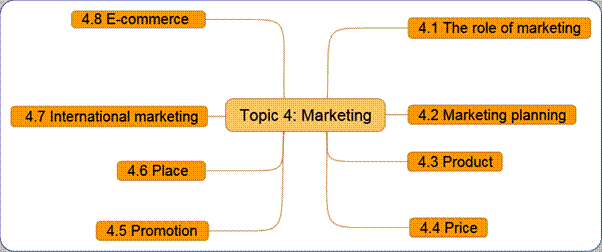
4.1 The role of marketing - notes
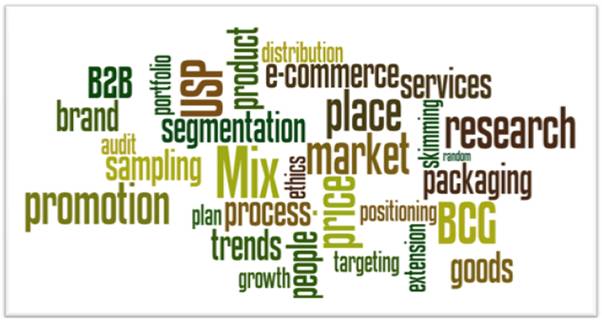

In this section we will examine the role, definition and nature of marketing.
By the end of this section you should be able to:
- Examine the characteristics of the market in which the firm is immersed
- Calculate market share from given information
- Define marketing and describe the relationship with other business activities
- Describe the difference between market and product orientation
- Explain the difference between the marketing of goods and services
- Analyse the marketing techniques of non-profit organisations
- Describe the elements of a marketing plan

- Analyse the influence of marketing orientation on the success or failure of firms
The role of marketing
In this first section we turn our attention to the role of marketing. It is tempting to believe we know all about marketing as we are surrounded by it every day. However, firms are more scientific in their approach than we might always assume and the psychology of marketing has been developed and tested over many years. There is some argument over the extent to which we, as consumers, can be manipulated, but there is little doubt that marketing is highly influential in the way we behave and that it impacts on our purchasing behaviour and intentions.
Marketing can be viewed as both a functional aspect of an organisation and a business philosophy. The marketing philosophy or concept is an approach that stresses the achievement of business goals through customer satisfaction. The complex range of activities that define marketing are applicable to all firms, large or small, new or established and even applies to non-profit making organisations.
Marketing is the process of identifying a target market, defining what that target market needs and/or wants and organising the firm to meet those needs and wants. The Business and Management marketing syllabus begins with the requirement to examine the characteristics of the markets in which firms operate and to be able to examine the relationship between the firm and those markets. In particular it considers the following three elements:
- Market size
- Market growth
- Market share
Market size and market share
Economies could not operate without the existence of markets.

What is a market?
A market is a place or process which allows buyers and sellers to meet and exchange goods, services and information.
Markets exist to facilitate trade between collections of people who share a want or need and are motivated to enter into exchange processes to satisfy that want or need. Markets can be local, national or international, but the marketing concepts covering all marketplaces are relatively similar Customers for a firm can be private individuals, other businesses or local or central governments.
Markets that cater for private individuals are referred to as consumer markets, while those serving organisations are industrial or commercial markets. It is important to recognise that trade between businesses, commonly referred to as B2B (business to business) is much larger in value than sales to private individuals, but does not attract the same coverage in textbooks.
Write a brief description of the companies below and the markets in which they operate and then follow the link below to compare your answer to ours. If you're not sure who they are then follow the link to their website to see what they do:
Hint
If you look at these sites you will find they are mainly sales sites, but you want company information. When looking at company sites, always look for links on the page that say something like 'Investor information', 'Corporate information' or 'About us'. You will usually find the interesting business information under those headings.
Suggested answers
Market size
 Markets vary enormously in size and are governed by the laws of demand and supply. Obviously very few products are capable of appealing to everyone. Some markets, such as the market for recorded music is huge, whereas the market for competition bobsleds is significantly smaller!
Markets vary enormously in size and are governed by the laws of demand and supply. Obviously very few products are capable of appealing to everyone. Some markets, such as the market for recorded music is huge, whereas the market for competition bobsleds is significantly smaller!
We would say that the market for bobsleds is a niche market appealing to a very small number of potential customers. This type of market is likely to attract small specialist producers. Large companies are likely to ignore these markets because there is insufficient return to justify entry and no opportunities for economies of scale in production.
Various terms are used to describe the market based on the level of narrowing, with each narrowing reducing the size of the market:
- Total population
- Potential market - those in the total population who have interest in acquiring the good or service.
- Available market - those in the potential market who have effective demand - the desire to buy a product backed up the ability to pay for it
- Qualified available market - those in the available market who are legally permitted to buy the product.
- Target market - the segment of the qualified available market that the firm has decided to serve
- Penetrated market - those in the target market who have purchased the product.
Let's look at these concepts in the context of an example. It is important for firms to know the size of market because this information is required to assess whether the market is worth entering and whether it is growing or contracting. Once in the market, a firm will wish to be able to calculate what share of the market its products hold.
Imagine you are thinking of introducing a new shampoo to the market. What would you need to establish to understand the size of the market?
Some markets are not easily measured. For example 'black markets' such as those for drugs, are large in terms of value and consequently attract many buyers and sellers. However, since these are markets for products that are illegal, stolen, or otherwise need to be hidden from regulatory authorities, customers are unlikely to volunteer information about themselves or reveal their market activities!
There three main measures of a market's size. These are:
- The volume of sales
- The value of sales
- The number of customers
Market size by sales volume measures the amount of goods sold by quantity, e.g. bottles of cola. Market size by value measures the amount spent by customers on the volume of goods sold and will be expressed in a currency such as US dollars or Euros. The number of customers is self explanatory.
Value versus volume
A company might sell a large volume of products. However, it may be that the sale price is such that the total value of sales (total sales revenue) is less than a competitor, which sells a smaller amount of a more valuable product.
The following is a summary of the state of the UK soft drink market in 2009 by value and by volume. This chart compares the value of soft drinks bought in shops and taken home compared to the value of soft drinks consumed in pubs, bars and restaurants. When measured by value the take home market is smaller than when measured by volume. This is because consumers pay more for products consumed outside of the home, but indicates the need to be careful when comparing market size.
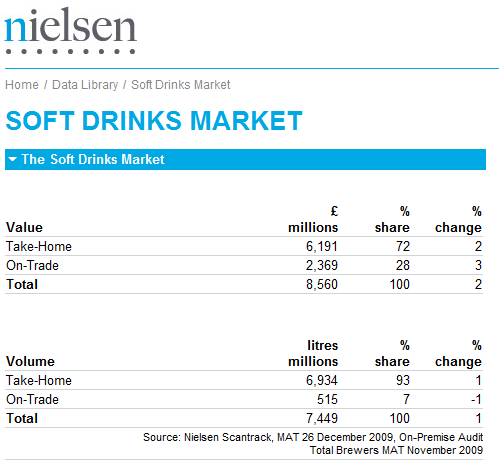
The same issues apply in other industries. For example, a Paris-based fashion house might only sell a few hundred dresses and gowns in a 'season', but at several thousand Euro per item. Their revenue may be larger than a local fashion shop, which sells many dresses each month, but at a fraction of the price charged by the Parisian designer.
Global car production is an excellent barometer of the state of the world economy and the market size is examined by economists to provide a basis for economic analysis. Below is the global car market measured volume from 2007 to 2009.
Global car production statistics
| Year | Cars | Commercial vehicles | Total | % change |
|---|---|---|---|---|
| 2007 | 53,201,346 | 20,064,715 | 73,266,061 | 5.8% |
| 2008 | 52,726,117 | 17,794,376 | 70,520,493 | -3.7% |
| 2009 | 47,952,995 | 13,761,694 | 61,714,689 | -13.5% |
| source http://oica.net |
A real-time record of car sales can be found here.

- Describe what these figures show for car and commercial vehicle production?
- Analyse these statistics and comment on what they say about trends in the global economy.
Market growth
This is normally thought of as the percentage change in sales of a product or service over a certain period of time. This may reflect changes in volume and/or value. The market growth rate is a factor to be considered when evaluating the performance of a particular product in a particular market. A growing market offers sales potential and the opportunity for the firm to become more profitable, but growth may also attract rivals (competitors), who recognise the profit potential.
![]()
| Year | Market value $m |
| 2010 | 10 |
| 2011 | 12 |

Example:
![]()
![]()
Market share
Market share is the percentage of all the sales in a particular market that are held by one brand or company. This can be measured by volume (units sold) or by value (the revenue generated)
![]()
So if the sales revenue for a firm is $50m of a market worth a total of $250m, then the firm's market share is 25%. Firms seek to increase their market share as this conveys certain advantages.
Normally, an increasing market share means that the company is growing in influence or power within that market. The market leader will often have higher economies of scale than competitors and will be able to charge lower prices or have a higher profit margin.
We can make this measure for an individual brand or an individual company. Using this measure of company performance allows us to see how well a firm is competing against their rivals and who is building, and who is losing, market share. It is useful to find out the sales level achieved by the firm's largest competitors and then use that information to compute relative market share.

"The important factor in computing relative market share is not the exact number associated with the sales volume, your position relative to the competition is more important."
Kenneth J. Cook
The AMA Complete Guide to Strategic Planning for Small Business
For example, Coca-Cola's sales have historically made up a large percentage of the total sales of the cola beverage industry, and it had dominated the market. However, over recent years Pepsi Cola has managed to increase its relative market share.
According to Beverage Digest's 2008 report on carbonated soft drinks, PepsiCo's U.S. market share was 30.8 percent, while The Coca-Cola Company's was 42.7 percent. Overall, Coca-Cola continues to outsell Pepsi in almost all areas of the world, except India, Saudi Arabia and Pakistan. The data also showed that both were losing share to other competitors such as Red Bull.
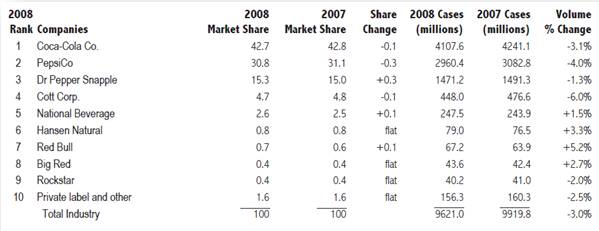
Source: Beverage-Digest.com
This type of information can also be used to measure market concentration, which is the extent to which a relatively small number of firms account for a relatively large percentage of the market. Concentration ratios are measures of the total output that is produced in an industry by a given number of firms in the industry. The most common concentration ratios are the CR4 and the CR8, which measures the output of the 4 and the 8 largest firms.
Information on the overall size of markets is usually available through industry associations, which commonly track both sales and growth rates. If competing firms happen to be publicly owned, their sales figures can usually be found from their annual reports. However, this information is frequently out of data. It may also be problematic to define a market with some products crossing several markets.
Is an iPad, for instance, in the netbook market, the e-reader market or the book market?
Definition and nature of marketing
 It's often the case that business and management students enjoy marketing more than any other topic on the syllabus. This is understandable as the subject is lively and easily related to real life - after all we are all consumers. We remember advertising campaigns that have made us laugh or think about buying product and services that have given us immense satisfaction or huge frustration and disappointment. Marketing is a significant part of daily life. However, like most things it's somewhat more complicated than just putting a certain supermodel inside a car and letting the sales take off! Indeed, marketing answers in examinations are often superficial, unstructured and lacking in academic rigour. In other words: beware the curse of the 'easy marketing question'
It's often the case that business and management students enjoy marketing more than any other topic on the syllabus. This is understandable as the subject is lively and easily related to real life - after all we are all consumers. We remember advertising campaigns that have made us laugh or think about buying product and services that have given us immense satisfaction or huge frustration and disappointment. Marketing is a significant part of daily life. However, like most things it's somewhat more complicated than just putting a certain supermodel inside a car and letting the sales take off! Indeed, marketing answers in examinations are often superficial, unstructured and lacking in academic rigour. In other words: beware the curse of the 'easy marketing question'

Let's begin by saying what marketing is NOT.
- Marketing is not interchangeable with advertising. Advertising is just one element of marketing, and a relatively small element at that as it is only a part of promotion. So in examination questions or coursework, do not get carried away with simply describing adverts that appealed to you. Support your answers with examples and data and relate advertising to other aspects of marketing.
- Marketing is not interchangeable with selling. Selling emphasises the needs of the seller, whereas marketing focuses on the needs of the buyer. Selling can be seen as the last stage of the marketing process.

"Selling tries to get the customer to want what the company has; marketing, on the other hand, tries to get the company to produce what the customer wants."
Theodore Leavitt
Before we define and explore the concept of marketing in detail, write down your ideas about what companies are trying to achieve through their marketing and then follow the Marketing link to see if you have got similar ideas to us.
There are many definitions of marketing. The better definitions are focused upon customer orientation and satisfaction of customer needs.

Marketing
"Marketing is the management process responsible for identifying, anticipating and satisfying customer requirements profitably."
Chartered Institute of Marketing (CIM)
There are 4 main elements to this widely used definition that need examining, as these address individual specialism of the marketing function:
- A management process: Marketing has to be planned and represents a key element of part of the firm's strategy. It just doesn't happen!
- Identifying customer requirements: 'Gut feeling' and 'instinct' may have some role in business, but what firms believe customers want may not match the reality, especially in fast changing markets. Indeed, market places are like battlefields littered with casualties of war. The mortality rate of new products is particularly high and the majority of most popular brands are ones that have been in existence for many years. A successful business must understand its customers' needs, wants, habits and attitudes and it achieves this through thorough market research and careful analysis of data.
-
 Anticipating customer requirements: Being 'first to market' with a product or service offers significant advantages, as it allow the firm to develop customer and brand loyalty. Sony, for instance, dominated the portable music player market for many years after it introduced its Walkman in 1979.
Anticipating customer requirements: Being 'first to market' with a product or service offers significant advantages, as it allow the firm to develop customer and brand loyalty. Sony, for instance, dominated the portable music player market for many years after it introduced its Walkman in 1979. - Satisfy customer needs: Goods and services must satisfy customers' needs and wants and be perceived as good value for money. A satisfied customer often results in repeat purchasing behaviour and good word-of-mouth promotion.
- Making a profit: This definition appears to apply only to commercial businesses if the word profit is taken literally meaning sales revenue exceeds total cost. However, the concept could be applied to non-profit organisations if they make a surplus which can be used to provide a service or if desired results are achieved. For example, if a local government was able to increase recycling and so save costs and improve the environment, this could be perceived as a 'profitable' outcome.
Marketing is a key management discipline that enables the producers of goods and services to interpret customer wants, needs and desires and then match, or exceed them, in delivery to their target consumers. It is therefore an ongoing process that places the consumer at the centre of all activities and affects every aspect of a business. The philosophy of marketing needs to be owned by everyone from within the organization, not just placed within the marketing department. Every employee markets a firm in some way from the CEO to the receptionist. Indeed the marketing of the business extends outside of the workplace - a negative or positive statement about the firm made in a restaurant, shop or bar, may be picked up by others and passed on. Word-of-mouth is a very powerful promotional tool!

Think what effect you and your family may have on the demand for your school? How may you influence public opinion?
Another useful definition of marketing is:

Marketing
"Marketing is the social process by which individuals and groups obtain what they need and want through creating and exchanging products and value with others."
Philip Kotler
This definition has less of a focus on profit making organisations and places greater emphasis on the exchange process. It recognises the social element of the marketing process.
Marketing - Sliced bread and other delights
Let's start by considering some case studies in marketing. The video below by Seth Godin looks at four different case studies related to marketing and during the course of the video considers the role of marketing in selling goods and services. Although it was first broadcast in 2003, the ideas within it are as relevant now as they were then. The video is 17 minutes long - definitely watch to the end; there is plenty of relevant and explained marketing information... oh and it's quite funny!

For a short introduction to marketing and definitions of key terms related to marketing, have a look at the video on the Dragon's Den website below:
The marketing process
This marketing process may be seen as:

"Getting the right product to the right place at the right time and right price and making a profit out of the transaction".
Adcock et al
If you would prefer to view this interaction in a new web window, then please follow the link below:
Marketing and its relationship with other business activities.

"Marketing is not only much broader than selling, it is not a specialized activity at all. It encompasses the entire business. It is the whole business seen from the point of view of the final result, that is, from the customer's point of view. Concern and responsibility for marketing must therefore permeate all areas of the enterprise."
Peter Drucker.
What Drucker is saying is that marketing should be seen as a business philosophy, in that the existence of any business depends on satisfying customer needs and wants. This cannot be the sole responsibility of the marketing department.
Marketing is a strategic discipline which underpins most activities of the business and is an essential ingredient of corporate strategy as communicated in the corporate plan. Drucker also said that marketing is:
"The whole business seen from the customer's point of view"
 What is important, therefore, is that the product meets customers' needs. Although the marketing function is normally carried out by a specialised department, marketing thinking must permeate the entire organisation. Developing an effective marketing plan will require close links with other functional areas of the business.
What is important, therefore, is that the product meets customers' needs. Although the marketing function is normally carried out by a specialised department, marketing thinking must permeate the entire organisation. Developing an effective marketing plan will require close links with other functional areas of the business.
The nature of departmental/functional organisations, means it is likely that there is the potential for conflict between functional areas when delivering the corporate plan.
Operations management/production
The marketing department will need to work closely with the production department to ensure that:
- Adequate research and development is planned to satisfy current and future customer needs
- The item can be manufactured to the quality and design specifications laid down by the consumer
- The volume of orders generated by marketing can be met within the time schedule required for delivery
It is likely that the marketing department will set deadlines that may stretch the capabilities of the production department. Marketers will wish to get products to market as soon as possible to ensure competitive advantage, whereas production will want to test and develop products fully to ensure that they do not have to repair or replace defective items and that they meet health and safety requirements.
Finance department
The marketing department will need to work closely with the finance department to ensure that:
- There is an adequate budget to meet the needs for research, promotion and distribution
The finance department have a whole organisation brief to ensure that all the business operates within its financial capabilities. They will want all departments to work within their allocated budgets. Like all departments, marketing may wish to overspend if profitable marketing opportunities emerge over the year. The marketing department is likely to concentrate on sales volume and building market share, while the finance department may be more focused on cash flow, covering costs and paying back investment as quickly as possible.
Human Resource Management
The marketing department will need to work closely with the HRM to ensure that appropriate skills and staffing levels are in place to:
- Research and develop new product ideas
- Meet production targets
- Create an ambitious and competent sales team
The HRM department will have many recruitment and training demands from across the organisation. It will have to balance its obligations to marketing with those to other departments.
Market and Product Orientation
The concept of a specialist marketing function really only developed after the second world war and focused primarily on selling fast-moving consumer goods (FMCGs) such as food and clothing. The success of marketing in helping to create competitive advantage encouraged firms in the service and manufacturing sector to adopt marketing techniques and soon non-profit organisations such as NGOs and the education sector realised the value in terms of their operations as well.
If you would prefer to view this interaction in a new web window, then please follow the link below:

When you visit the local supermarket to buy a packet of cereal, how many brands and products are on the shelf in front of you? What factors influence your selection?
Key elements - market orientation
If you would prefer to view this interaction in a new web window, then please follow the link below:
Market or product orientation?
The approach adopted by a firm will be determined by the nature of:
- The product
- The market
- The firm
If the product is highly specialised or a niche product, there is unlikely to be much competition and barriers to entry to the market may be high. Under these circumstances, there may be little incentive for the firm to carry out expensive market research if it can sell all of its output at the price it determines. This was certainly true of technological developments such as games consoles and smartphones like the iPhone, where initial output was low relative to demand and premium pricing was possible. As markets grow in size, increased competition forces firms to be more market orientated.
Traditional, long established firms in manufacturing sectors may have corporate cultures which encourage product orientation - a 'we know best' approach. The emphasis is on keeping costs low and maintaining production efficiencies. However, whether this attitude can last into the long term is debatable unless the management is particular adept at consistently producing desirable products.

Additional marketing orientations
At HL, you will also need to consider the additional marketing orientations:
- Social marketing
- Asset-led marketing
There is a summary of these below (along with all the SL orientations) and further detail on the following pages.
If you would prefer to view this interaction in a new web window, then please follow the link below:
Social marketing
Like commercial marketing, the primary focus of social marketing is still on the consumer and on learning what people want and need rather than trying to persuade them to buy what the firm is producing. However, social marketing has quite naturally been adopted by the non-profit sector, such as NGOs, health trusts and training and education providers. Social marketing can be applied to promote merit goods, or to make a society avoid demerit goods and thus to promote society's well being as a whole. For example, this may include asking people not to smoke in public areas or prompting drivers to respect speed limits.
 In order to have a viable product, consumers must first perceive that they have a genuine problem, and that the product offering is a good solution for that problem. The role of research here is to discover the consumers' perceptions of the problem and the product through market research, and to determine how important they feel it is to take action against the problem. The social marketing "product" is not necessarily a physical offering. A continuum of products exists, ranging from tangible, physical products (e.g. condoms), to services (e.g. medical screening), practices (e.g. healthy eating) to more intangible ideas such as recycling and environmental protection.
In order to have a viable product, consumers must first perceive that they have a genuine problem, and that the product offering is a good solution for that problem. The role of research here is to discover the consumers' perceptions of the problem and the product through market research, and to determine how important they feel it is to take action against the problem. The social marketing "product" is not necessarily a physical offering. A continuum of products exists, ranging from tangible, physical products (e.g. condoms), to services (e.g. medical screening), practices (e.g. healthy eating) to more intangible ideas such as recycling and environmental protection.
Health promotion campaigns in the late 1980s began applying social marketing in practice. Notable early developments took place in Australia. These included the Victoria Cancer Council developing its anti-tobacco campaign "Quit" (1988), and "SunSmart" (1988), its campaign against skin cancer which had the slogan Slip! Slop! Slap!
Pricing decisions are more problematic for the social marketer. If the price or costs of action outweigh the benefits for an individual, the perceived value of the offering will be low and it will be unlikely to be adopted. However, if the benefits are perceived as greater than their costs, chances of trial and adoption of the product is much greater.
In setting the price, particularly for a physical product, such as contraceptives, there are many issues to consider. If the product is priced too low, or provided free of charge, the consumer may perceive it as being low in quality. On the other hand, if the price is too high, some will not be able to afford it. Social marketers must balance these considerations, and often end up charging at least a nominal fee to increase perceptions of quality and to confer a sense of "dignity" to the transaction. These perceptions of costs and benefits can be determined through research, and used in positioning the product.
Place is also an important element of the marketing mix for social marketing. The issue is deciding how to ensure accessibility of the offering while maintaining the quality of the service delivery. By determining the activities and habits of the target audience, as well as their experience and satisfaction with the existing delivery system, researchers can pinpoint the most ideal means of distribution for the offering. Charities are aware that the 'giving' process must be made relatively simple. Donations can be made online, with credit card or by bank transfer or made through direct debit arrangements. Apart from having their own websites, NGOs have a presence on social networking sites such as Facebook and Twitter.
The Disaster Emergency Committee in the UK co-ordinates the activities of 13 charitable organisations in the UK, so making it easy for the public to make donations. An interactive timeline of its activities can be found here.

Asset-led marketing
 The firm's core competence may relate to human, physical or non-physical assets. For example it may use its brand reputation to support market or product extension. Soft drink and confectionary companies rely on their brand strengths to launch new products. Cadbury for example used its reputation for chocolate brand reputation to extend into related products such as desserts such as trifles, ice creams such as Cadbury 99 and cakes and biscuits.
The firm's core competence may relate to human, physical or non-physical assets. For example it may use its brand reputation to support market or product extension. Soft drink and confectionary companies rely on their brand strengths to launch new products. Cadbury for example used its reputation for chocolate brand reputation to extend into related products such as desserts such as trifles, ice creams such as Cadbury 99 and cakes and biscuits.

Coca Cola also used its brand reputation and distribution networks to launch new varieties of soft drinks such as Diet Coke, caffeine free Coke and Cherry Coke as well as moving into other drink sectors such as water through its Dasani brand and into fruit juices such as Minute Maid. A full list of its product range can be found here.

Marketing - exercise

Why not now have a go at a quick Exercise, which like most in this course is drawn from real life situations.

1 |
2 |
Marketing approachMatch the following terms with the appropriate definition. |
Marketing goods and services
What distinguishes more economically developed countries from other economies is that by far the largest proportion of national income and wealth comes from the sale of services, rather than from the sale of manufactured products.
It is important to understand the difference between a product and a service and how this distinction will affect the marketing process.
If you would prefer to view this interaction in a new web window, then please follow the link below:
Is there really a distinction between goods and services?
 In fact, there are few 'pure' products or 'pure' services. Most products contain service elements. For instance, when we choose a new car, we may take into account the after sales service offered, the availability of credit terms and the image of the manufacturer. The service element may provide the 'value added' that differentiates one product from its competitors.
In fact, there are few 'pure' products or 'pure' services. Most products contain service elements. For instance, when we choose a new car, we may take into account the after sales service offered, the availability of credit terms and the image of the manufacturer. The service element may provide the 'value added' that differentiates one product from its competitors.
Most services have tangible elements. When you or your parents select a school, your choice will be influenced by the skills of the teaching staff, but also by the physical (tangible) environment and facilities, such as the classrooms, computers, sports facilities etc.
Effect on the marketing process
As we will see later, marketing plans include the setting of the marketing mix, or the '4 Ps' as the mix is often defined. In recent years the '4Ps' have been extended to include elements more suited to the features of a service. See below for further details on these additional 3 P's.
If you would prefer to view this interaction in a new web window, then please follow the link below:
Marketing in non-profit organisations
 The not-for-profit sector in many developed countries is significant and large numbers are employed by organisations such as NGOs (non-governmental organisations/charities), government departments and religious organisations. The philosophy of the IB promotes study of non-profit organisations and there are likely to be a range of questions in examinations focused on this topic area.
The not-for-profit sector in many developed countries is significant and large numbers are employed by organisations such as NGOs (non-governmental organisations/charities), government departments and religious organisations. The philosophy of the IB promotes study of non-profit organisations and there are likely to be a range of questions in examinations focused on this topic area.
Of course, it is quite likely that as a student you operate in a non-profit environment every day, since schools and colleges are often charitable institutions, even when fee paying. Consider whether your school actively markets and how? It would be surprising if they did not. Has your school got a logo or mission statement? Does it produce advertising materials and what is on its website? What incomes does it generate and how would this compare with profit making organisations in the local community?
At one time marketing by non-profit organisations was quite amateurish. Charities often used voluntary labour or employed those with little business knowledge. However, there has been a revolution in the last decade as requests for donations for 'good causes' have become ever more competitive. Part of the problem is competition for donations from National Lotteries, which promise to contribute a share of the takings to 'good causes'. As a result marketing experts have been employed within large NGOs and the services of external marketing consultants hired. For example, when you are stopped in the street for a donation to a charity it is likely that the collector works for a private fundraising organisation, which takes a commission for the arrangement.
Many charitable organisations have looked for additional ways of raising income. These may include the provision of services more commonly seen in the profit sector. Charities may run retail outlets, or sell newspapers to raise funds. Here the normal marketing approaches associated with selling products apply.
Ultimately, the difference between profit and non-profit organisations comes down to objectives and terminology. The creation of an appropriate image is important for any organisation, and so promotion needs to be effective. Firms in the private sector may have the objective to maximise revenues and profits. Charities may have the objective of maximising fund raising for their client groups. Profit or surplus may, in reality, be very similar. The more charitable organisations like UNICEF sell, the more they can fund their projects.
Often there are joint ventures between profit and not-for-profit organisations. Profit making firms may wish to support good causes as it helps promote a socially responsible image.
Not-for-profit organisations are also major employers meaning that HRM approaches will be similar to any other employer. They must recruit and train and good marketing may encourage better quality applicants to apply for vacancies. However, a major difference between profit and not-for-profit organisations is the way in which NGOs must raise awareness of the causes they represent, possibly more than raising awareness of the organisation itself. This may entail taking a political stance and lobbying important decision makers. Naturally, marketing techniques are used to increase pressures on these decision makers to listen and act.
Marketing in non-profit organisations - case study

 FC Barcelona "Més que un club" ('More than a club').
FC Barcelona "Més que un club" ('More than a club').
Since its founding, Barcelona has never worn corporate advertisements on their shirt. On 14 July 2006, president Joan Laporta signed up to a five-year collaborative agreement with UNICEF that saw Barcelona not only sport the children's charity's banner on its shirts, but also donate €1.5 million per year to to its humanitarian projects each year (0.7 per cent of its ordinary income, equal to the UN International Aid Target) via the FC Barcelona Foundation. Barcelona had rejected significant money offers to be the first shirt sponsor of the football team.
Obviously that sort of money barely registers a dent in the club's finances, but if the amount they could have made from selling to a conventional sponsor is considered, the decision is staggering.
"For the first time in our more than 107 years of history, our main soccer team will wear an emblem on the front of its shirt," said Laporta at a UNICEF executive committee meeting.
 "It will not be the brand name of a corporation. It will not be a commercial to promote some kind of business. It will be the logo of 'Unicef'. Through UNICEF, we, the people of FC Barcelona, the people of 'Barça', are very proud to donate our shirt to the children of the world who are our present, but especially are our future."
"It will not be the brand name of a corporation. It will not be a commercial to promote some kind of business. It will be the logo of 'Unicef'. Through UNICEF, we, the people of FC Barcelona, the people of 'Barça', are very proud to donate our shirt to the children of the world who are our present, but especially are our future."
Barcelona's initiative has encouraged other football clubs to follow a similar path. In 2010 Serie A soccer club ACF Fiorentina agreed a shirt sponsorship deal with international charity Save the Children. The partnership includes several joint initiatives for fundraising and promoting the charity.
However, in December 2010, Barcelona ended their long term stance of refusing commercial shirt sponsorship by signing a record €150m shirt sponsorship deal with the Qatar Foundation. The Catalan giants who paid to carry the Unicef logo for the previous five years and the children's charity will share shirt space with the new sponsors.

- Define the following terms:
- Sponsorship
- Logo
- Explain the reasons why FC Barcelona and ACF Fiorentina chose to sign the collaborative agreement with international charities rather than accepting corporate sponsorship.
- Examine why Barcelona has now decided to end their long term stance of refusing commercial shirt sponsorship by signing a sponsorship deal with the Qatar Foundation.
- Using UNICEF and one other non-profit organisation, discuss how their marketing techniques differ from profit making organisations.
Marketing in non-profit organisations - exercises

Investigation
Take a look at advertising and marketing carried out by NGOs in your country. Do they use the press? Is there a public relations presence - do representatives of NGOs appear on television, radio or in the newspapers? What are their objectives? Are the materials presented professional and what emotional pressures are employed? Is celebrity endorsement a factor and who is selected to represent the cause? What attributes do these people possess to generate higher donations? Are links with private firms in evidence?

Visit the websites of Greenpeace and Oxfam and then answer the questions below:

- Define the following terms:
- 'NGO'
- Celebrity endorsement
- Explain the objectives of both Greenpeace and Oxfam
- To what extent are the marketing techniques and messages used on these websites similar to those of profit making organisations?
For a short, but concise examination on making the case for branding non-profit organisations, have a look at the video from the Columbia Business School below and then undertake the activities below:

Individual and group activity
As an individual:
Watch the CBS video and:
- Identify and summarise six key issues raised by the interview
- Identify three similarities and three potential differences between profit and non-profit organisations in the process of branding
- To what extent is branding as relevant to non-profit organisations as it is for non-profit organisations?
As a group:
- Consider each individual's six key issues and from these produce a group version of six key issues after discussing the relative importance of each issue raised.
- Produce a group presentation (possibly using PowerPoint) on 'Branding for non-profit organisations', summarising the key points raised in the video and using examples from the non-profit world to illustrate your narrative.
The marketing plan

The marketing plan
The marketing plan may be developed for an individual product or for the entire company and all its products. The plan describes activities involved in achieving specific marketing objectives within a set timeframe. Using market research, the plan identifies specific customer needs and then details marketing strategies to fulfil them while generating an acceptable level of profit. It normally includes analysis of the current market situation with action programmes, budgets, sales forecasts, strategies, and projected financial statements.
Smaller businesses may keep their planning horizons firmly placed in the short term and their plan may be relatively informal, but larger firms are likely to produce a formal marketing plan outlining how it will achieve its marketing strategy and how this will contribute to the overall corporate objectives.
A marketing plan aims to help organise the strategy for a company, its products or services. It will be strongly influenced by the firm's strategic plan and the overall objectives of the business.
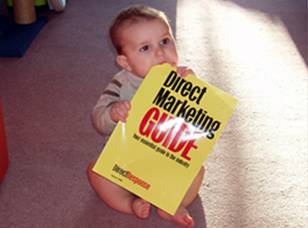 Large business concerns, such as Nestle, will have a corporate plan and into that will fit the objectives of the smaller companies, which operate within the group. These might be divisions, such as those of the large brewery chains, which make beer, operate pubs and run other leisure businesses. Each division or subsidiary will have its plans for delivering what the parent, or 'corporate' business wants it to achieve. The marketing plan will detail individual marketing activities or strategic mix, which are designed to put those strategies into practice.
Large business concerns, such as Nestle, will have a corporate plan and into that will fit the objectives of the smaller companies, which operate within the group. These might be divisions, such as those of the large brewery chains, which make beer, operate pubs and run other leisure businesses. Each division or subsidiary will have its plans for delivering what the parent, or 'corporate' business wants it to achieve. The marketing plan will detail individual marketing activities or strategic mix, which are designed to put those strategies into practice.
A common method used to describe the elements of a marketing plan is the acronym AOSTC, which stands for:
Analysis: A situational analysis (SWOT) examining the firm's current position.
Objectives: Setting SMART objectives for the future - where the business is going.
Strategies: For achieving the objectives e.g. segmentation, targeting and positioning.
Tactics: Setting and application of the marketing mix.
Control: Using benchmarks and budgets to monitor performance.
In preparing its marketing plan, the management is likely to move through the following stages:
-
Where is the business now? An assessment of its present position
The management conducts a situational audit using SWOT analysis. This examines internal factors, controllable by the firm, by grouping its strengths and weaknesses. Then they examine external (PEST) factors, which influence the firm by creating opportunities or threats. -
Where is the business aiming to be in the future?
 Using the SWOT and relevant market research, the management will set SMART marketing objectives for business, such as targeting new customers and markets or gaining greater market share. Objectives need to be:
Using the SWOT and relevant market research, the management will set SMART marketing objectives for business, such as targeting new customers and markets or gaining greater market share. Objectives need to be:
- Specific
- Measurable
- Agreed
- Realistic
- Time-bonded
-
How will the business achieve its objectives?
The firm develops marketingstrategies outlining how it will 'deliver' day-to-day on the objectives. These are the firm's operational or tactical plans. The focus may be on increasing market share, or moving into new segments of current markets. In essence, this is the detail behind the 4 Ps of marketing mix. -
What are the revenues and costs generated in pursuit of its marketing objectives?
The firm will need to set detailed budgets showing a breakdown of expected revenues and costs by product, department or marketing activity. -
How will the marketing process be controlled?
The management will develop control mechanisms to measure marketing performance against forecast budgets and marketing objectives such as market share. The firm will conduct periodic marketing audits to ensure it is meeting the changing needs of its customers and if necessary marketing objectives may be revised to meet changing market conditions.
Benefits from planning
Businesses are seldom static organisations and they operate in quickly changing market places. A visible and widely agreed plan acts as a focus for the business.
Good planning helps the firm:
- ensure that marketing activity is focused on corporate objectives
- take advantage of market opportunities and to address business threats
- co-ordinate marketing activities and monitor how individual business functions are contributing to the success of the marketing plan
- provide employees with a 'sense of direction' which tends to improve morale and performance, which can have a considerable effect on the ability of the business to hit targets and maintain profitability
- react to changing environments and unexpected events
- reflect on stakeholder interests and identify how their aspirations will be met
- encourages a rational approach to making marketing decisions
Reviewing the marketing plan
Regular evaluation of the marketing plan is essential and criteria need to be set to provide formal assessment of progress. These will include analysis of:
- sales performance - this can be against product line, range, area or whatever other grouping the company wishes to use.
- market share - has it grown, if so by how much and what has happened to our rivals?
- profitability - are revenues and costs as forecast?
- customer reactions - are products satisfying customer needs?
All good marketing plans have a degree of flexibility. Changes in consumer tastes, economic and market conditions and competitor reactions all have to be incorporated into a revised marketing plan.
In recent times, certain management gurus or thinkers have begun to suggest that formalised planning is not always appropriate and indeed can be counter-productive.
Disadvantages of formalised marketing plans:
- They form a complex process which slows decision making
- They are time consuming and therefore costly to construct and follow
- They are not well suited to dynamic markets as there is a loss of flexibility in reacting to sudden change
- They can tend to become an end in themselves
Management writers such as Henry Mintzberg and Tom Peters have suggested that a more organic approach is necessary when firms operate in markets at the cutting edge of technology and must react quickly to changing environments. They believe that, in these circumstances, strategy emerges rather than being systematically formulated.

You can read about their ideas on their personal websites at:

1 |
Marketing planWhich of the following would not feature in a marketing plan? |
2 |
Competitor strategiesWhy would noting competitor strategies be important for a business? |
3 |
Predicting the futureWhy might a business want to make accurate predictions about future events? |
4.1 The role of marketing - questions
In this section are a series of questions on the topic - The role of marketing. The questions may include various types of questions. For example:
- Self-test questions - on-screen questions that give immediate marking and feedback
- Short-answer questions - a series of short-answer questions to help you check your understanding of the topic
- Case study - a case study with associated questions
- In the news - questions based around a topical business news article
Craving coffee - the coffee market
The news
 What is a market?
What is a market?
Coffee is the second largest US import after oil, and the US consumes one-fifth of the entire world's coffee, making it the largest consumer in the world. This means that coffee growers across the world fight for a slice of this huge market. They have to compete on both price and the quality of their beans. The power of the big producers of instant coffees means that the growers have to accept what they offer. A evening spent watching commercial television will show any of us just how much money firms such as Nescafe spend on building and cementing their market share. Different types of coffee e.g. Costa Rica Rich Roasted, cater for the different segments within the overall market. But in recent years a growing number of consumers have become aware that some farmers receive a low price for their crop.
A new wave of coffee is emerging to cater to our cravings for justice as much as it does our cravings for caffeine. The Fair Trade certification mark has been developed to assure consumers that the coffee we drink was purchased under Fair Trade conditions. To become Fair Trade certified, an importer must meet stringent international criteria; paying a minimum price per pound, providing much needed credit to farmers, and providing technical assistance such as help making the transition to organic farming. Fair Trade for coffee farmers means community development, health, education, and environmental stewardship.
Oxfam, the British charity has asked the four largest buyers of coffee, which includes Nescafe, to buy up 5 million surplus tons that exists in global markets. This will allow the price to drift upward, so increasing incomes of the poorest farmers. In an interesting and related change of policy Nescafe are now producing sachets of coffee in the Ivory Coast and then importing these to the European Union. They are using the 'special' relationship France has with its former colonial territories to import coffee to the EU.
The theory
To those of you who are new to business studies you may not realise just where markets exist and the complexities that lie within them. You might not have given any thought to coffee and how it reaches your breakfast table. Well, as you can see it's a complicated process and one, which causes concern for certain pressure groups. Follow the links below to look at theoretical topics related to 'markets'.
What is a market?
Market size

Questions
- Identify two ways in which companies such as Nescafe segment the coffee market.
- Explain why the writer of the article feels that it is interesting to note that Nescafe is now producing instant coffee in the Ivory Coast, West Africa.
- Outline some of the ways in which the main coffee manufacturers could expand the size of their market.
Evaluate the probable consequences for coffee manufacturers of the growing awareness amongst consumers of the need for coffee growers to receive a 'fair' price for their output.
Suggested answers
Paying more to do good?
Read the article Virtue for sale (you can do this in the window below or follow the previous link to read the article in a separate window) and then consider answers to the questions below.

Question 1
Define the term 'asset-led marketing'.
Question 2
Explain how Ben and Jerry's use asset-led marketing as part of their overall marketing strategy.
Question 3
Analyse why people are prepared to pay more for goods that they consider to be produced in a more socially responsible manner.
Question 4
Discuss how companies can use a socially responsible approach to business to position themselves differently in the market.
4.2 Marketing Planning - notes
In the previous section we looked at the role, definition and nature of marketing. We now move on to look marketing planning with particular emphasis on the marketing mix, marketing objectives, positioning and market research.

By the end of this section you should be able to:
- Apply the elements of the marketing mix to given situations
- Discuss the effectiveness of a selected marketing mix in achieving marketing objectives
- Construct an appropriate marketing mix for a particular product or firm
- Discuss the ethical issues of what is marketed and how it is marketed: nationally, internationally and across cultures
- Explain the values of a marketing audit as a business tool
- Examine how appropriate the marketing objectives are in achieving the goals of an organisation
- Analyse the role of market research
- Evaluate different methods of market research
- Analyse the usefulness of market segmentation and consumer profiles
- Identify possible target markets
- Apply an appropriate marketing mix to the target market(s)
- Construct a position map from given information
- Discuss how organisations can differentiate themselves and their products from competitors
- Design or evaluate marketing strategies for given situations. Apply an appropriate marketing mix to the strategy

- Discuss the effectiveness of a selected marketing mix in achieving strategic objectives
- Apply Porter's five forces model to classify and analyse competitive pressures in the marketplace
- Evaluate different methods of sampling, for example, quota, random, stratified, cluster and snowballing
- Develop and evaluate strategies designed to change customer perceptions
Marketing planning

Marketing planning
Marketing planning is simply a logical sequence and series of activities leading to the setting of marketing objectives and the formulation of plans for achieving them.
Malcolm McDonald
The marketing mix

Marketing Mix:
The marketing mix is the mix of controllable marketing variables that the firm uses to pursue the desired level of sales in the target market. The marketing mix elements of price, product, promotion, and place (or distribution) are the basic, tactical components of a marketing plan.
When preparing a meal or dish, most cooks tend to use a recipe. This lists all the ingredients and quantities required to produce a successful and tasty dish. These ingredients are mixed to produce the final product. As all amateur cooks know, changing any of the ingredients or their quantities may produce a very different looking and/or tasting dish! This analogy applies well to the 'ingredients' of the marketing mix.
The term "marketing mix" was first used in 1953 when Neil Borden, in his American Marketing Association presidential address, took the recipe idea one step further and coined the term "marketing mix". The prominent marketer, E. Jerome McCarthy, proposed a 4 P classification in 1960. The four Ps concept is featured in almost all marketing textbooks and classes.
If you would prefer to view this interaction in a new web window, then please follow the link below:

We examined these additional Ps in an earlier section when we compared the marketing of goods and services.
We go on to look at all these Ps in more detail in subsequent sections.

A word of warning: Examiners seldom ask questions that want just a simple list of the famous four; it's more how you relate them to the specific product or market featured in the question, so read on!
The Total Product Concept
If you would prefer to view this interaction in a new web window, then please follow the link below:
Ethics of marketing
Ethical behaviour by businesses was a major focus for change in the 1990s, with increasing concern about the impact of business behaviour on the environment and a growing recognition about the rights of stakeholder groups. The role of marketing today must be seen in terms of connecting with stakeholders not only in terms of value, but in terms of values. Market value is measured not just in terms of sales but in terms of intangible assets and corporate reputation; hence the need to focus on ethical issues more than ever before.
It must be recognised, however, that the concept of ethical behaviour is both subjective and cultural. The norms and values of individuals differ, often as represented by political parties. Types of marketing acceptable in one country may break the cultural, social or religious norms of another. All we can say as business students is that the law makes some activities illegal. There are many other activities in that 'grey area', where some of the population regard them as unethical and others do not. We would place issues of drugs (alcohol and smoking) and pornography in this category. However, it is also true to say that the building of roads or the broadcasting of 'violent' cartoons are considered unethical by many, even if these groups may not want these activities to be made illegal.
In terms of the marketing function, firms need to consider the following key ethical issues:
- To what extent should firms create demand for products and services, rather than just satisfying established needs and wants? Linked to this is the marketing of products and services to children or other vulnerable groups.
- To what extent should marketing create unrealistic aspirations and focus on individual concerns and fears through advertising? Should, for instance, private health care companies raise fears about possible life threatening illness to sell their services?
- To what extent should firms market products and services that are dangerous, immoral or a risk to health, even though the sale of the products themselves are legal. Cigarette marketing has been a particular focus with, advertising being banned in many countries. Other issues relate to the legalisation of drugs such as cannabis, and to the sales of replica firearms.
Advertising has often been regarded as the 'secret persuader'; encouraging consumers to purchase products they do not need. This approach perhaps underplays the intelligence of the consumer and ignores the fact that there is now enormous choice in virtually all markets. However, which one of us can claim we have never been influenced by a marketing message to purchase one product in preference to another or, even worse, to buy an item we do not need and regret buying almost as soon as we get home!
It could be argued that consumers are not easily manipulated, and that rather than create demand, firms are merely anticipating demand in line with the definition by the Institute of Marketing. The fact that sales of the marketed product, increase in response to advertising, merely supports their recognition of a need by the firm.
There is much debate about adverts that promote unhealthy habits such as smoking and drinking. Most committed smokers recognise the dangers of their habit even if they choose to ignore the warnings. However, there are ethical issues around the marketing of national lotteries that can build gambling addictions, or the offers of financial services which make the creation of unsustainable debt a problem? The debate here is less clear-cut.
It is often easier to be ethical in times of boom rather than in times of recession. When firms are performing well, terms and conditions for employees may improve and the firm will be able to deal in a responsible manner with the community and with their suppliers, whilst providing a reliable and good value product for customers. What happens when competitive pressures increase and profits fall? Should the firm immediately look for cost reductions through downsizing or seek deeper discounts from their supplier when they know this will cause individual distress and commercial failures?

In most developed countries there are agencies which examine the ethics of firms, the nature of their products and the promotion tactics employed.
For examples claims featured in marketing materials have to be 'fair and accurate'. In 2009, the US Food & Drug Administration (FDA) investigated Cheerios manufacturer General Mills' claim that the cereal could reduce bad cholesterol by an average of 4% in six weeks. In another example, Yakult and Actimel both withdrew health claims about their drinks before the European Food Safety Authority (EFSA) could start investigations into their scientific authenticity.
 In recent years, 'Photoshop' or the airbrushing of images has grown in importance and use in the production of marketing materials. The techniques are intended to enhance the product or service or to change the nature of the people or models used. This has led to complaints about misrepresentation. The typical 'before' and 'after' shots, such as those used by dietary products, are often airbrushed. One example was an advertisement featuring 'Twiggy' using an eye shadow product which was deemed to be misleading by The Advertising Standards Authority (ASA), because the image of Twiggy had been digitally enhanced and therefore gave a misleading impression of what the product could achieve.
In recent years, 'Photoshop' or the airbrushing of images has grown in importance and use in the production of marketing materials. The techniques are intended to enhance the product or service or to change the nature of the people or models used. This has led to complaints about misrepresentation. The typical 'before' and 'after' shots, such as those used by dietary products, are often airbrushed. One example was an advertisement featuring 'Twiggy' using an eye shadow product which was deemed to be misleading by The Advertising Standards Authority (ASA), because the image of Twiggy had been digitally enhanced and therefore gave a misleading impression of what the product could achieve.
Photoshop is not without its problems though and there are several sites which concentrate on Photoshop disasters. One such site can be found here.
It has been recognised that an ethical stance can provide competitive advantage in the market place. Many firms now include an ethical approach in their Mission Statement or corporate aims and objectives. Some firms produce a separate document outlining their corporate and social responsibilities. Firms like S.C. Johnson in the United States and Ikea in Sweden base their activities within an ethical framework, and are very profitable.
The question is whether consumers believe a firm is truly ethical and buy more of their products as a consequence, or whether they regard the ethical message as a cynical ploy to differentiate their business. For an individual firm this perception is important. However, in the larger picture, a more responsible attitude across an entire industry, cynical or not, should benefit all of us in the long run.

Activity
You may wish to visit the following company websites sites to read about their ethical stances and their socially responsible actions and behaviour.
After visiting these sites, ask yourself whether you trust these firms more having read about their beliefs and values. Would you be more willing to purchase products from them as a result?

In most countries there will be an authority whose responsibility it is to monitor adverts and check for offensive, abusive or misleading adverts.
The Advertising Standards Authority (ASA) is the UK's independent regulator of advertising across all media, including TV, internet, sales promotions and direct marketing. Their role is to ensure ads are 'legal, decent, honest and truthful' by applying the Advertising Codes. Why not have a browse around the ASA web site to see the sort of complaints they consider.
The ASA remit has expanded recently to consider online and social media advertising. Read the following articles on the expansion of the ASA's powers (you can do this in the window below or follow the previous link to read the article in a separate window).
You can read ASA rulings on complaints to the ASA on adverts at Stansted airport and television advertisement for BT using the following links:
The table below shows the advertisements that provoked the most complaints to the ASA in 2009 and the ASA judgement on each.
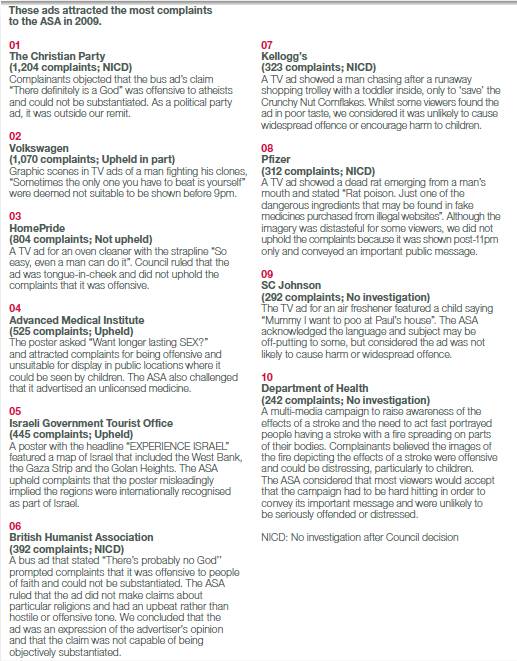
Marketing audit
As we have seen, the development of a marketing plan means looking at a number of crucial questions:
- Where are we now? An assessment of the current business position.
- Where do we want to be in the future? This means looking at the business objectives to see where we want to take the business and ensuring that these tie in with the overall corporate objectives.
- How do we achieve these objectives? The business needs to develop the marketing strategies to ensure that they achieve their objectives.
The marketing audit is the way in which businesses answer the first of these questions - where are we now? It is a fundamental part of the marketing planning process and is conducted not only at the beginning of the process, but also at a series of points during the implementation of the plan. The marketing audit considers both internal and external influences on marketing planning, as well as a review of the plan itself.
The marketing audit has similarities to a financial audit in that it is a review or appraisal of existing marketing activities. It is an assessment of past and present performance as well as providing the basis for evaluating possible future courses of action.
The review can be conducted using a SWOT analysis. Figure 1 below is a reminder of the framework used for a SWOT analysis.

Figure 1 SWOT analysis framework
Remember that S and W are internal to the firm and O and T are external.
Firms have some control over the internal factors. An internal weakness, for example, may be a high perceived price. The firm can, if it wishes, reduce this price. A world recession lowering demand for all products is uncontrollable by the firm and is an external factor - in this case a threat.
1. External Factors
External factors can be divided into three groups
- economic environment
- competitive environment
- firm's market environment
Any change in these groups that impact on the firm by allowing it to compete where it previously could not, or diminishing the ability to compete should be included in the audit.
A. The Economic Environment - STEEPLE
| Social and Cultural | Changing demographics (e.g. population growth), lifestyles and cultural values |
|---|---|
| Technological | Communication technologies, internet, world wide web |
| Economic | Incomes, unemployment inflation, economic growth |
| Environmental | Changes in buying behaviour and consumer perception of firm's environmental credentials |
| Political | Government behaviour, tax changes, privatisation, etc |
| Legal | National and international laws - laws in countries where the firm operates |
| Ethics | The firms approach and treatment of its stakeholders |
B. Competitive Environment
The audit should include an assessment of some of the following external factors:
- Threat of new entrants
- Threat of substitute products
- Bargaining power of customers
- Bargaining power of suppliers
- Rivalry between existing competitors
- Key strengths and weaknesses of competitors
C. The Market Environment
The audit should include an assessment of some of the following external factors:
- Total market size, growth and trends
- The nature of the customer
- The perception of the firm's products and brands
- Market characteristics, growth and trends
- Distribution channels
2. Internal Factors
The audit should include an assessment of some of the following internal factors:
- The firm's marketing objectives and strategies
- Total sales split by area, customer, product etc.
- Market share and market growth
- Existing gross and net profit margins
- Existing products and brands
- Fixed and variable costs
- Marketing research
- Effectiveness of marketing mix
A major consideration is the quality and quantity of resources available. This is sometimes categorised as the Five 'M's:
- MEN - Labour
- MONEY - Finance
- MACHINERY - Equipment
- MINUTES - Time
- MATERIALS - Factors of Production
An assessment will be made of the marketing team itself asking some of the following questions:
- How is our marketing team organised?
- How effective and efficient is our marketing team?
- What is the current state of New Product Development?
- How profitable is our product portfolio?
- Have we got our pricing at appropriate levels?
- How effective and efficient is distribution?
- How effective and efficient is our promotion?
Once produced, the marketing audit will help to inform the rest of the marketing plan; where do we want to be and are we going to get there?

Porter's five forces
One type of marketing analysis is to consider a market in terms of certain forces that influence how competitive it is for the businesses within it, or for those hoping to enter it. One strategic framework for conducting this analysis is Michael Porter's five forces model. This model has similarities with other tools for environmental audits, such as PEST analysis. However, Porter's model tends to focus more on the single business or SBU (Strategic Business Unit) rather than on a single product or range of products. For example, General Electric might analyse the market for Consumer Electronics or Healthcare as it has SBUs in both.
If you would prefer to view this interaction in a new web window, then please follow the link below:

When deciding on strategy, the five forces are an important part of the decision-making process. Using the analysis, firms should set a strategy to reduce threats from substitutes and new entrants and to reduce the power of buyers and sellers. Some of these possibilities should be included in an examination answer.
In addition when answer an examination questions you should not only consider the strength of each of these forces (quantify the strengths if possible), but also offer conclusions on how attractive the market is.

Porter's five forces - activities


Group Activity
Work in groups of about 3 to 4 and complete the following activities:
1. For a manufacturer of e-book readers, place the following eight points onto the five
forces model:
- Start-up costs are high
- Students have easy, and cheap, access to books: online videos and paper-based learning materials
- Smartphone manufacturers are investing heavily in improved touch screens and e-reader software
- Price comparison websites have increased in number
- Another e-reader manufacturer has signed an exclusive deal with a publishing company
- Two suppliers of e-reader chips have merged
- Encouraged by government subsidies and support, colleges and universities are adapting their resources for e-readers
- Government legislation in the US and Europe encourages capital investment in new technologies by offering subsidies and tax-breaks to new set-ups.
2. Develop marketing strategies for the e-book reader manufacturer to improve its
competitive position in the e-reader market.

1 |
Porter's five forcesWhich of the following is the force that is influenced by the others in Porter's five forces? |

Marketing objectives

Marketing objectives
Marketing objectives are the firm's defined and measurable aims for a given period. As with any other form of objective they must support the overall corporate objectives.
Marketing objectives
Marketing objectives, as with other objectives, need to be achievable and realistic. They will be based on an analysis of the marketing audit that has taken place. This, along with the corporate objectives will help the firm identify which products should be sold in which markets. From the identification of marketing objectives, the firm can then develop a marketing strategy. This will determine how they achieve these objectives. It is important not to confuse marketing objectives and marketing strategy.
Let's look a little deeper into what makes up the marketing objectives. Remember they are the long-term marketing goals of the organisation. Normally, they focus on the following:
- Market size and share - to increase market share or sales.
- Position in market - to focus on a particular section (segment) of the market and note its characteristics.
- Product range and innovation - to introduce new products to the range.
- Developing brand loyalty - to develop ways of gaining customer loyalty and repeat purchases.
- Aiming to survive to build a customer base that is big enough to make the business secure.
- Widening product appeal - to move into new sections (segments) of existing markets or enter new markets.
- Corporate image - to use marketing to convey a certain corporate image. For example, the firm may stress the ethical nature of the business or a degree of environmental responsibility.
- Diversification - developing new products in new markets.
Market leadership and competitive advantage
A key objective may be to become market leader i.e. the largest single player in the market. If the firm is the market leader, then they can determine the pace and direction of the market and act as the benchmark against which others view their products. The firm can then aim to expand the market and as a result increase their share of the market. This will be built into competitive advantage, which is a combination of the following:
- Selling what is considered to be the best product in the market.
- Providing features that competitor products do not possess.
- Being able to gain maximum advantages of economies of scale, so operating at the least cost point. It is now widely accepted that, in some markets, a certain critical mass is needed in order to be competitive.
- Being protected by good patents onour products and other legal devices, such as copyrights on our ideas.
- Having excellent market information to provide a basis for future marketing actions and control of markets. This allows us to be proactive to gain 'first mover advantage', by being the first to sell a product or service that customers want.
Few products can enjoy the luxury of being market leaders. Most products will be in the category known as challengers. These will adopt strategies that aim to increase market share:
- Setting aggressive pricing strategies.
- Being innovative.
- Aiming to push quality and let this be known.
- Improving and developing distribution channels.
- Hitting hard with advertising.
- Getting into new markets.
The remaining category contains the market followers. These tend to select what they do well and follow based on the market success of others. They may come later into the market with 'me-too' products. These often are refined versions of existing products, sold at lower prices as the price does not need to cover high research and development costs.
Setting marketing objectives does not mean they will be achieved, especially if the market is dynamic. External and internal factors may constrain performance:
External constraints
- Competitor behaviour - competitors may amend their marketing mix and/or develop new products.
- Changing economic conditions - these may be positive or negative for the firm depending on what it produces. For example, low priced goods may do well in a recession, whereas demand for luxury items is likely to fall.
- Tastes and fashions - Fashion items are transitory and tastes can change dramatically in the short term. This may be the result of some good or bad news story or simply because the market believes it is time for a change.
- New governments will come into power with their own agenda. This is likely to be supported through spending plans and supporting legislation. Cuts in public spending can have significant effects on suppliers in the market, especially in developed countries where the public sector represents a high proportion of national income.
Internal constraints
- Finance - marketing plans are normally expensive. These funds are generated from sales revenue for the most part, so any fall in demand will negatively affect the marketing budget.
- Human resources - labour turnover may reduce the skills base of a business which will affect levels of service and quality. Recruitment and training are expensive and time consuming and this may reduce the ability of the firm to meet its marketing objectives.
- Costs - unexpected increases in energy and material costs will affect the marketing mix, in particular price.
Markets are unpredictable and no business can predict the future. There will always be risk, but what firms will seek to do is to reduce that risk, by increasing knowledge. One way of minimising risk is through effective market research.
Market research - introduction
Marketing is about providing the consumer with the products and services that they want now and in the future. Marketing involves the provision of information, and the persuasion of the consumer to act. It also involves the collection and analysis of information, particularly about the market in which the firm is operating. Market research looks at:
- The products and services of the business.
- The products and services of the competition.
- The desires and wants of actual and potential consumers, now and in the future.
- The state of the market and the economy, now and in the future.
The purpose of market research is to reduce risk by providing appropriate data to support market planning. Effective planning reduces the likelihood of unwanted products being launched into a market. The main tools of market research are based on data gathering and analysis.
Market research can be expensive, so the firm hopes it is cost effective by positively influencing sales and the 'bottom line'. However, markets and economies are dynamic and external environments volatile. Inevitably some predictions about the consumer behaviour and economic performance may prove to be inaccurate even if well funded and conducted by respected professionals.
The results of market research are available to the whole company, but are particularly useful for the marketing department. A firm does not have to do its own market research; it can use external market research firms that specialise in doing work under contract. They are often part of, or associated with advertising agencies.
The role of market research
What is market research?
We noted in an earlier section that the market-orientated firm bases it business operations on the need anticipate and then satisfy changes in customer demand. Market research concerns the present and future demand for products. It is the means used by firms to keep in touch with the needs and wants of those who want to buy and use their goods and services.

Market research
Market research is defined as 'the systematic and objective collection of forms of information that allows trends in market behaviour to be identified and predicted'. In other words it is the process by which firms find out market information, note its relevance and decide how to act upon it.

Marketing research
Marketing research is a broader term than market research as it includes research into the effectiveness of the firm's marketing strategy as well as market research.
Market research can be 'ad hoc' in that it is conducted when it is required, such as following a product launch, or 'continuous', when information is required on a regular and ongoing basis. Governments, for example, collect data on buying habits of the general public to allow them to identify 'the representative basket of good' used in the calculation of inflation; broadcasters will collect listener or viewer details which they can use to attract advertisers and schools will collect data on attendance for the education authorities.
High quality market research will not guarantee corporate success, but it will be an important part of the information gathering process that assists those having to make strategic decisions. The quality of the statistical analysis and evaluation relies on the quality of the data collected; 'garbage in, garbage out' is never more true than in market research.
The purpose of market research
Market research provides the firm data on:
- current market performance and predictions of future market trends
- customer purchasing behaviour e.g. where and how often they buy and in what quantities
- levels of current satisfaction with existing products
- customer response to planned products and services
- existing and future needs of its target market
- required changes to elements of its marketing mix, especially in light of competitors marketing activities
- information on the local, national and global economy
In particular the firm will seek information on the following:
The market and the customer
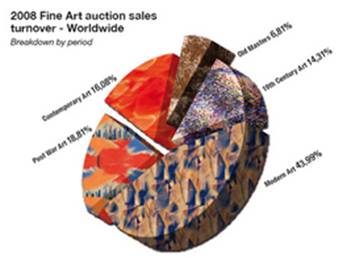 The firm will want to establish:
The firm will want to establish:
- The size of the total market and/or whether it is growing or contracting.
- The geography of the market e.g. certain countries present problems that are not applicable elsewhere.
- What customers want, so it can build customer profiles.
- Where future markets might be and information about these.
- How customer perceive our current products in terms of price, quality and value.
- Whether customers are likely to buy new product offerings and the frequency of purchase.
- Price and income sensitivity (elasticity) within the marketplace.
The product
The firm needs to know:
- The possibility of extending and expanding the current product range.
- How customers view product pricing, quality, design and packaging.
- Where new markets are likely to emerge and whether the firm has existing products to serve these or will need to develop new ones.
- The strength and reputation of its brand.
The economy
The firm needs information on:
- Existing, and forecast, data on inflation, unemployment and economic growth.
- Potential government macroeconomic policies, such as tax and interest rate changes, to address economic problems.
- predictions about future economic.
- For a multinational organisation this data may be required at a local, national and international level. They will have particular regard to the countries where they trade.
The firm's competitors
The firm will want information on:
- Competitors' products and prices. Employees from rival retail outlets, such as supermarkets, frequently check out prices, and products of their competitors. This market intelligence forms the basis for the stocking or otherwise of certain product ranges and pricing levels for individual products or product groups.
- Why customers choose to shop in one store as opposed to another and, in particular, how they can be persuaded them to shop in its stores.
- Which firms have the highest market share and why?
- What unique selling points do the firm's rivals have and why?
- What weaknesses do competitors have and how might the firm take advantage of these to gain market share?
Costs and benefits of market research
The purpose of market research should reduce the number of bad product decisions and as a consequence, minimise the risk of failure. It should increase company profits and help pinpoints strategies for increasing the reputation of the firm. However, the costs and benefits of market research involve a complex balancing of factors and is an area in the business and management syllabus that requires particular analytical and evaluative skills.
- Market research is expensive and time consuming. However, the less a firm does, the greater the risk involved as the less it will know about its market.
- Marketing research must be cost effective - the cost should be less than the gain. However, how are costs and returns actually measured? To what extent can the firm create a direct link between a particular piece of research and the success or failure of its marketing operations?
- To what extent can the firm trust its findings and reduce the problems of bias? It is often cheaper to use data produced by other organisations, but how reliable is this?
Primary and secondary research
Marketing information is widely available from a variety of sources both inside (internal) and outside (external) the firm. Sources of historical data can be classified as being:
- Private to the firm itself - the firm's own records. Its own sales records etc.
- Externally purchased or private data - market research firms will do surveys and will provide allow access for a fee. This may be more cost-effective than the firm conducting its own research.
- External public domain information - government provided information about the economy. Publications of the National Statistical Office etc. Much of this information is free of charge.
Research can be classified as:
- primary or secondary
- qualitative or quantitative

Primary research
Primary research is the gathering of new or 'first-hand' data specifically tailored to provide information on the firm's own products, customers and markets. Data is collected by fieldwork such as questionnaires, observation, experimentation and surveys and, as a result, is often expensive, but also directly relevant, accurate and up-to-date.
Primary data can be collected from internal or external sources. The firm can interview its own employees or it may collect external data through questionnaires and surveys.

Secondary research
Secondary research, also known as desk research is the assembly, collation and analysis of existing or 'second-hand' marketing data. This process is cheaper than primary research, but the data may be less relevant as it was not collected for the specific needs of the firm and may already be out of date.
There is an immediate and obvious clash here between the two types of market research - cost versus time and accuracy!
Secondary data may be collected from some of the following existing sources:
- Internal: annual reports, sales data, customer records and survey, client databases, payment records.
- External: government data, national and local media, competitor reports, reports of marketing research companies, trade association data and reports, company websites
The following summarises the advantages and disadvantages of secondary data in comparison to primary data
| Advantages of secondary data | Disadvantages of secondary data |
|---|---|
| Quicker and cheaper to collect and analyse | Quickly out-of-date |
| Wide range of potential sources | Available to competitors |
| Provides data on the whole industry and/or economy rather than focused on the firm | Not specific to the needs of the firm and may not be in the format required for analysis |

Qualitative research
Qualitative research is in-depth research into the motivations behind customer purchasing behaviour and attitudes, providing information on preferences, tastes, and buying habits. Information is gathered through the use of detailed and often lengthy research methods often involving the use of discussion, or 'focus', groups.

Quantitative research
Quantitative research concentrates on statistics and other numerical data such as market share, gathered through opinion polls and customer surveys.
Qualitative research asks 'why' customers buy and elicits their opinions - it can provide information of the strength of demand and on feelings. However, this type of information is difficult to present in a succinct form. Quantitative research asks questions about magnitude relating to who buys the product and how much they buy. This kind of data is much easier to graph and present visually.
So, as we can see the information for market research can be gathered by examining existing data, or going out and collecting new data. The two main methods for market research are defined as:
- Desk research - working in house or in the office, using existing, 'secondary', data. Gathering the information can be quick and inexpensive because the data already exists, but may be imprecise, inaccurate, out-of-date and not focused on the specific need of the firm. Desk research can be useful for screening or 'first evaluation' of a proposal simply, because it is quick and cheap.
- Field research - going out into the market, in one form or another, and collecting new, relevant information. It will be slower than desk research, and more expensive, but it should be far more accurate and directly relevant. It can often fill in the gaps left by desk research.
The firm is faced with a trade-off between cost and accuracy. The choice may be determined by the firm's budget and/or the nature and size of the financial risks involved. Larger firms with significant research budgets will clearly be at an advantage over smaller firms. Most large firms are likely to use a combination of primary and secondary research.

1 |
2 |
Types of market research dataMatch the description below to the appropriate data type. |
Primary research - information gathering techniques
If you would prefer to view this interaction in a new web window, then please follow the link below:
The need for accuracy will probably play a large part in deciding which method to use, as well as time, cost, the data required and the personnel available to gather the information. Primary research gathering tends to be time consuming, but as most researchers will say - "you get what you pay for." In deciding the nature of the research, the marketing team will need to address is whether the benefit of research outweighs the cost or vice versa. This will be influenced by some of the questions posed below. Follow each question link to see more detail.
Which research techniques should be used?
How can the firm make use of the data?
How can the firm act on the findings?
Observations - case studies

The following is a of computer visualisation of consumer movements around an IKEA store:


Examining how people 'observe' online is much more difficult than observing physical human behaviour, but increasingly important as most firms now have an online presence. Market research organisations are developing more and more sophisticated ways of tracking consumers' online behaviours. Many consumer groups believe that much of this research is an unnecessary, and/or unacceptable intrusion, into consumers' private lives and there should be stricter controls on what is perceived as a breach of privacy. Certainly downloading tracking 'cookies' , as spyware, onto private computers is morally dubious, but a frequently performed activity.
Alternatively, it is possible to get customers to agree in advance to tracking behaviour, especially if a fee is involved. ACNielsen is a US global marketing research firm operating in more than 100 countries, which provides marketers with research data on the impact of their marketing and sales programmes. The company is well known for its Nielsen ratings, which measure television, radio and newspaper audiences in their respective media markets. In 1950s Neilsen began to attach recording devices to a statistical sample of about 1200 consumer television sets in the U.S, These devices recorded the channels and programmes viewed by the consumer and thus determine audience size. Later they developed electronic methods of data collection and transmission.
In 1996, ACNielsen set up a separate market research company called Nielsen Media Research (NMR), which has recently developed online tracking techniques to produce campaign ratings as explained in the following video, which you can also open in a separate window.

If you have not done so before, try downloading a spyware removal programme on your personal computer, such as Spybot - Search and Destroy, and run it to see if your computer is harbouring spyware - you may be surprised!

Examples of spyware found on a computer.
Group-based market research
 Group based research is popular with advertising agencies, who present the group with a variety of adverts and marketing messages to see which have greatest and most favourable impact. They may also use focus groups to monitor changes in public attitudes, opinions and tastes. These groups are now also popular with political parties. The focus group might only be called together for a short time or for a series of meetings. Participants are introduced to a general area of concern, such as 'organic foods' and then the discussion is' focused down' to the issue the researcher really wants to know about. What are your impressions of our new organic vegetable range?
Group based research is popular with advertising agencies, who present the group with a variety of adverts and marketing messages to see which have greatest and most favourable impact. They may also use focus groups to monitor changes in public attitudes, opinions and tastes. These groups are now also popular with political parties. The focus group might only be called together for a short time or for a series of meetings. Participants are introduced to a general area of concern, such as 'organic foods' and then the discussion is' focused down' to the issue the researcher really wants to know about. What are your impressions of our new organic vegetable range?
A long-term method for following swings in public opinions, tastes and fashion is to form a tracking group. The personnel of these remain the same for quite a long period of time and so their opinions can be 'tracked' over some period of time and changes noted. Food producers use these quite frequently, as the market is dynamic.
Market research - summary
In the last section we looked at all the different types of market research. The table below summarises these for reference. You should understand these - refer back to the previous page if you are not sure.
Follow the links in the tables to find out the advantages and disadvantages of each type:
Secondary/Desk research
| Internal sources | External sources |
|---|---|
| Competitor analysis | Company records and accounts (usually available from national company agency) |
| Internal databases of customer and customer information records | Trade reports - perhaps from trade association |
| Internal market assessment reports | Specialist publishers e.g. Mintel |
| Customer accounting records (payments etc) | Government departments and agencies |
| Retail audit data | |
| Advantages | Disadvantages |
Questionnaires
 Various forms of questionnaires exist and the style of questions normally dictates the type of research that emerges. You may need to construct one later in your course if you do a piece of coursework.
Various forms of questionnaires exist and the style of questions normally dictates the type of research that emerges. You may need to construct one later in your course if you do a piece of coursework.
Questionnaires can be conducted in a number of ways:
- Face-to-face - a researcher asks the questions. This allows the purpose to be fully explained and any problems in completing the questions addressed
- Self-completion - These often used at the end of a service. For instance, patients in a hospital may be asked about their treatment when they are discharged.
- Postal - these may follow the purchase of a product or a service provided in the home. It asks for feedback. Return rates are generally very low and the questionnaire often ends up in the bin, so firms often try to provide an incentive for completion, such as entry into a free draw, a discount on future purchases of some kind of voucher.
- Telephone - this is similar to a face-to-face questionnaire, except of course that the intended respondent can hang up!
- Internet - it is increasing practice for pop-ups to appear after placing an order or accessing particular websites.
Questionnaires can be structuredin that they rely mainly on closed questions with an occasional open, expanding style question or unstructured, which use more open questions.

Closed questions.
Closed questions have a limited number of preset answers, the most common of which is, 'Yes' or 'No'.
Questionnaires based on closed questions are popular as they are easy to quantify and turn into visual representations, such as graphs, which are easy to interpret. Structured questionnaires are easier and quicker to complete, but may not provide the same quality of information that unstructured questionnaires do, because they limit the responses and demand a specific answer. It is difficult to establish 'shades' of feeling. However, although opinions may be harder to detect, it is possible to record the strength of opinions by using techniques such as Likert scale responses. This provides a range of responses such as:
- Very good
- Good
- Satisfactory
- Poor
- Very poor
However, an open or unstructured approach will allow for a far greater range of response. Researchers can dig more deeply into issues and establish just why a person holds a particular opinion:
Closed question:
Do you buy this product? Yes or No √
Open question:
If 'No', please give your reasons:

However, the more open the questions the more difficult it becomes to classify responses. The results will become more subjective and therefore less easy to actually put into categories. Just imagine asking your friends what they wanted for school lunches. The response could be so varied and contain so many personal likes that the canteen could never produce such a range. Hence, in most school canteens the range is based on certain well-tried favourites.
Design of questionnaires
Before questionnaires are conducted, it is good practice to test a 'pilot' version. It is surprisingly difficult to prepare a questionnaire that is fully understood and collects the data required. This pilot allows for problems to be identified and questions removed or rephrased.
The design of a questionnaire is subject to some general principles:
- What are the key objectives - what information is required?
- Questions should be easy to understand and unambiguous and avoid industry jargon.
- Avoid asking two questions in one, e.g. 'do you own a car and is it a diesel?'
- Avoid 'leading' questions that encourage respondents into certain types of answer.
- Follow a logical sequence of questioning and limit the numbers of questions (a maximum of 15 is usually recommended in face-to-face questionnaires). Ask yourself how much time you would be willing to spend on a Saturday afternoon answering a a survey when you wanted to shop.
- Don't rely too much on respondents' memories.
- If offering a choice of responses, don't make one of them the obvious answer.
- Take care not to ask questions that are thought to be offensive.
- Keep to what the respondent knows.
- Put some 'control questions' in the design. These questions check for bias in both the way the researcher is asking the question and the answers they are receiving.
- Use a balance of open and closed questions.
Sampling

It is normally too costly and almost certainly impossible to ask everyone in the target population. So, firms have to sample a proportion of opinions.

Sample
A sample is a group that is selected for study which is representative of the total population for a given experiment. The study is normally conducted to understand how the population will react to an item by first testing it on a sample that represents the population that the item will target.
 It is important that answers given by the selected sample will reflect the whole populations' opinions as closely as possible. In research, the term 'population' is used to represent all the market, but for a major corporation it may the majority of the population of the country. Obviously, by asking fewer people the firm cut costs, save on time and resources. But the results may not be statistically significant. In other words, the firm cannot rely on the results representing the views of the entire target population. If it does not, any marketing decision based on the results may be flawed. For example, if you ask all your friends what they think about a television programme, their opinions may be similar, but are unlikely to be representative of older age groups.
It is important that answers given by the selected sample will reflect the whole populations' opinions as closely as possible. In research, the term 'population' is used to represent all the market, but for a major corporation it may the majority of the population of the country. Obviously, by asking fewer people the firm cut costs, save on time and resources. But the results may not be statistically significant. In other words, the firm cannot rely on the results representing the views of the entire target population. If it does not, any marketing decision based on the results may be flawed. For example, if you ask all your friends what they think about a television programme, their opinions may be similar, but are unlikely to be representative of older age groups.
Advantages of sampling
Sampling has a number of advantages over a full census of a population and these include:
- Saving time - sampling involves a lot less time than a full census and this will enable the firm to produce results faster and therefore react quicker to market trends
- Resources required are fewer - if less time is required then this will reduce the resources required to manage the sampling process
- More cost-effective - costs will be relatively lower when just a sample is taken
- A sample is more reliable as there is a concentration on fewer units

Methods of sampling - introduction

When designing a sample the firm needs to consider:
- The sample frame - a complete list of all people or households in the target population from which the sample is drawn.
- The sample size - the number of people to include in the survey
It is normally accepted that the larger the sample size as a proportion of the sample frame, the more likely it is to represent the characteristics of the total population. So, if a firm can afford a larger sample, it is likely to produce more reliable results. Once it has decided on the size of sample size, a method must be chosen to select the sample.

Let's consider an example of a market - a school. Assume that there are 2,000 pupils, 45% of which are boys. The age range is from 11 to 18, and there is an approximately even distribution of ages. The school is split into 7 year groups, again of approximately equal sizes. If we wish to do research here we will need to take samples.
Main methods of sampling
If you would prefer to view this interaction in a new web window, then please follow the link below:

A common student mistake...
Do not mix up random and convenience samples. Selecting the first ten people who enter a shop is not a random sample as every member of the population (potential customers) the firm is interested in does not have an equal chance of being selected - only those entering the shop stand a chance of being chosen. Indeed, those buying from this shop may have similar characteristics not shared by others in the sampling frame.
This mistake is often made by students in their internal assessments and extended essays when surveys are carried out. It is often written that:
'I chose the first ten people at random'.
This is not an accurate description of a random sample, but of a convenience sample.
Sample size
How many respondents should be in a sample? This is the realm of statistics, and it will be touched on later. The answer, though, is likely to be 'fewer than you think'. Political public opinion polls seeking voting intentions of several million voters are based on samples of approximately 1,000. They are also based on careful stratified sampling methods. They make predictions with claimed accuracy of about +/-2%. Not a bad accuracy for such a small sample.
How questions are phrased is critical to the accuracy of the results. The use of leading questions will clearly affect the survey's reliability. Questionnaires can be designed to get a specific result, so the developers need to be careful.
Methods of asking questions
There are many ways to conduct research as has been discussed earlier. These include:
- Unstructured interviews
- Structured interviews
- Questionnaire
- Telephone survey
- Consumer panels
- Focus group
The validity of the result will be determined by how many people are asked, how they are selected and the nature of the questions. We looked at many of these methods in the previous section.
Matching sampling method to population
It is important to match the sampling method used to the nature of the population being considered. If, like a school, the population is all in one place then the options are different to a situation where the population is geographically scattered (e.g. an online store of some sort). The table below summarises some of these options:
| Nature of population | Sampling methods available | Sampling methods not available |
|---|---|---|
|
|
|
|
|
|
|
|
|

Sampling errors

Two forms of error can creep in when samples are being prepared, and conclusions drawn from the results. These can be considered as bias and statistical.
-
 Bias - this is where external effects influence the result. The selection of who makes up the sample may be biased in favour of friends, for instance. The form of the questions may induce a particular answer, and so also introduce bias.
Bias - this is where external effects influence the result. The selection of who makes up the sample may be biased in favour of friends, for instance. The form of the questions may induce a particular answer, and so also introduce bias. - Statistical sampling error - even with no bias, there will be error. No two samples will give the same result (except by fluke.) Thus there will be random variations from sample to sample, and between sample and population. Sampling error is the combination of the 'within sample' error and the 'between sample and population' error. Luckily you will not have to work it out.
This is all summed up using confidence limits and standard error. The important thing to remember is that results will not be fully accurate using a sample. However, an estimate of the error or accuracy is possible knowing the sample size and the experimental method.
Is a sample reliable?
To be of use to a firm, results should reflect the intentions of the total population. This is quite an ambitious target. Sampling errors will almost certainly arise and we need to be aware of these. Most researchers accept that two types of error occur most regularly. These are those directly related to the sample and those, which are not.
Think carefully about you think could cause each of these types of error, and then follow the links below to compare your notes with ours.
Errors related to the sample
Errors not related to the sample

Market segmentation

Market segmentation
Market segmentation is the division of the market place into distinct subgroups or segments, each characterised by particular tastes and requiring a specific marketing mix.
The population of a country is not homogeneous; consisting of millions of individuals with different wants and needs. By dividing a market into segments it is easier for the firm to research the needs and wants of customers in a cost-effective manner and then to meet these in a targeted way. In short it is about a business 'knowing their customers'. Each segment will share certain characteristics, which bind them together while at the same time distinguishing them from other segments. Some segments may be quite small, e.g. specialist sports such as archery, so firms will be marketing to a niche market in this case, where the level of demand is limited.
Segmentation is the first stage of a three stage process:
![]()

Targeting
Targeting is the selection of potential customers to whom the firm wishes to sell products or services. The targeting strategy involves segmenting the market, choosing which segments of the market are appropriate, and determining the products that will be offered in each segment.
Targeting is used to develop a specific marketing mix for each distinct marketing mix. A business offering multiple products can determine if the various segments should receive one generic product (such as in mass marketing), or if each segment should receive a customized product (multi-segment), based upon the market's diversity, maturity, the level of competition and the volume of sales expected

Positioning
Positioning is the creation of a distinct image for a product or service in the minds of customers, both specifically to that item and in relation to competitive offerings.
Firms apply positioning strategies by emphasizing either the distinguishing features of their brand (what it is, what it does and how, etc.) or by creating a suitable image (inexpensive or premium, utilitarian or luxurious, entry-level or high-end) through relevant promotion. Once a brand is positioned in the eyes of its consumers, it is very difficult to reposition it without destroying its credibility.
Consumer Profiles
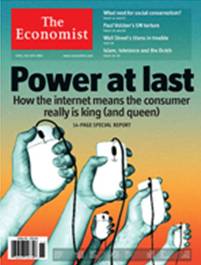 It is essential for firms to understand their target customer and be able to describe their characteristics. The marketing department should be able to develop consumer profiles for all their markets outlining of significant demographic and psychographic details about the users of a particular product. This will include details such as:
It is essential for firms to understand their target customer and be able to describe their characteristics. The marketing department should be able to develop consumer profiles for all their markets outlining of significant demographic and psychographic details about the users of a particular product. This will include details such as:
- where they live
- whether they are male or female or both
- what they do
- what their values are
- what they earn
- where they shop and how often and whether they are brand loyal
- how old they are
- whether they are likely to be married, single or have children
Consumer profiles will be different for each of a firm's target markets. This knowledge will help it meet the needs and wants of their customers. Media publishers, for example, will be able to provide potential advertisers with reader profiles, to help justify the placement of particular advertisements in certain periodicals, newspapers or magazines.

Investigation
The Economist, for instance, provides a clear and very detailed outline of their readership profile. Follow this link and then click on the 'demographics' tab to see what Economist readers are like and what they do, say and believe; across the world or in different continents.
As you go through the various screens, jot down some key facts and then develop a 200 to 300 word consumer profile of an Economics reader.
Types of segments
It would be possible to segment markets according to characteristics, which have no marketing value in the majority of cases; for example eye colour or those who have visited France in the last 6 months. However, if the purchasing behaviour of a segment is very distinctive, it will allow the firm to develop an appropriate marketing mix for that group. So, an important role of any marketing department is to segment their target population in a way that will support the firm's marketing strategy.
Market segmentation may be based on various characteristics:
- Demographics - the characteristics of human populations
- Pyschographics - attitudes, values, lifestyles, and opinions of consumers
- Geographics - where consumers live
Demographic segmentation
- Age - some products are not of interest to certain age groups, e.g. school materials
- Marital status - Married couples often have distinctly different purchasing behaviours to single consumers. This can relate to the car purchases such as holidays entertainment, financial products.
- Social class - this is a difficult term to define accurately, but is linked to education, tradition, income and parenting. Several countries have socio-economic groupings which are a useful 'shorthand' for marketers when drawing up marketing mixes.
- Education - the level of education will influence lifestyles, buying patterns and behaviours.
- Race and ethnicity - different races have different cultures, which influence their needs and wants. This is particularly noticeable in food and fashion products. Globalisation has dissipated these differences somewhat, with cultural exports such as American music creating a fusion of demand patterns in other parts of the world.
- Religion - this may be linked to race and ethnicity, but not always. Religious beliefs will influence buying behaviour such as foods, e.g Kosher and Halal foods
- Sexual orientation - as societies become more liberal in their attitudes to sexual preferences, so whole industries have developed to cater for groups such as 'gay' and 'lesbian' consumers. People in these group may have certain spending habits and a lifestyle that a business can identify and target.
- Gender - it is clear that males and females have distinctly different buying behaviours, especially in the areas of fashion and cosmetics. However, remember that males and females are not homogenous groups and will also be segmented by other features such as age, ethnicity, education, income etc.
- Language - this clearly affects the nature of products or services purchased. The IB, for example, offers papers in three languages: English, French and Spanish and is soon likely to be offering examinations in Chinese.
- Family lifecycle - marketers categorise households in terms of their stage in the family lifecycle, because purchasing behaviour is likely to be relatively homogeneous within each category, but different between categories:
- Single: young, no social ties
- Newly married: Young with no children
- Full nest (1): youngest child under six
- Full nest (2): youngest child over six
- Full nest (3): children still at home, but working
- Empty nest (1): Children have left home and one partner still working
- Empty nest (2): both partner retired
- Solitary survivor (1)- still at work
- Solitary survivor (2) - retired
One important way that is used by marketing firms is segmenting the market according to Socio-Economic Groups. Use Google, or another search engine to see if you can find out what these are. Once you have had a go, follow the previous link to see how your answer compares.
Psychographic segmentation
Psychographics is concerned with people's lifestyle, their attitudes, emotions, personality, drive and values. It is clearly an area where firms may turn to psychologists to offer advice. All segmentation attempts to produce groupings which firms can target with appropriate goods and services. However, marketers must be careful not to 'stereotype' by pandering to social classifications which have little basis in fact.
Behavioural characteristics might refer to how many times a customer buys a particular product or service during a period of time and how brand loyal they are.
Some products are almost entirely the domain of professionals and are sold to them and not to the general public e.g. medical equipment.
There are many lifestyle choices that will influence purchasing behaviour. One of the most significant areas of the last few years is environmentalism and the desire to lower one's carbon footprint. This lifestyle choice has produced a whole array of products choices such as organics and low energy innovations. Other lifestyle choices relate:
- concern for animals, have led to cosmetics retailers marketing that they their products have not been tested on animals
- sports and hobbies
- care for others - giving to charities or buying their products
- status goods e.g. yachts, jewellery and fast cars
- home entertainment - individuals who look to have the latest gadgets

The marketing industry enjoys producing acronyms or nicknames for behavioural groupings:
- Yuppies - Young Urban Professional
- Yummies - Young upwardly mobile
- Dinkies - Dual income, no kids
- Geeks - A person who is single-minded or accomplished in scientific or technical pursuits but is felt to be socially inept
- Tweenagers - A child between middle childhood and adolescence, usually between 8 and 12 years old, technically not a teenager (being less than thirteen years old), but starting to act like one
- Boy racers - people, usually males in their late teens or early twenties, who "cruise" around in vehicles modified with loud exhausts and stereos, and/or modified body kits
- Dimwit - Dual income mortgage we're in trouble
All of these terms are shorthand for groups of individuals with particular purchasing behaviours.
One interesting psychographic classification is based on attitudes and motivations with three distinct segments:
- Subsistence types - customers who select products and services on the basis of price, looking for value for money and bargains. They will seek out those reduced stickers in supermarkets!
- Discriminators - Customers who select products and services on the basis of quality rather than price, following the principle that 'you get what you pay for'.
- Hedonists - individuals who look for instant gratification and so will live for the 'now' rather than saving for the future. These are 'party types who will spend all (or sometimes more) than their income on enjoying themselves ... all the time! The rich may lead this lifestyle but lower income groups may do so by using credit.
A comprehensive list of humorous business acronyms, including marketing examples, can be found here.
Psychographic segmentation - case study

Case study
 A survey of driving behaviours in the UK produced two distinct categories of 'boy racers'.
A survey of driving behaviours in the UK produced two distinct categories of 'boy racers'.
"The first point of note is that within the 17-24.s, there are not one, but two groups of 'boy racers': Deathwish and Young & Reckless. These have quite distinctive and different psychographic profiles.
The report then went onto identify further potentially 'dangerous' groups linked to age and behaviour:
- Fast & Cocky (25-34)
- Fast & Invincible (35-50)
- Stress City (25-34)
- Fast & Far Away (17-24)
- Accidental Tourists (25-34)
- Mr & Mrs Average (35-50)
- Confident Steady Eddies
- Nervous Steady Eddies

Group Activity
In groups consider these segments and summarise what the typical person in these groups might look like, how they are likely to live their lives and what products and services might be suitable for them. From a 'social marketing point of view', what types of marketing could be offered to change some of these behaviours?
- Report back to the whole class on your findings
- Develop a marketing campaign based on your ideas to include adverts, posters, product details, distribution channels etc focused on two of these groups.
In most cases, these are what are called 'stereotypes'. The way we look at these groups might be simplified and exaggerated but they do serve to identify certain characteristics. These might be useful to a business looking to target particular markets.
Geographic segmentation
Geographic segmentation refers to where people live.
Obviously, different countries will have significantly different lifestyles, economies, cultures, languages, climates, traditions; all of which will significantly influence purchasing behaviours. For example, those living in colder countries will be more interested in warm clothing and heating appliances, whereas those in warmer climates would prefer air conditioning.
However, different regions of any country will also have different lifestyles, cultures, ethnic backgrounds, climates and traditions. Many countries can be divided into distinct geographic areas. Products and services that prove successful in one region may fail totally in another. Market research to establish geographic preferences is essential for large national and multinational producers and retailers.
In addition, buying behaviour will be influenced by the nature of the environment, whether it is urban or rural, high rise or suburban. Consumers who live in flats, for example, will clearly not require gardening products for the most part! Within towers and cities marketing people will classify areas according to a number of factors. Some areas will have higher incomes; some will have a higher concentration of a certain ethnic group and so on.
Industrial markets
So far we have concentrated on consumer markets, but B2B providers will segment their markets as well. Some characteristics may include:
- Type of business
- Size of business
- Size of purchase
- Creditworthiness
- Location
- Service requirements

1 |
Socio economic groupsCan you match the description below to the appropriate socio-economic group? |
Why do marketers divide markets into segments?
A successful attempt at dividing a market into segments should allow the firm to focus more carefully on the characteristics of the market, so:
- Increasing market share and sales by targeting specific groups with appropriate products
- Entering new markets having clearly identified characteristics and needs of new target groups
- Launching new products at groups whose tastes are more in line with what the product has on offer
- Diversifying across markets having tested the products strengths elsewhere and identified key consumers
It should be obvious to you by now that marketing is very much more than just selling. Indeed, it verges on a science.
Targeting
If you would prefer to view this interaction in a new web window, then please follow the link below:
Positioning
Having targeted one or more segments the firm will need to think about marketpositioning.
Even within a tightly defined market segment, not all buyers will be the same, nor will competing products be identical. The firm will have to decide on how it intends to position its product offering within each target market. Market positioning describes the way that the product is viewed by a firm's customers relative to competing products in the same market segment. The task of the marketing department is to match the positive attributes of the product, and customers' perceptions of these attributes, with the needs and wants of customers in the selected market segment.
This means that a firm needs to know just where its good/service will fit in the market into which it is to be launched. This takes us back to customer perception and what they see in a product. In particular where do customers see positive differences between one firm's products and their rivals? These will be the key differences on which the firm will concentrate as it develops the marketing mix that is needed for that product.
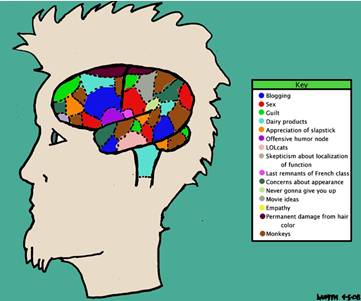 Customers take short cuts when shopping, otherwise the process would take an eternity! Research shows that they rarely take in all the available information about the product, such as nutrition or ingredients. Instead, they tend to organise ideas, products or brands into categories or 'mental boxes' in which they place their perception of the product, brand or company. Once these perceptions or images are stored, they are very difficult to change.
Customers take short cuts when shopping, otherwise the process would take an eternity! Research shows that they rarely take in all the available information about the product, such as nutrition or ingredients. Instead, they tend to organise ideas, products or brands into categories or 'mental boxes' in which they place their perception of the product, brand or company. Once these perceptions or images are stored, they are very difficult to change.
Companies have found that the best way to position their product is to emphasise the key positive attributes rather than provide customers will the entire picture - those mental boxes are just not large enough! To select those points to push, it will need to carry out market research to determine what customers in the target market value and desire. Dyson, for example, is so successful in the vacuum cleaner market because it's placed marketing emphasis on its technology and design; two values which had been missing before. Until the Dyson was launched, a vacuum cleaner was merely a functional appliance kept in a cupboard - now many people are happy to keep it on display.
Ultimately the market positioning process will determine who the firm's main competitors will be. If a firm aims for a premium, high quality image, then competitors will be all of those firms in the same segment which satisfy these attributes. If the firm selects a value approach, the competitors will be completely different.

Discussion
- Jot down your perceptions of the following products and brands:
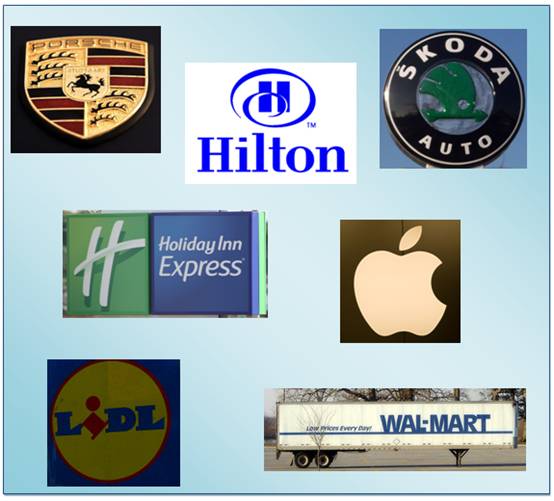
- To what extent do you believe that the image you hold will reflect the image all around the world?
Corporate image

Corporate image
The corporate image of a firm is the way in which the firm is perceived by consumers and other stakeholders. It can be generalised as being 'what the company stands for'.
Corporate image consists of two components; functional and emotional. The functional component relates to tangible characteristics, while the emotional component is associated with psychological dimensions that are manifested by feelings and attitudes towards a company.
 Corporate image is a key part of a firm's marketing as the firm wants to make sure that their image is consistent with their products and brand. A priority for marketing departments will be to enhance the firm's corporate image and activities aimed at enhancing this image.
Corporate image is a key part of a firm's marketing as the firm wants to make sure that their image is consistent with their products and brand. A priority for marketing departments will be to enhance the firm's corporate image and activities aimed at enhancing this image.
Marketing experts use public relations and other forms of promotion to suggest a mental picture to the public. These activities may include:
- Public relations - the firm will ensure that its public relations are positioned in such a way as to reinforce or enhance their intended 'corporate image'.
- Promotion - the firm may use their promotion as an opportunity to enhance the corporate image in the minds of consumers. Corporate advertising may be used to advertise the whole philosophy of the business.
- Website - the firm's website will be designed in such a way as to help with promotion and other marketing activities, but also to ensure that the corporate image is maintained or enhanced. Companies may for example, stress their environmental credentials or make their social responsibility report prominently available.
- Rebranding - the company name and logo will all need to match the corporate image and if this is not felt to be the case, then the firm may embark on a rebranding exercise.
Position/perception maps
One marketing research technique is taking consumer's views about a product and then plotting (mapping) these perceptions on a positioning chart. Respondents are asked questions about their experience with the product or service in terms of its performance, packaging, price and size. These qualitative answers are transferred to a chart referred to a position or perception map. The results can be used to improve the product or provide the background for developing new ones.
This position map defines the market in terms of the way buyers perceive key characteristics of competing products. The basic position map normally uses price and quality as the two key variables, but other variables are used, such as low or high calorie if mapping food items, or size related to cars.
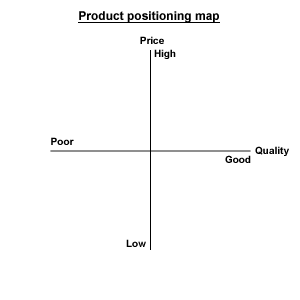
Figure 1 Product positioning map
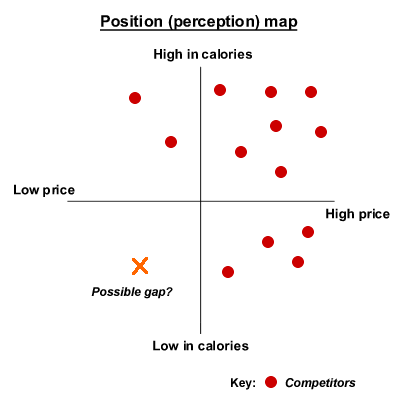
Figure 2 Product positioning map - example
The firm may map its proposed market to find a 'gap' in the market, where a new product may be positioned and the firm may seek growth. If the position map displays a cluster in one part of the market then the firm may avoid that area because of the high density of competition.
In the example above, high-priced, high calorie products are produced by a number of firms. These might be the 'indulgence' product such as rich ice-creams or confectionary. It may be very difficult to enter this segment unless the firm has a very strong brand image that matches the product requirements. However, there is a gap in the market for a product that is both low in calories and low in price. The firm must consider whether it has the strengths or assets to take advantage of this gap and whether the gap exists, because it may not be profitable to produce such a product.
The positioning map also reflects what your customers think about your brand. This may not be quite what you had in mind. Skoda, for instance, after it was bought by VW, spent millions on its marketing in an attempt to reposition itself in the minds of customers who had spent many a happy hour making up jokes about the poor quality of its cars. It was a difficult task, but one which has been accomplished successfully. Corporate image now matches product quality and price.
Think for a second about developments that are taking place in music. How can the music industry react to recent trends and position themselves in the market? Once you have had a think about this follow the Music link.

Group discussion
Using your knowledge of the music and entertainment scene and also technology developments, vision forward five years and produce a top ten of developments in the entertainment industry.
Once you have completed this exercise, examine the consequences for existing media corporations of these developments and for the marketing and distribution of new music and film.
Unique selling point/proposition USP

Unique selling point
The unique selling point or USP (also known as a unique selling proposition) is the key aspect of a product or service that sets it apart from the competition.
 In his book Reality in Advertising, Rosser Reeves gives the definition of a unique selling proposition as it was understood at his company at the time (Ted Bates and Company):
In his book Reality in Advertising, Rosser Reeves gives the definition of a unique selling proposition as it was understood at his company at the time (Ted Bates and Company):
- Each advertisement must make a proposition to the customer: "buy this product, and you will get this specific benefit."
- The proposition itself must be unique - something that competitors do not, or will not, offer.
- The proposition must be strong enough to pull new customers to the product.
Reeves was a pioneer of early television advertising and some of his slogans have survived to this day. For example, M&Ms "melt in your mouth, not in your hand". However, Reeves warned against basing a USP on what he calls "The Deceptive Differential" - a uniqueness that is too small or too technical for customers to observe the differences in actual practice.

Look at the following outline Prezi presentation on Corporate Image and USP:

USP Activity
In groups of 3 - 6, create a similar presentation on your school, or other organisation of your choice, identify its Unique Selling Points, mission, and image. Incorporate a range of images and media from podcasts to video. You can present this in a range of ways.
Prezi allows free use, but with limited functions - however students and teachers have access to private presentations through a free education account.
A basic tutorial can be found here.
Marketing strategies and tactics

Marketing strategy
A marketing strategy includes medium to long term marketing plans used to achieve marketing objectives and to support the overall corporate strategy. It combines product development, promotion, distribution, and pricing approach, identifies the firm's marketing goals, and explains how they will be achieved within a stated time frame. The marketing strategy determines the choice of target market segment, product positioning and allocation of resources.

Marketing tactics
Marketing tactics are the short-term, sometimes day-to-day, operational decisions that are adopted to keep the marketing objectives and strategies on target and to move from one milestone to another in pursuit of their overall goals.
In an organisation strategy is developed by the board of directors, and tactics by individual department heads for implementation by more junior employees. So, as we have seen, marketing is a philosophy but it also contains strategy. We shall see tactical planning a little later in this module - it's the day-to-day decision-making that is operational. In other words it's how you put the strategy into action. The overall strategy of a football team may be to prevent the other team scoring; the tactics are how individual members of the team play to create the desired result.
In most business situations the strategy is developed in five components. These components should be seen as part of a process and not a set of separate key areas that somehow operate independently of each other. The components are:
- Market research - ways of seeking out customer needs and discovering the target market.
- Product planning and development - making the products that satisfy the needs.
- Distribution - getting the products to the customers.
- Pricing - ensuring that customers perceive that products provide value for money.
- Promotion - communicating the availability of the products to potential customers.
Within any strategy lie tactics, or the ways in which the long-term ideas/policies are actually applied/put into action. Marketing has its own tactics and later we shall be looking at such familiar areas as:
- Advertising
- Sales promotion
- Selling techniques
- Publicity
A firm always need to look for a range of methods to get its message to existing and potential customers; marketing goes well beyond merely selling what a firm has already produced.
Developing marketing strategies
Putting objectives into practice is the task of those responsible for developing the marketing strategy (usually the marketing department in consultation with others). The firm will need to ask the following questions:
- What type of market is the firm operating in? Is it a large or mass market, or a specific segment or niche?
- What type of product will we develop? This will take into decisions relating to the product life cycle (more later - see section 3.4.3) and which products earn us our money. We will 'mature' products that generate cash. This in turn will allow us to research and introduce new products.
- What range of products will we produce? Will we have to produce a range, or portfolio of products? Another tool of business, namely the Boston Matrix is used to help us develop this essential of any successful enterprise. Later in the course we shall learn about cash cows and other parts of the matrix. At this stage all you need to think about is that we will need a balanced range of products if we are to survive and grow.
- What value do we add? This is how the customer sees (perceives) our products and why they buy them. It might be our unique selling point (USP) or some other factor e.g. a guarantee that makes our brand more popular than its rivals. Always think WHY it is that you buy something? Is it design, function, image or the actual service that the product gives you?
Correctly assessing and applying the above allows the firm to develop customer loyalty and plan with some degree of security.
Sales forecasting

Trends and extrapolation
When you are given figures in a case study or IB question on the development of a business, or results of marketing surveys, look for information that indicates an underlying pattern of growth or decline - referred to as a trend. Your task will be to analyse the movements and suggest reasons for the changes and most importantly, the consequences for the business.
In an IB examination, a question may ask you use the data you have been given to make predictions about future sales and profits. This process of using past data to predict the future is called extrapolation. To achieve this you will need to establish if there is an underlying trend below what may appear to be inconsistent past financial data. If you can find a trend, your next task will be to use this to predict the future - a business crystal ball! The problem is that, however scientific the process, the end result may be no more than a 'guestimate' and in practice may prove completely inaccurate - the future does not always resemble the past as events can rapidly change the status quo. You only have to consider the implosion of world economies from 2008 onwards to see how rapidly the external environment can change.
Figure 1 below shows a trend and an extrapolated trend.
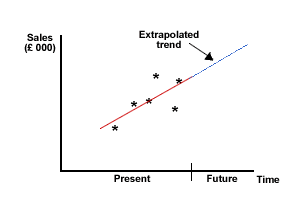
Figure 1 Extrapolated trend
The diagram shows actual sales figures over a period, which appear to be inconsistent. However, we are able to produce a 'line of best fit' called the trend line. In figure 1, the trend points to improving sales in the future. This trend is established through the use of MOVING AVERAGES to smooth out the impact of variations in data. We will look in more detail at these in the next section (click on the right arrow at the top or bottom of the page to start having a look at this).
Forecasting future sales has several important applications. The firm can use this information to:
- Plan future production levels: this will allow for a more efficient use of the firm's resources, in particular labour which is normally a firm's highest cost. It will identify recruitment and training needs, or depressingly the requirement for redundancies.
- Improve cash flow and working capital: examining variations in sales and predicting future sales can help the firm plan for its liquidity and evaluate the need for additional sources of finance. Lenders will be more likely to supply additional funds if they can see that the firm will be able to repay on time.
- Improve stock control: accurate sales forecasts will underpin stock ordering and ensure that production has the raw materials when required. Stock represents is tied up cash, so maintaining the correct level of stock will also help liquidity.
- Drive marketing campaigns: the identification of key periods for company sales will allow the firm to plan effective marketing including distribution, pricing and promotion.
- Underpin the budgeting process: sales are a major driver of budgets.
- Want to identify significant trend: firms want to know what trends are emerging to make sure they can adapt their marketing or product portfolio to reflect this.
- Want to see if any seasonal factors affect their product: Customers enjoy strawberries more often than just in the summer, so the major supermarkets import from warmer climates. That way they can eat strawberries and cream 12 months of the year, but at a price.
- Want to identify the influence of economic cycles arise within the firm's demand patterns: is the firm's demand closely linked to the state of the economy?

Qualitative forecasting/data

When no hard (numeric) data is available, qualitative data may be needed to predict future events or behaviour. This data relates to judgements and opinions. Two possible methods are:
-
 The Delphi Technique - Here a panel of experts is interrogated through a sequence of questionnaires, each of which builds on previous questionnaires in a series of 'rounds'. The experts answer independently of each other. After each round, a facilitator provides an anonymous summary of the experts' forecasts from the previous round as well as the reasons they provided for their judgments. The experts are encouraged to revise their earlier answers in light of the replies of other members of their panel. It is believed that the group will eventually reach a consensus. The process is stopped after a number of rounds or when a consensus is reached.
The Delphi Technique - Here a panel of experts is interrogated through a sequence of questionnaires, each of which builds on previous questionnaires in a series of 'rounds'. The experts answer independently of each other. After each round, a facilitator provides an anonymous summary of the experts' forecasts from the previous round as well as the reasons they provided for their judgments. The experts are encouraged to revise their earlier answers in light of the replies of other members of their panel. It is believed that the group will eventually reach a consensus. The process is stopped after a number of rounds or when a consensus is reached.
- Panel Consensus - Here experts work co-operatively to suggest answers.

Forecasting and correlation

Correlation describes a relationship between two sets of numbers. A scatter diagram can be used to see if there is a possible correlation between two sets of data. The closer the relationship between the two data sets, the closer the correlation and the higher the 'correlation coefficient'. We can see this from the two scatter graphs shown below - one has a high level of correlation between marketing spending and sales growth, while the other shows a low correlation.
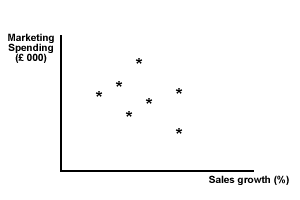
Figure 2 Low correlation - sales growth and marketing spending
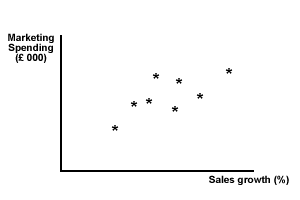
Figure 3 High positive correlation - sales growth and marketing spending
Correlation is a tool that is perhaps most used in marketing.
- It can show you the extent of a relationship between the sets of data.
- It can help plan with greater certainty and allocate resources accordingly.
Correlation can be placed alongside forecasting in that extrapolation needs to be considered in relation to other positive or negative variables. Changes in the external environment that are positively or negatively correlated with a firm's sales will have to be factored into any predictions of future sales growth.

Without being too repetitive, it is necessary to treat data with caution ... numbers can often be used to prove opposing points of view - it is a matter of the quality of the data (GIGO) and the nature of the interpretation and tools used.
Note:
- The sample may be too small and therefore not significant
- The industry may be subject to fast technical change
- The external environment can change

Forecasting techniques

Market research often ends up with a forecast: a forecast of future sales for instance. The preparation of such forecasts is known as time series analysis. The object here is often to separate the underlying trend within the forecast from whatever variations may be present.
First, though, what is a time series?

A time series
A time series consists of any set of observations, that are measured at specified time intervals (these intervals are usually equal).
Time series analysis (TSA) attempts to identify those factors that influence the observations in the series. Once these factors are identified, the time series may be extrapolated into the future and used for long-term and short-term planning. It is particularly useful in the forecasting of sales for a company. The aim is to separate variations from the underlying trend.
What are the variations that make the underlying trend hard to see?
If you would prefer to view this interaction in a new web window, then please follow the link below:
Constructing time-series analysis
How do we construct a time series analysis? Very carefully, is the answer, especially when it comes to drawing conclusions! The main methods used are:
- Free hand sketching
- Moving averages
Freehand sketching
This is self-explanatory. Plot the data and fit the 'best' line by eye. This method is not as useless as it looks. It gives a first approximation, and may also be the best that can be done.
Be very careful when a pattern that has become established changes. Look at the sales forecast below.
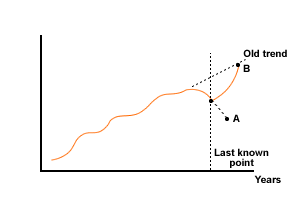
Figure 3 Possible sales forecast
Sales and profits have risen for years, but suddenly there is a fall. Is it an error, a blip, or what? What will be the forecast for next year? Will it be A or B? The message is watch carefully, and analyse even more carefully what happened last year. It is too easy to read into the forecast what you want to see, and then justify it.
Click on the right arrow at the top or bottom of the page to look at the second of these techniques - moving average.
Moving average
The nature of the latest business and management programme and the nature of the papers means that this has proved a less popular question than in earlier programmes as the calculations can be quite time consuming leaving little time to analyse or evaluate.
A moving average is used to 'smooth' the data and remove the variations produced by seasons, trade cycles and random variations. There are a number of moving averages that can be used, with the following being the most common.
- Three-point average
- Four-point moving average.
Three-point moving average:
This is by far the easiest and quickest moving average to calculate, but it does not completely smooth the trend line and so makes accurate extrapolation more difficult.
Three-point averages are calculated by taking a number in the series with the previous and next numbers and averaging the three of them.

| Series: Actual sales |
| 2080 |
| 1200 |
| 1520 |
| 2560 |
| 2160 |
| 2000 |
The underlying trend in the series above is not clear because of the variations within the data. If we calculate a moving average, however, we are able to remove some of these variations.

For any series of numbers you are able to calculate 2 less three-point moving averages than there are numbers in the series because:
- the first number does not have a previous number
- the last number does not have a next number
Moving Average (1): take the first three figures in the series and average them:
![]()
Moving Average (2): drop the first figure from the front and add in the next in the series
![]()
Moving Average (3): continue to use the next set of three figures in the series
![]()
Moving Average (4): continue to use the next set of three figures in the series
![]()
So from a set of six sales figures, we have produced 4 three point moving average calculations:
1600
1760
2080
2240
From these results the trend has become obvious - it shows that the trend is positive and there is sales growth.
Three point moving averages are also useful in working out the average variations across a longer period. This is because the average of three numbers falls on the middle of the series and so can be compared directly with the actual sales for that period
|
Series: Actual sales |
Trend (3-point) Sales |
Variation Sales - Trend |
| 2080 | ||
| 1200 | 1600 | -400 |
| 1520 | 1760 | -240 |
| 2560 | 2080 | +480 |
| 2160 | 2240 | -80 |
| 2000 |
If these variations are seasonal or cyclical they can be used to predict actual sales by adjusting the extrapolated future sales to take account of the predictable variation. In the example above we can see that the trend sales are NEVER equal to the actual sales and so could not be used to plan future production for instance without further analysis. The trend on its own can only be used to show whether future sales are likely to be higher or lower than past sales.
Four-point moving average:
A four-point moving average will smooth out the trend line more effectively than a three-point moving average, but has the following problems which make calculations more difficult:
- There are fewer moving average results
- The average of four figures falls on the mid-point which does not correspond to an actual sales figure - an example is given later. This requires a further adjustment to be made to allow direct comparisons to be made.
However, a four point moving average does correspond with how sales are often reported which is quarterly - i.e. every three months.
|
Series: Actual sales |
| 2080 |
| 1200 |
| 1520 |
| 2560 |
| 2160 |
| 2000 |
The underlying trend in the data is not clear because of the variations within the data. If we calculate a moving average we are able to remove some of these variations.

For any series of numbers you are able to calculate 3 less four point moving averages than there are numbers in the series
Moving Average (1): take the first four figures in the series:
![]()
Moving Average (2): drop the first figure from the front and add in the next in the series
![]()
Moving Average (3): continue to use the next set of three figures in the series
![]()
For a moving average based on an odd number, the midpoint coincides with one of the original sales values. For a moving average based on an even number it does not:
Mean of three-point average
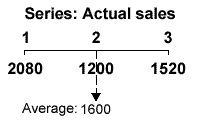
The average falls on the mid-point of the series which is the second sales figures, so it can be compared directly with the actual sales, showing the trend sales are 400 higher than actual sales.
Mean of four-quarter average
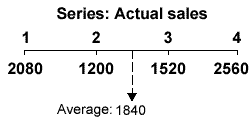
The trend average falls between 2 and 3 in the series and cannot be directly compared with either the actual sales for period 2 or period 3
So with a four-point moving average we only produce three results from our series, and these do not correspond with actual sales and so no variation can be established:
1840
1860
2060
|
Series: Actual sales |
Trend (4-point) Sales |
| 2080 | |
| 1200 | |
| 1840 | |
| 1520 | |
| 1860 | |
| 2560 | |
| 2060 | |
| 2160 | |
| 2000 |
So how can a variation be established?
Well statisticians use a method called Centreing. This means averaging two averages to produce a result which does correspond with an actual sales figure.
In our very small series we would do this by averaging 1840 + 1860 and 1860 + 2060:
![]()
![]()
The resulting figures now correspond to an actual sales figure and so a variation can now be established.
|
Series: Actual sales |
Trend (4-point) Sales |
Centred trends |
Variation Sales - Trend |
| 2080 | |||
| 1200 | |||
| 1840 | |||
| 1520 | 1850 | - 330 | |
| 1860 | |||
| 2560 | 1960 | + 600 | |
| 2060 | |||
| 2160 | |||
| 2000 |
By averaging (centreing) two four-point moving averages we have managed to produce results that can be compared, but only TWO of them. It must be clear that this method is not very suitable with only a small series of results. However, follow the example below to see how it can work with a larger series of figures, related to quarterly sales.
Four point moving average - worked example

Worked example using a four-point moving average
Sales of XYZ Ltd.
| Sales Revenue | ($000s) | |||
| Year | Quarters | |||
| 1 | 2 | 3 | 4 | |
| 1 | 240 | 224 | 204 | 240 |
| 2 | 244 | 236 | 220 | 262 |
| 3 | 260 | 254 | 230 | 286 |
A qualitative examination of this data shows that the general trend is one of rising sales. Superimposed on this is an annual cycle with the highest sales in quarter 1 and the lowest in quarter 3 - this is likely to be a seasonal variation. Now let us investigate the figures quantitatively.
Extracting the 'trend'
After calculating an average of year 1, consisting of quarters 1 to 4, we then drop the first quarter's sales value and replace it with that of quarter 1, year 2. The average has, therefore 'moved' forward one quarter.
| Periods used (Yr/Qtr) | Moving Average | Trend |
| 1/1, 1/2, 1/3, 1/4 | (240+224+204+240) / 4 | = 227 |
| 1/2, 1/3, 1/4, 2/1 | (224+204+240+244) / 4 | = 228 |
| 1/3, 1/4, 2/1, 2/2 | (204+240+244+236) / 4 | = 231 |
| 1/4, 2/1, 2/2, 2/3 | (240+244+236+220) / 4 | = 235 |
| 2/1, 2/2, 2/3, 2/4 | (244+236+220+262) / 4 | = 240.5 |
| 2/2, 2/3, 2/4, 3/1 | (236+220+262+260) / 4 | = 244.5 |
| 2/3, 2/4, 3/1, 3/2 | (220+262+260+254) / 4 | = 249 |
| 2/4, 3/1, 3/2, 3/3 | (262+260+254+230) / 4 | = 251.5 |
| 3/1, 3/2, 3/3, 3/4 | (260+254+230+286) / 4 | = 257.5 |
The problem with this method is that the resulting trend figures do not fall on a particular quarter, but between quarters (see Figure 1). Since it is necessary to compare the sales trend with actual sales, it is advisable to obtain a trend that falls on a particular quarter. This is achieved by a process called CENTREING, where we add and average pairs of trends. The resulting average is thus based on eight quarter's data (Figure 2).
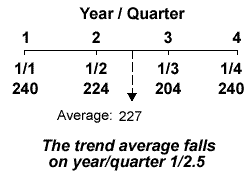
Figure 1: Mean of four-quarter sales
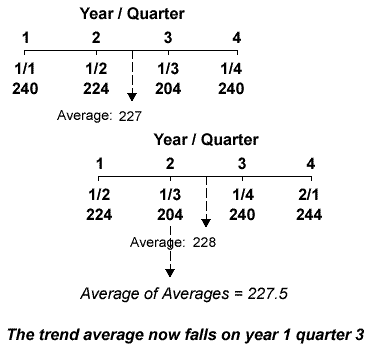
Figure 2: Centreing of two successive four-quarter moving averages
Since the trend average now corresponds with an actual month and we can compared this figure directly with the actual sales of that month. In practice, it is easier to add the two successive 4-period moving totals together and divide the result by 8, as shown below.
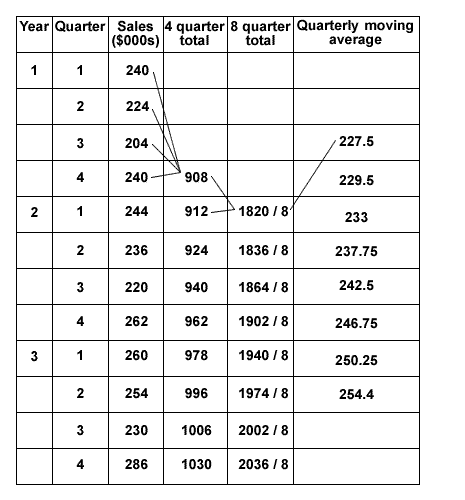
The trend line can be extended to forecast the future trend line on the assumption that the trend of the past will continue in the future. The angle of the extension could be changed according to other data, e.g. economic forecasts that might suggest that the future will be better, worse or similar to now.
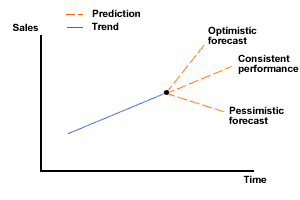
Identifying the seasonal variation
If we used our original sales series there would not be enough data to allow us to identify seasonal variations, so we are going to use the sales figures from our worked example above.
Looking at the original sales figures we can see not only an upward trend in sales, but also a consistent seasonal pattern. Sales in quarter 1 and quarter 4 are higher than the trend sales, and sales in quarter 2 and quarter 3 are lower than the trend sales. We can calculate an average variation from the trend for each of these quarters, which will allow us to adjust the extrapolated trend sales for each quarter to take account of the recognised seasonal pattern of the past. In other words, the trend line and the extrapolated trend smooth out seasonal variations - what we need to do to forecast future actual sales per quarter is to recreate these variations around the extended trend..
| Quarter | Sales ($000s) | Moving average trend ($000s) | Sales - trend = seasonal variation ($000s) |
| 1 | 240 | ||
| 2 | 224 | ||
| 3 | 204 | 227.5 | - 23.5 |
| 4 | 240 | 229.5 | + 10.5 |
| 1 | 244 | 233.0 | + 11 |
| 2 | 236 | 237.75 | - 1.75 |
| 3 | 220 | 242.5 | - 22.5 |
| 4 | 262 | 246.75 | + 15.25 |
| 1 | 260 | 250.25 | + 9.75 |
| 2 | 254 | 254.4 | - 0.4 |
| 3 | 230 | ||
| 4 | 286 |
The figures in the last column show the seasonal variation for each quarter and confirm that sales in quarters 1 and 4 are higher than trend sales and sales in quarters 2 and 3 are lower than trend sales. We can use these seasonal variations to calculate the average seasonal variations, but it is important to note than from the limited sales data available these variations are based on such a small number of observations that they are unlikely to be very accurate and, therefore, should be used with caution. Firms that have been operating for many years are likely to have
| Quarter | Calculation | Average seasonal variation |
| 1 | (11 + 9.75) / 2 | 10.375 |
| 2 | ( - 1.75 + - 0.4) / 2 | - 1.075 |
| 3 | (- 23.5 + - 22.5) / 2 | - 23 |
| 4 | (10.5 + 15.25) / 2 | 12.875 |
The average seasonal variations can be used with the extrapolated trend to produce a more accurate forecast. Where there is negative result the actual forecast sales can be established by taking the sales variation away from the trend sales figures. So for quarters 2 and 3, the predicted actual sales will be below the trend sales, although quarter 2 is very close to the trend sales. The average seasonal variations for quarters 1 and 4 should be added to the trend sales figure to produce more accurate sales figures.
In other words if the projected sales for the first quarter of year 4 is $140,000, this figure would need to be increased by $10.375 to provide a more accurate prediction.
Trend Analysis Summary Method
- Plot the actual sales
- Work out the trend by using 8 quarter moving averages
- Add the trend to the original graph
- Extend (extrapolate) the trend (using other data for its angle)
- Calculate average seasonal variations for each quarter
- Predict actual future by recreating the shape of the seasonal variations around the extrapolated trend
- Read off the predicted actual sales for the future period required.

4.2 Marketing planning - questions
In this section are a series of questions on the topic - Marketing planning. The questions may include various types of questions. For example:
- Self-test questions - on-screen questions that give immediate marking and feedback
- Short-answer questions - a series of short-answer questions to help you check your understanding of the topic
- Case study - a case study with associated questions
- In the news - questions based around a topical business news article
Market research - self-test

1 |
Market researchMarket research is best described as: |
2 |
Consumer motivationWhen looking at changes in consumer motivation which of the following would NOT be something we would look at? |
3 |
Market research information gatheringIdentify which of the following describes the main forms of information gathered in market research |
4 |
Questionnaire designWhen designing a questionnaire which types of question would be asked if you wanted to achieve a more open-minded response? |
5 |
SamplingWhich of the following is NOT a form of sampling? |
Marketing plans - self-test

1 |
Marketing - aimMarketing is mainly trying to: |
2 |
MarketA market is: |
3 |
Market segmentationWhich of the following is not normally used as a classification of a segment within a market? |
4 |
Market growthMarket growth is normally thought of as: |
5 |
Market segmentationWhich of the following might be used to further segment a market? |
Marketing objectives & strategy - self-test

1 |
Marketing objectivesMarketing objectives are best defined as: |
2 |
Marketing objectivesWhich of the following would NOT be part of a firm's marketing objectives? |
3 |
Product differentiationA business normally aims to differentiate its products as this: |
4 |
Niche productWhich of the following would feature as one of the ways in which a niche product could be established? |
The marketing mix - case study

A traditional family drinks firm has been developing slowly and built up a strong reputation, but control has now passed to the next generation and they want to look at possible expansion for the firm. The new marketing director made the following statement:
'We have a strong family image and our products are trusted, but we are considering changing our production strategy. We have normally just produced the flavouring and let others bottle it and take the risks of selling to the public. After considerable market research we have decided to launch our own brand of soft drinks. Initially, these will be: a cola flavour, lemonade and ginger beer. If these are successful then others are planned.'

- Explain the marketing importance of 'a strong family image'.
- Outline the market research the company is likely to have undertaken.
- Analyse the advantages and disadvantages of the drinks firm introduce their brands with a penetration pricing policy.
- Discuss potential changes in the marketing mix that this new strategy will involve and comment on their significance.
Marketing plan - case study

Seldom Beaten Plc has passed through a period of falling sales and a new Marketing Manager has been appointed. Just a few days after he arrived he called for the marketing plan and discovered that what was brought to him with little more than a list. He therefore decided to call a meeting of the various departmental heads and explain the advantages of a decent marketing plan.

How would you set about converting some rather sceptical colleagues of the advantages of marketing plans?
Marketing objectives and market share

Question 1
In the competitive world of fashion examine how a design house can maintain its position as a market leader.
Question 2
Outline the scientific process on which the marketing model is based.
Question 3
Using the diagrams as appropriate, explain how a marketing model is turned into a marketing plan.
Question 4
Examine the factors which might influence the success of a marketing plan.
Question 5
Explain the essentials of a good marketing strategy.
Question 6
Analyse the importance of a marketing plan to a small firm.
The role of market research

Question 1
Explain how you would design and conduct market research to establish the percentage of students in your school/college who prefer Coke to Pepsi, and whether this preference is determined by age, sex or specific class.
Question 2
Examine the reasons why a good knowledge of your customer base is so important when planning the marketing of your product range.
Primary and secondary research - short answer questions

Question 1
Distinguish between primary and secondary data.
Question 2
Distinguish between desk and field research.
Question 3
Compare and contrast the value of desk research to field research.
Question 4
Examine the dangers of using historical data as a basis for forecasting the future.
Question 5
Explain the major trade-offs involved when conducting market research.
Question 6
Outline the possible marketing techniques used in field research.
Questionnaires - short answer questions

Question 1
Describe what is meant by the term 'research bias' and outline methods to reduce its impact on a survey you were conducting.
Question 2
Outline the main reasons why a survey might produce results, which are of little use.
Market segmentation - short answer questions

' For those wanting to work in the winter sports industry 'Snowboard Life' is a new magazine designed to tell you all about the pitfalls of certain resorts, firms whose jobs 'suck' and all you need to know before leaving your cosy little pad. It's available by subscription at $80 for twelve copies.'

Question 1
- Identify the target audience for this new magazine.
- Outline some linked marketing that might feature in the magazine.
- Explain why the magazine has decided to sell by subscription.
Question 2
Identify the main criteria used to segment most consumer markets.
Question 3
Analyse the importance of segmentation when marketing a product like 'Snowboard Life'.
Sales forecasting - short answer questions


Question 1
Explain the importance of sales forecasting.
Question 2
Identify three reasons why sales forecasts may prove inaccurate.
Question 3
Explain the use of correlation analysis in marketing.
Question 4
Outline the basic techniques involved in sales forecasting.

Sales forecasting - case study


Despite a full range of focus group testing the new ice cream failed to take-off and sales were disappointingly low. Lemon flavour had been tested amongst adults and the price point established. However, young people had not rushed to buy the product and with Autumn approaching the marketing manager was concerned that the original forecasts were wildly optimistic. He had spent his marketing budget on expensive adverts for both TV and the national press, but had not foreseen the introduction of a new fruity range by their major rival.
Unless things improved the product line was doomed and so probably was his career with the largest makers of ice cream in the country.

Question 1
Define the terms:
- focus group
- marketing budget
Question 2
Explain why the market research may have been inaccurate.
Question 3
Identify four factors that might have led to the disappointing sales.
Question 3
Discuss how the marketing mix may be adapted if the firm decides to re-launch the product.

Forecasting techniques - short answer questions


Question 1
Outline the problems in preparing a 4-quarter moving average.
Question 3
Explain how a firm can allow for irregular variations in its planning.
Question 4
Comment on the value of freehand sketching as a means of performing time series analysis.
Question 5
Analyse the advantages and disadvantages of using time series analysis in the business planning process.

Forecasting techniques - numerical questions

Maze Green Yachts plc
Maze Green has been in business selling yachts and other pleasure craft for the last 14 years. Their sales record is reproduced below:
| Year | Quarter | Yacht sales |
|---|---|---|
| 2008 | 1 | 6 |
| 2 | 10 | |
| 3 | 12 | |
| 4 | 8 | |
| 2009 | 1 | 8 |
| 2 | 15 | |
| 3 | 16 | |
| 4 | 10 | |
| 2010 | 1 | 9 |
| 2 | 18 | |
| 3 | 18 | |
| 4 | 11 |

Question 1
Plot the data in on graph paper
Question 2
Using a 4 quarter moving average plot the resulting trend line.
Question 3
Calculate the seasonal variation for each quarter and use these figures to work out the average seasonal variation for each quarter
Question 4
Calculate the forecast sales for each quarter of 2011.
Sales of fashion shoes
Sales of modern fashion shoes were carefully recorded over the 20 months of its life and are published below.
| Month |
Sales (pairs) |
Month |
Sales (pairs) |
|---|---|---|---|
| 1 | 20 | 11 | 280 |
| 2 | 80 | 12 | 250 |
| 3 | 140 | 13 | 200 |
| 4 | 200 | 14 | 180 |
| 5 | 230 | 15 | 160 |
| 6 | 250 | 16 | 150 |
| 7 | 280 | 17 | 140 |
| 8 | 310 | 18 | 130 |
| 9 | 300 | 19 | 90 |
| 10 | 300 | 20 | 60 |

Question 1
Plot the data in the form of a scatter diagram, and attempt to identify any trend.
Question 2
Prepare a 4 month moving average, and plot the resulting trend line.
Question 3
Comment on your findings.
Honeydew Ice Creams
Sales of ice cream are highly seasonal, so can be hard to predict. Data recording sales of ice cream tubs for the last four years of trading for Honeydew is given below.
| Q1 | Q2 | Q3 | Q4 | |
|---|---|---|---|---|
| 2007 | 2500 | 5000 | 2500 | 1000 |
| 2008 | 2500 | 6000 | 3000 | 1000 |
| 2009 | 3000 | 6500 | 3000 | 1500 |
| 2010 | 3500 | 7000 | 3500 | 1500 |

Using time series analysis of the above data, calculate:
- The seasonal variation by quarter
- The best estimate of sales, by quarter for the year 2011.
Carry out this calculation using both 3 and 4 quarter moving averages

Cyclical variation - numerical question

Honeydew Ice Creams
Ice cream sales are seasonal, but Honeydew Ice Creams have tried to break this trend by introducing new frozen desserts and specialty products from 2010 to widen their product range. Details of their sales over the last four years are shown below.
| Q1 | Q2 | Q3 | Q4 | |
|---|---|---|---|---|
| 2008 | 3000 | 6500 | 3000 | 1500 |
| 2009 | 3500 | 7000 | 3500 | 1500 |
| 2010 | 3800 | 7400 | 3800 | 1600 |
| 2011 | 4500 | 8100 | 4600 | 2400 |

To what extent is there evidence that their marketing policy has been successful?

Marketing strategies - short answer questions

Question 1
Analyse the advantages and disadvantages of a firm diversifying its operations.
Question 2
Nescafe appears to have a competitive advantage over its main rivals. Analyse methods by which this advantage can be maintained.
Question 3
Identify the types of questions used when screening a proposal for a new drink flavoured to taste like lemon tea.
Question 4
Explain the terms:
- asset-led marketing
- market-led marketing
Marketing strategies - case study

 Bisto gravy powder, currently owned by Premier Foods, has been extremely popular in the UK since the 1920s. Sunday lunch was the focal point of most family's week. Father carved and mother slaved away to produce just what they all wanted; roast potatoes and all the trimmings.
Bisto gravy powder, currently owned by Premier Foods, has been extremely popular in the UK since the 1920s. Sunday lunch was the focal point of most family's week. Father carved and mother slaved away to produce just what they all wanted; roast potatoes and all the trimmings.
Then things started to change and Sunday became less special and the roles of mothers and fathers begun to change. People started to eat out, or went away and so the traditional Sunday lunch lost some of its appeal. Gravy suffered and the manufacturers of Bisto were faced with a problem.
In response to declining sales, the producers of Bisto decided to:
- Relaunch using the old image of kids smelling something good cooking
- Update the promotion - the kids were modern in their dress and attitudes
- Vegetarian gravy was introduced, as was herbs, chicken and beef
- Granules replaced powder, so allowing instant gravy
The result was an enormous increase in sales and Bisto survived.

Read the article Bisto Gravy Granules (you can do this in the window below or follow the previous link to read the article in a separate window) and then consider answers to the questions below.

Question 1
Describe the elements of a marketing plan.
Question 2
Explain the importance of market segmentation for Bisto's marketing strategy.
Question 3
Analyse different methods of market research that Bisto may have conducted to before changing their product range.
Question 4
Evaluate the impact on Bisto objectives and strategy of changes in the external environment
Marketing strategies - case study (2)

Ryanair has grown quickly in the budget airline market. Although highly successful, Ryanair is perceived to be highly aggressive in its strategy and marketing and has been criticised by consumer groups for its pricing policies, which they argue are less than transparent.

Read the following articles about Ryanair
- Ryanair's Marketing Mix
- Ryanair's Marketing Techniques: Genius or Madness?
- OFT accuses Ryanair of 'taunting customers' over extra £5 charge
(you can do this in the window below or follow the previous link to read the article in a separate window) and then consider answers to the questions below.

Question 1
Describe the difference between market and product orientation.
Question 2
Explain the key elements of Ryanair's marketing approach.
Question 3
Examine how appropriate Ryannair's marketing objectives are in achieving the goals of the organisation.
Question 4.
Discuss the ethics of Ryanair's marketing strategy.
The Business of Ageing

Japan's population has already peaked, and the first of the "baby boomer" generation are due to retire next year. As a result, by 2050 the population is forecast to fall from 127m to just over 100m.
Japan is set to be the 'greyest population' in the world with 40% over 65 years of age by 2050, leading to spiralling health and social security bills that will have to be financed by a working population that is already in decline.

Read the article Solving Japan's age-old problem (you can do this in the window below or follow the previous link to read the article in a separate window) and then consider answers to the questions below.
For further background on Japan's fallen population please read the following article
Question 1
Define the terms:
- demographic change
- innovation.
Question 2
Explain how some Japanese manufacturers have changed their product mix in response to the ageing population.
Question 3
Analyse how demographic change can impact on business objectives and strategy.
Question 4
Discuss how Japanese producers can use market segmentation, targeting and positioning to differentiate their products from competitors.
The online music revolution

Read the article Viral videos - no longer the trailblazing net phenomenon they once were and then have a go at the questions below. You can either read the article in the window below, or follow the previous link to open the article in a new window.
Before you answer the questions you may like to look through some of the postings on the following site which provides advice to independent musicians on online marketing strategies:
and consider the points made in the following blogpost:

Question 1
Describe what is meant by 'viral marketing'.
Question 2
Explain the impact of the internet on major record labels.
Question 3
Analyse the effectiveness of the internet in achieving the marketing objectives of independent musicians.
Question 4
Evaluate the statement 'Genuinely independent viral success has always been a lucky exception' and assess the extent to which record labels can influence social media.
Marketing and ethics

Read the article A question of ethics (you can do this in the window below or follow the previous link to read the article in a separate window) and then consider answers to the questions below.

Question 1
Define the term 'ethical marketing'.
Question 2
Explain why Martin Glenn believes when he says that "the public scrutiny of brand management has never been as intense."
Question 3
Analyse the advantages and disadvantages to a firm of making ethical considerations a central feature of its overall marketing strategy.
Question 4
Discuss why a firm's view of its social responsibility may change over time.
Make it green and keep them keen

Read the article Make it green and keep them keen (you can do this in the window below or follow the previous link to read the article in a separate window) and then consider answers to the questions below.

Question 1
Define the terms:
- green marketing
- social marketing.
Question 2
Explain how the growth of green marketing has changed the marketing mix for companies like Eurostar.
Question 3
Analyse two potential costs and two potential benefits of adopting a greener marketing approach.
Question 4
Evaluate two green marketing strategies that a firm like Eurostar can use to differentiate themselves from their competitors.
'Green' Gifts

Read the article French go for 'green' gifts (you can do this in the window below or follow the previous link to read the article in a separate window) and then consider answers to the questions below.

Question 1
Describe what is meant by the term 'low carbon gifts'.
Question 2
Explain why 'environmental concerns' are now so important in marketing decisions.
Question 3
Analyse the advantages and disadvantages of linking a firm's corporate social responsibility (CSR) commitments to its marketing strategy
Question 4
"A study by online survey firm Vivodi for PriceMinister showed eight out of 10 people would be happy to receive a used item as a gift and that younger consumers were more open to the idea, but Gilles Goldenberg, author of the Deloitte study, cautioned that environmental concerns are not the overriding consideration when buying used goods."
Evaluate other types of market research that could be conducted to examine the attitudes of the consumers to buying used goods.
Changing times

HMV is a major UK music retailer. Shares in retail group fell 17 % in December 2010 after the company reported an accelerating decline in sales and halved its interim dividend.
HMV has been trying to diversify into new products such as iPads, develop live and digital music markets, revitalise its Waterstone's book chain and sell more technology products and entertainment-related clothing in the HMV stores. However, this strategy has not compensated for erosion in its traditional book and music markets. Live music profits of £1.5m fell below expectations, and the company said the 15.3 per cent decline in sales at HMV meant it "must accelerate" the introduction of new products.
Adapted source: FT.com

Read the article HMV rocked by growing losses and snow storms (you can do this in the window below or follow the previous link to read the article in a separate window) and then consider answers to the questions below.

Question 1
Define the terms:
- interim dividend
- loss leader.
Question 2
Explain the problems associated with a seasonal business model.
Question 3
With reference to an appropriate tool like the Ansoff Matrix, analyse the growth strategy adopted by HMV.
Question 4
Using Porter's Five Forces model, evaluate the principal pressures faced by HMV.
TryIT - Marketing Maze Green Yachts
 Now that you have considered many of the different ways that companies market their products, why not try it out for yourself and see how well you can market a product.
Now that you have considered many of the different ways that companies market their products, why not try it out for yourself and see how well you can market a product.
In the window below is the Maze Green Yachts online business simulation. In this, you get to see how well you can run a major international yacht manufacturer.
To test how well you can market their yachts, go to the Maze Green business simulation (you can either do this in the window below or you can open it in a separate window by following the previous link).
In the simulation you can change the levels of promotion spending. You can also adjust the pricing of the various products and see how this affects the product portfolio. The company sell a range of yachts from small to large and these have different characteristics. Have a browse around (under the 'Make changes' tab to see the difference between all the products. Then try answering the following questions.
N.B This section repeats some of the earlier questions in this module.

Question 1
Explain the difference between above the line and below the line promotion.
Question 2
Comment on whether the values of the price and income elasticities will differ between the Maze Green products at the bottom of the price range and the top of the price range.
Question 3
Try running the simulation for two years, while increasing just promotion spending. Identify the impact this had on sales.
Question 4
Try running the simulation for two years, while decreasing just promotion spending. Identify the impact this had on sales.
Question 5
Try running the simulation for one year, while increasing the prices of the yachts by 5%. How much have sales gone down by? Calculate the value of the price elasticity of demand for the yachts.
Question 6
Now try the same while increasing the prices of the yachts by 20%. How much have sales gone down by? Identify the change in price elasticity of demand for the yachts.
Question 7
Now try the same while increasing the prices of the yachts by 50%. How much have sales gone down by? Identify whether the price elasticity of demand for the yachts changed.
Question 8
Try running the simulation for one year while decreasing the prices of the yachts by 5%. How much have sales gone up by? What is the value of the price elasticity of demand for the yachts?
Question 9
Now try the same while decreasing the prices of the yachts by 20%. How much have sales gone up by? Has the price elasticity of demand for the yachts changed?
Question 10
Now try the same while decreasing the prices of the yachts by 50%. How much have sales gone up by? Has the price elasticity of demand for the yachts changed?
Question 11
Analyse how the value of the price elasticity of demand is likely to affect your optimum pricing strategy.
Question 12
Develop an appropriate marketing strategy for Maze Green Yachts for the launch of a new yacht. The new product is aimed at the highest income earners and is the largest yacht in their product range. Customers are able to individualise the yachts to a significant extent.
Question 13
Discuss the marketing problems that Maze Green Yachts are likely to face if they undertake a major international expansion.
Question 14
The United Kingdom is considering joining the European single currency. As the Maze Green finance director you have been asked by the Board of Directors to write a report evaluating whether Maze Green should support this move.
4.3 Product introduction - notes
In the previous sections we examined the role, definition and nature of marketing, marketing planning, the marketing mix, marketing objectives, positioning and market research. In this section we will look at the classification of products, new product development, the product life cycle, product portfolios and branding.

By the end of this section you should be able to:
- Classify products by line range and mix
- Describe the importance of innovation in an era of rapid technological change and discuss the problems and financing research and development
- Analyse the relationship between the product life cycle and the marketing mix, and determine appropriate extension strategies
- Analyse the relationship between the product life cycle, investment, profit and cash flow
- Apply the BCG matrix to a given situation
- Discuss the importance and role of branding

- Use the BCG matrix to help in developing future strategic direction
- Distinguish between different types of branding
- Analyse the role of branding in a global market
Product
 One of the main aims of any firm is to mark themselves out from other firms and ensure that their product is, or appears to be, different or even unique. This is termed product differentiation and it is something all companies are striving for. Product differentiation is the basis of a Unique Selling Point or Proposition (USP).
One of the main aims of any firm is to mark themselves out from other firms and ensure that their product is, or appears to be, different or even unique. This is termed product differentiation and it is something all companies are striving for. Product differentiation is the basis of a Unique Selling Point or Proposition (USP).
Product differentiation
This is when a producer tries to make their products significantly different from their rivals, or at least to persuade consumers that there is a fundamental difference worthy of staying loyal to the brand and/or paying more.
A firm may differentiate itself from competitors by:
- providing a better service such as better in-sale and after-sale services. This may include home delivery by a supermarket, extended guarantees and a range of financial offers such as credit.
- looking different by focusing on specific features which make the firm distinctive and recognisable. Marketing departments, for example, spend considerable time and money on features such as colour of products, logos and trademarks, design, shape or the convenience of products and outlet layout.
- branding - here the company builds a certain image into its products. Name association, presentation awareness, personality links seek to maintain product and corporate awareness.
A strong corporate identity and customer loyalty provides the firm with a range of opportunities such as premium pricing.
Product
What can a firm do to increase its appeal and uniqueness? It can try to:
- Improve quality - a firm needs, if possible, some new angle or development that differentiates its e-reader, smartphone or whatever from the rest. Quite often it's what customers perceive to be 'quality' that matters. Why do people wait years for two to three years for certain supercars like a Ferrari or a Rolls Royce to be specially made for them? Why pay more for certain designer labels?
- Features - these are characteristics or elements of a product that may help to differentiate it from others, the extras and add-ons.
- Colour - Customers relate to certain colours in scientifically proven ways. Colour is normally a major part of a firm's marketing mix. Indeed, some colours are closely associated with a particular brand in a market segment. Shell, for example, uses red and yellow, while BP concentrates on green. Cigarette manufacturers are heavily restricted in how they can advertise, but the use of colour can be closely associated with a brand and then displayed in a variety of ways that attempt to circumvent restrictions. Formula One cars, for example, carry the colours of their tobacco sponsors. Perhaps the strongest customer preferences and opinions relate to the choice of car colours.
-
 After sales service - customers don't like their products to break, so an extended warranty period and a wide-ranging after sales service may encourage purchase of one brand in preference to another.
After sales service - customers don't like their products to break, so an extended warranty period and a wide-ranging after sales service may encourage purchase of one brand in preference to another. - Size - perhaps it does matter! Customers normally seek value for money. Some products are sold as king-size, which we understand to be larger than average. Yes, but what is average? Other products are sold as small and we like this. The market has to establish customer expectation and then build on this. We seem to be attracted to 25% extra or 3 for the price of 2 as we perceive this to really be 'something for nothing'.
Classification of products

A product
A product is a good or service that satisfies a customer's needs.
According to Philip Kotler, a product is:

'Anything that can be offered to a market for attention, acquisition or consumption that might satisfy a want or a need. It includes physical objects, services, persons, places, organisations and ideas'.
A product can be a tangible or visible item, such as a chair, that can be touched and seen, or intangible or invisible, such as a service like education or health services.
Services cannot be seen - what is provided is the skill or expertise of another person or group. However, the result of a service normally can be. For example, if a plumber unclogged a pipe, the water would then flow freely. In reality few services do not have a physical element (e.g. textbooks and desks at a school) and few goods come without a service element (e.g. delivery, after sales service and credit facilities) with a car.
Product is only one element of the marketing mix. For example, a firm may create value added for their products through promotion of the products virtues and branding, which may be complemented by suitable pricing.
It is extremely uncommon for a firm to sell as single product.

Can you think of any firm that sells a single good or service?
Firms will normally sell a range of products, which can be grouped or categorised in the following ways:

Product item
A product item is a specific version of a product e.g. brand/size/model.

Product line
A product line is a set of individual products that are closely related and marketed by the same organisation and intended for similar, but not identical buyers, e.g. P&G make laundry products such as Daz, Bold, Ariel and Ace and Cadbury make chocolate bars such as Flake, Dairy Milk, Crunchie and Time Out.
Line stretching - this may be through lengthening the product line either upwards into higher quality items or downwards into lower quality items, or in both directions at once. Audi has recently decided to produce a smaller versions of their cars - the A1 and A2 appealing to the family sector, rather than to the executive market. This is in response to BMW's one series and Mercedes A and B Class.
Some firms take the approach that they will use a different brand name when they line stretch. National Panasonic, sells its premium electronic equipment as Technics and Toyota markets its executive cars under the Lexus brand.
Line filling - gaps in the line are filled with new product offerings. The objective here is to differentiate the new products from existing products, otherwise the firm will be creating competition for its own brands. However, it may be that the firm is not concerned if the new product takes some sales from its existing brands, provided it takes an equal number from competitor brands. Detergent manufacturers, such as Lever Brothers and Procter and Gamble, are constantly attempting to line fill to create differentiation. Different methods of delivering detergent, such as tablets and gels, are ways of creating new products within a line.
Brand extension - extending an existing brand name within a product line. Confectionary manufacturers now use their premium chocolate brands to sell related products including drinks and ice creams. Customers can purchase Mars chocolate, ice creams and milkshakes.
Cadbury has extended its product line by producing new chocolate bars, such as 'Double Choc Dairy Milk'.

Product mix
The product mix is the assortment of product lines that an organisation makes available to the customer. P&G not only produce laundry products, but also a significant variety of other lines including hair and beauty, baby care and pet nutrition products. The product mix is sometimes called the product portfolio.
The product mix can be described according to:
- Width - the number of different product lines on offer.
- Depth - the number of product items in each product line.
- Consistency - the closeness of relationships between different product lines.
Marketing managers will need to review the product mix periodically to ensure that the mix reflects the marketing objectives of the firm and that it has a coherence that can be recognised by the consumer. If a firm produces products that appear to have no common link or brand identity, consumers may be confused about what the firm represents in terms of quality and image.
Product mixes will develop over time in response to varying internal and external forces such as new technologies and competition. The mix may become messy and the firm may decide to reduce its product mix in number and coverage. Unilever, for instance, recently decided to reduce its number of brands from 1500 to 400 to allow it to concentrate its marketing activities on fewer high profile brands.

Product range
A product range describes the full list of available products made by any one firm, including every product and service offered by the firm within all of its product lines.
The total product and Marketing Myopia
 In 1960, Theodore Levitt published a revolutionary article in the Harvard Business Review entitled 'Marketing Myopia'. In this article he argued that too many companies looked inwards at their products, rather than outwards at their customer needs. He famously said that customers do not want drills, but holes. Companies should redefine themselves as satisfying customer needs and redefine their idea of their product accordingly.
In 1960, Theodore Levitt published a revolutionary article in the Harvard Business Review entitled 'Marketing Myopia'. In this article he argued that too many companies looked inwards at their products, rather than outwards at their customer needs. He famously said that customers do not want drills, but holes. Companies should redefine themselves as satisfying customer needs and redefine their idea of their product accordingly.

Railway companies went bust because they thought they were in the railroad business when they should have thought of the transportation business.
Do not think bricks but think building materials. Do not think glass bottles, think containers. That way if building materials or containers change, the company can still be in business. More importantly, if the company thinks one level up and is in tune with the changes in its customer's needs, it has a chance to make changes in its production.
Theodore Levitt
Marketers, therefore, should think of products in terms of the total product, which refers to the broad spectrum of tangible and intangible benefits that a buyer might gain from a product once it has been purchased.
Philip Kotler has suggested the following approach to analysing the different levels of a product or service:
- Core product - this addresses the customer's need for a basic benefit, e.g. a car is a form of transport to get from point A to point B. It could equally be achieved by bus or cycle.
- Actual product - includes brand names, features, quality, packaging, styling and design. For cars, the brand may be the crucial purchase consideration as cars can confer some status on their owners. They are also aspirational in nature. The purchase of a particular brand of car may allow the owner to park in the Golf Club car park rather than half a mile away to avoid recognition!
- Augmented product - this is the core product plus all additional elements that add value for customers. Additional features such as after sales service, warranty, delivery & credit, may offer the brand a unique selling proposition, providing competitive advantage.
Core products are developed into augmented products through branding. However, over a period of time, features unique to one manufacturer or brand may become standard and become an expected element of the core product. Parking sensors in cars fit into this category.
New product design and development
 With rapid changes in customer tastes, fashions, social attitudes, technology and competition, a firm cannot rely on its existing products to maintain revenues and profits. To expand (or possibly even stand still) firms must develop and successfully launch streams of new products.
With rapid changes in customer tastes, fashions, social attitudes, technology and competition, a firm cannot rely on its existing products to maintain revenues and profits. To expand (or possibly even stand still) firms must develop and successfully launch streams of new products.
Customers expect new and improved products and will quickly change their loyalties if their needs and wants are not met by the firm.
The term 'new product' refers to:
- A new and innovative product different to anything else currently sold on the market
- A significant upgrade of an existing product containing new features
- A product 'perceived' to be different by customers
Ultimately 'product' is the most important element of the marketing mix. A firm can have exceptionally slick marketing techniques or very low prices, but if customers do not want its products, the firm will fail!

Our plan is to lead the public with new products rather than ask them what kind of products they want. The public does not know what is possible, but we do.
Akio Morita, co-founder of Sony Corporation
Product Design
The power of design must not be underestimated. The tough economic climate has forced all firms to re-evaluate their marketing and examine methods to differentiate their products from their competitors. Design plays a crucial role in sales and there are copious examples of improved sales redesigns of products and/or packaging which lead to increased sales and growth in market share.
Design does not just include appearance or aesthetic appeal. Customers also look for functions, quality, reliability and performance; all of which are inherent in the design. There is always a balance to be made between the beauty of a product and its functions and the need to produce it profitability. Car shows are renowned for their stunning prototypes - but these designs rarely survive the market and economic analysis that takes place before full scale manufacture and market launch. Companies wish to fill a gap in the market with products that customers demand, but ones that will be profitable.
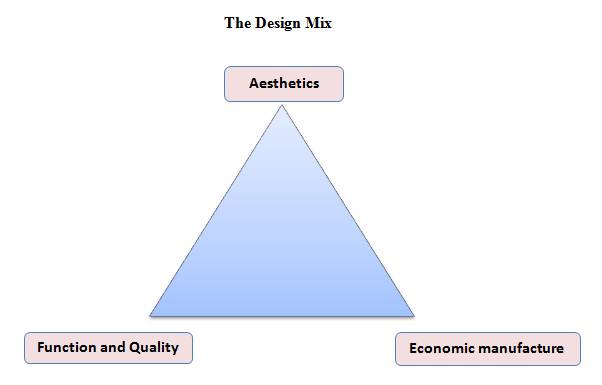
For Gucci, its USP is as a fashion icon, where beauty and aesthetic appeal is paramount. Customers are willing to pay a high price for exclusivity and expensive materials. A Mercedes car is certainly not focused on economic manufacturing, and customers pay for its features and quality, although the brand is also renowned for its attractive and expensive styling. An own brand beer sold in a supermarket has the key selling point of value for money, made possible by mass production.

Place the following products and brands on a design mix diagram.
- A Rolex watch
- A Ferrari sports car
- Kellogg's cornflakes
- A Dell computer
- A Burberry Raincoat
- An XBox
- An iPad
- A Magnum ice cream
New Product Development: Invention and Innovation
Invention and innovation mean different things:
- Invention is the creation of new products or processes. These can be completely novel and untried or may be derived from previous products, but with sufficient new features or technical attributes, that a firm can patent the design or copyright ideas included in the development. Invention often explores the boundaries of possibility, with outcomes that are both uncertain and unknown. As a result there will be more failures than successes. Total invention is difficult, because there are few ideas that others have not considered previously. However, technical advances mean that the opportunities for invention are increasing.
- Innovation is an incremental process where an existing product, process or idea is developed further. New product functions or designs are added to a product range as a means of gaining market share. Innovation in manufacturing is likely to result in lower costs, and therefore, prices
Steven Johnson is the best-selling author of six books on the intersection of science, technology and personal experience and has nearly 1.5m followers on social media site Twitter. His most recent book, Where Good Ideas Come From, examines the sources of innovation. Johnson's view is that innovation is often seen as the preserve of the solitary individual genius working in a laboratory, who has a Eureka moment and discovers the new miracle cure or process to solve a long-standing problem. Though this may happen in rare cases, Johnson believes this is very much the exception rather than the rule.
In the chapter on "Serendipity," Johnson explains how and why a pattern of what he characterizes as a "slow hunch" can crystallize into a "dream-inspired epiphany." He suggests a phenomenon of co-creation where an accidental, but beneficial connection of ideas plays a lucky, but ultimately crucial role in the process of creation and innovation. In other words individuals with similar ideas meet, often by chance, and by sharing thoughts and processes create novel solutions that they may never have discovered on their own. The role of social networks, such as Facebook, can accelerate this process.
"[Good ideas] come from crowds, they come from networks... when you go back and you look at the history of innovation it turns out that so often there is this quiet collaborative process that goes on, either in people building on other peoples' ideas, but also in borrowing ideas, or tools or approaches to problems.
The internet was not commercially useful to most ordinary consumers for 30 years really. It was in a sense a 30-year-hunch. It was providing other services in that time but in terms of the ordinary consumer and the payoff for investment it took a long time."

Johnson recently explained his ideas in a TED presentation which has been animated by RSA:
Product development: the good, the bad and the ugly
There are many commercial risks associated with new products, whether they are an adaption of existing designs or a completely new concept. Most new products fail in the marketplace. Ironically, in some cases failure is because the firm is too far ahead of the market in terms of perceived need. Customers may not fully understand the technology, or indeed the requirement that the product satisfies. The market is littered with failed inventions, where customers were not yet ready for the change in their behaviour or lifestyle that the product required. As Theodore Leavitt explained, customers rarely want the product itself; what they want is a solution to a need or problem.
Time magazine features its 50 best inventions of 2010 including some of 'the year's biggest (and coolest) breakthroughs in science, technology and the arts'. The list includes potential life changing ideas that we all crave and others that we may not. One of the products featured is the Chinese straddling bus, set to revolutionise public transport. Another is an invention that may not please your teachers; a rather colourful androgynous bot - robot that is - set to teach English in 18 South Korean schools. Is it possible that the red-lipped, punk hair-styled android is set to replace the human teacher in the classroom?
No new invention collection is complete without the latest version of the jet pack. This has been part of our vision of the future since the 1920s. The Time site includes a short visual history of the jet pack.
Other exciting new product developments include spray on clothes, body-powered devices and a laser especially designed to zap mosquitoes through the signature of their wing beats. The question is which of these innovations will actually make it commercially? Well since the list includes the iPad, it is safe to say at least one!

Written assignment
Select one of the Top 50 Time Magazine Inventions of 2010.
- Using suitable examples distinguish between the terms 'invention' and 'innovation'.
- Explain how the selected product's USP can be used to identify possible target markets.
- Analyse the role of branding in the successful commercialisation of this product.
- Evaluate the methods of market research that can be conducted to support its launch.

The following video details the 50 best inventions of 2010:

The 5 worst inventions of 2009 as rated by time Magazine
The following is a light-hearted look at failed inventions:
New product development
New products can take a very long time to develop. Firms will often refer to this as 'time to market'. Clearly, the longer this time is, the less likely the firm will be to gain a competitive advantage unless they can protect the product design or creative ideas through patents and copyrights. New product development (NPD) is crucial for firms, as existing products will eventually lose their appeal and demand will fall. New products are required to replace existing declining products, so that the firm can continue to grow. It is important, therefore, to have a range of new products in the pipeline at any time.
If you would prefer to view this interaction in a new web window, then please follow the link below:
New product development - case study

The video recorder wars: The winning formula
A battle took place in the mid 1970s between manufacturers of video cassettes and their associated players. Although Philips was first to market with its Video Cassette Recording system released in 1972, Sony, as with its Walkman concept, was first to really attract the market with its Betamax video format released in 1975. It quickly gained market dominance until challenged by JVC's VHS. These two formats were joined a year later by the Philips V2000; all of these system being incompatible with each other. The Philips machine despite having several superior features never really gained significant market share - not all of the superior features were offered on the cheaper Philips models, which also suffered from poor video quality and a lack of mechanical reliability. For all these reasons the format never gained substantial market share and was withdrawn in 1985, leaving the Sony and JVC to battle it out for video supremacy.
Sony was confident that its superior performance and high market share would see it defeat the new JVC upstart, but it made the cardinal marketing blunder of not responding to the needs of its potential customers.
Although consumers were impressed with Sony's marketing and the quality of its players, they wanted something quite different. Sony initially restricted the recording time of its player to one hour; suitable for television programmes, but not for the recording of films which formed the basis of a growing video rental market. Movie and video studios turned their backs on Sony and JVC were able to offer by far the largest range of rental titles on its 'Long Play' system. In addition, consumers wanted an affordable video player. JVC had made the decisive strategic move of licensing its technology to a range of electronic manufacturers; competition between which kept the price of VHS recorders well below that of Sony's machines. Despite the perceived quality advantage of the Sony, demand was price sensitive and by 1981, the market share held by Betamax tapes had fallen to below 25%.
In 1988, Sony began to market its own VHS machines and at that point it was evident that the Betamax format was dead. In recent years, both Betamax and VHS have been replaced by DVDs. The last Sony Betamax machine was manufactured in 2002 and the last dedicated JVC VHS unit was produced in 2007.

Question 1
Define the following terms:
- Market share
- Licensing
Question 2
Explain the importance of research and development in the process of new product development.
Question 3
Analyse the relationship between the product life cycle and the marketing mix.
Question 4
Research the format war between Sony and JVC and answer the following question:
Using the example of the video recorder market discuss whether Sony could have maintained the competitive advantage of its Betamax format over the rival VHS system.
Product life cycle
Seven Ages of Man
"All the world's a stage, And all the men and women merely players; They have their exits and their entrances; And one man in his time plays many parts, His acts being seven ages.
 At first the infant, Mewling and puking in the nurse's arms; And then the whining school-boy, with his satchel And shining morning face, creeping like snail Unwillingly to school.
At first the infant, Mewling and puking in the nurse's arms; And then the whining school-boy, with his satchel And shining morning face, creeping like snail Unwillingly to school.
And then the lover, Sighing like furnace, with a woeful ballad Made to his mistress' eyebrow.
Then a soldier, Full of strange oaths, and bearded like the pard, Jealous in honour, sudden and quick in quarrel, Seeking the bubble reputation Even in the cannon's mouth.
And then the justice, In fair round belly with good capon lin'd, With eyes severe and beard of formal cut, Full of wise saws and modern instances; And so he plays his part.
The sixth age shifts Into the lean and slipper'd pantaloon, With spectacles on nose and pouch on side; His youthful hose, well sav'd, a world too wide For his shrunk shank; and his big manly voice, Turning again toward childish treble, pipes And whistles in his sound.
Last scene of all, That ends this strange eventful history, Is second childishness and mere oblivion; Sans teeth, sans eyes, sans taste, sans everything."
William Shakespeare - 'As You Like It'
Marketers like to compare the life cycle of a product to that of the human life cycle. Although the analogy may lack some substance, the stages of the product life cycle do mimic that of humans. Products, like human beings, are conceived and are born. Like humans, as time passes, products move through infancy, grow and reach maturity and like humans they will eventually decline and die. Like humans death may happen suddenly at any stage. However, unlike a human, a product's life is measured in terms of its sales and there is also a possibility that a product may be reborn, which unless you believe in reincarnation will not happen to a human! In addition, the speed at which a product moves through its life cycle may vary considerably.
The stages are of this product life cycle are illustrated in the diagram below:
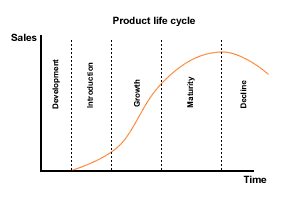
Figure 1 Product life cycle
This is a simple product life cycle diagram. The sales revenue line shows growth from introduction through to maturity, but declines in 'old age'. When starting the product on its life journey the firm will incur negative cash flow as money has to be invested in developing the product before launch and then more used to support it heavily in its infancy to ensure the market grows. This negative cash flow could turn into a loss if the sales revenue of the product fails to grow to cover the expended costs.
If sales grow as forecast, the cash flow should eventually become positive during the growth phase as sales revenue grows faster than costs. Once the product gains a significant market share and enters maturity the positive cash flow should increase to its maximum. How long the firm is able to maintain its product in maturity varies according to a range of external factors including competition, economic growth and social and cultural changes.
Successful firms will recognise that they will need to change their marketing strategies as a product moves through its life cycle and in the following sections we will examine some of these possible changes. However, the problem is recognising which stage the product actually is in. If the firm mistakes the stage it may make changes which endangers the product and may quicken its decline. For example, if sales begin to fall, the firm may assume that the product is moving into its decline phase and reduce marketing support. However, the fall in sales may have been caused by factors which may be temporary such as an economic recession.
Product life cycle - interactive diagram
For more detail on each of the various stages of the product life cycle, follow the links on the below diagram.
If you would prefer to view this interaction in a new web window, then please follow the link below:
Product life cycle - case study (1)

Glaxo and Zantac; the stomach ulcer miracle!
10% of adults will suffer from a stomach ulcer at some time during their lives; a massive potential market and one that large pharmaceutical companies spent millions of dollars in pursuing. Several remedies were launched onto the market, but by far the most successful was Zantac produced, and then patented, by Glaxo. The returns for Glaxo were huge and fully justified the investment on research and development. Three years after its approval by the US Food and Drug Administration (FDA), Zantac had become the largest prescription drug in the world with annual sales revenue of over $1 billion.
However, for every Zantac there will be tens of thousands of costly failures.
For a detailed summary of the development of Zantac, read the article Zantac - protected and profitable. You can view this in the window below, or follow the previous link to open the article in a new window and then answer the questions that follow.

Question 1
Define the following terms:
- Patent
- Generic product.
Question 2
Outline the advantages and disadvantages of manufacturing 'me-too' products.
Question 3
Analyse the relationship between the product life cycle and the marketing mix for prescription drugs such as Zantac.
Question 4
Discuss the problems of financing research and development in the pharmaceutical industry.
Product life cycle - case study (2)

3D Television
Read the article 3D TV dominates IFA electronics show You can either read the article in the window below and answer the task below, or follow the previous link to open the article in a new window.

Write a brief report identifying the marketing behaviour of manufacturers of 3D televisions as they launched their new products onto the market.
Product life cycle - case studies (3)

Maturity - case study 1
Faced with increasing competition from Pepsico, Coca-Cola incurred the wrath of its core customers by changed the formula and the taste of its existing Cola for the first time in 99 years, to create what was referred to as 'New Coke'. This change was met by a 'firestorm of consumer protest' as Coke describes it on their website. The protest lasted for 79 days until Coca-Cola capitulated and reinstated the traditional formula now branded 'Coca-Cola Classic'.

You can read more about The Real Story of New Coke on the Coca-Cola website, either in the window below, or by following the previous link to open the article in a new window.
Notice that even in this apparent comprehensive history of the product, Coca-Cola find it impossible to mention Pepsi by name!

Maturity - case study 2

Kelloggs advert

Identify the nature of the promotion being employed by Kellogg's and why this is suitable for the product given its stage in its product life cycle.
Product life cycle - extension strategies
Firms will wish to extend the profitable life of a product for as long as possible. To do this they will often introduce extension strategies to delay a product's decline.

Extension strategies
Extension strategies are marketing techniques designed to extend a product's life cycle and delay its decline. An extension strategy will involve amendments to the marketing mix such as upgrading or updating the product, changing the packaging or presentation, adding new features or new design elements or lowering price.
Figure 2 shows the impact of the extension strategies on the product life cycle.
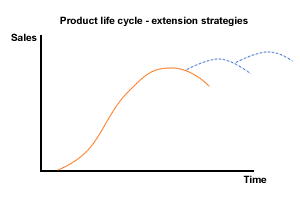
Figure 2 Product life cycle - extension strategies
If the firm decides to continue selling the product as it reaches saturation or enters the decline phase, it is likely to extend the life of the product by changing aspects of the marketing mix to rejuvenate the offer. Strategies will include:
- Repackaging and new sizes: the appearance of the product can be crucial gaining a customer's attention and developing interest
- New formulas
- Additional features
- Lower prices to maintain interest or liquidate surplus stock
- New advertising campaigns
- Altering the channel of distribution, such as online shops
- Finding new markets - this may be locally, nationally or internationally.
The product life cycle & cash flow
The cash flow from a product as it moves through its life cycle will change. Initially high development costs and high promotional costs will mean a negative cash flow, but as the products moves through the growth phase and into maturity, the cash flow should start to become positive. This is shown in figure 1 below.
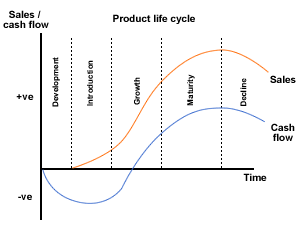
Figure 1 Product life cycle and cash flow
As a product moves through its life cycle the price elasticity of demand will also tend to change - this is shown in figure 2 below. As a product becomes more mature, it is likely that competition in the form of substitute products will increase which should make the demand more price elastic. This may well reduce the profit margin the firm earns on the product unless they are able to reduce costs correspondingly.
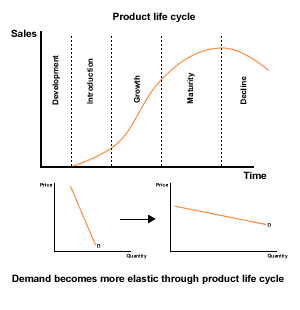
Figure 2 Product life cycle and elasticity
The product life cycle and product diffusion
Product Diffusion Curve
Consumers can be grouped according to how quickly they are willing to adopt a new product. Some consumers look for new products because they desire to be perceived as innovators and see possession of new products as providing social kudos. Innovators will adopt a new product as soon as it becomes available. At the other extreme, certain consumers will be reticent to adopt any new product until totally proven. These laggards will be the last to purchase.
If you would prefer to view this interaction in a new web window, then please follow the link below:
The Roger's diffusion model has been criticised for being not only simplistic, but empirically unproven. Rogers focuses on individual personality such as risk taking behaviour and levels of education, but ignores the role of social influence in product diffusion. Viral marketing is a perfect example of social influence in action.
Not only is Rogers model criticised for its narrow focus, but also because individuals are not consistent in their purchasing behaviour. It appears from research that consumers are innovators not because of their personal traits, but simply because they are one of the first 2.5% of purchasers of a new product regardless of their demographic, socio-economic, or personality characteristics.
Indeed, Philip Kotler argued in Marketing Management (1991) that:

No one has demonstrated the existence of a general personality trait called innovativeness. Individuals tend to be innovators in certain areas and laggards in others.
Nonetheless, despite its apparent weaknesses, understanding of the Roger's model is useful for several reasons, it:
- highlights the fact that purchasers of a product will change over time
- links neatly with the product life cycle
- demonstrates that the marketing mix should change as a product moves through its life cycle
- illustrates that the market mix is never a static formula.
Product adoption - case study

New technology markets provide excellent examples of different types of consumers and their adoption habits. Below is an excerpt from the 2010 stakeholder report by Ofcom (The independent regulator and competition authority for the UK communications industries). This report identified the following trends:
There was also a significant rise in the take-up of 3G mobile connections and increasingly sophisticated smartphones that offer broadband-like connectivity in a handset. Nearly one third of consumers are now using the 3G network's higher-bandwidth capabilities and with one in four claiming to own a smartphone in Q1 2010. This compares to one in five and one in seven respectively in Q1 2009. In contrast, the proportion of homes using fixed-line telephony fell during 2009, down two percentage points to 85%, reflecting an increase in the number of mobile-only households.
The number of homes with digital video recorders (DVRs) continued to increase sharply during 2009, rising from 27% to 37%, while the proportion of homes with Blu-ray/high definition DVD players increased by six percentage points to 17%.
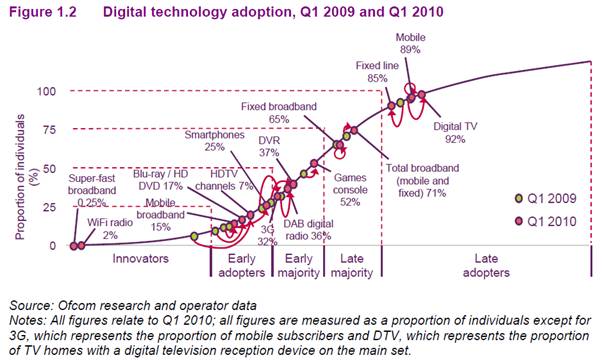
Source: Ofcom Stakeholder Report

1 |
Product life cyclePut these phases of the product life cycle in order from the start of the product life cycle to the end. |
Product portfolio analysis
Most firms will have a portfolio of products on offer to their customers, rather than individual products or brands, and will in many cases have branded products which complement each other is some way.
To maintain, or improve profitability, it is advisable for a company to have products at various stages of their life cycle.
A firm will gain a reputation for developing and exploring its core competence in the production of a certain types of product. Ford, for example, is known for its cars and not for any other unrelated products. However, some multinational conglomerates may offer a huge number of diverse, unconnected goods and services.

![]() The Mitsubishi group of companies is an example of a conglomerate with many divisions unconnected in terms of output. The group consists of 315 separate independent companies within five distinct divisions with a very broad product portfolio:
The Mitsubishi group of companies is an example of a conglomerate with many divisions unconnected in terms of output. The group consists of 315 separate independent companies within five distinct divisions with a very broad product portfolio:
- Motors
- Banking
- Chemicals
- Heavy Industries
- Corporation
The Mitsubishi Corporation division itself employs over 50,000 people and has seven business segments including finance, banking, energy, machinery, chemicals and food.

Prepare a short summary of the Mitsubishi group using facts and figures to support your outline:
Describing how the businesses within the Mitsubishi Group are organised.
Outlining the activities of the separate Mitsubishi Corporation division, with examples of some of their activities

product portfolio
A product portfolio is the range of products manufactured or supplied by a firm.
Having a broad product portfolio allows the business to spread its risks because as one product declines in a portfolio another may take its place.
Product portfolio analysis is used to assist in planning product development and strategy by:
- analysing an existing portfolio to decide which products should receive more or less investment, and
- adding new products to the portfolio or deciding which products and businesses should be eliminated.
The best product portfolio is one that fits the company's strengths and helps exploit the most attractive opportunities.
The business portfolio refers not just to products, but also to the collection of separate businesses and/or strategic business units (SBUs) that make up the firm. The term Strategic Business Unit was developed in the 1960s, to classify General Electric's many business units.

SBU
A SBU is a business division within a large organisation, which shares the organisation's market and customer focus, but is distinguishable because it is a relatively independent with a coherent set of products, objectives, strategies and competitors.
An SBU is a set of product divisions that manufacture interrelated or similar products. The main philosophical concept behind the formation of strategic business units is to serve a clear and defined market segment along with a clear and defined strategy.
Therefore, to be considered an SBU, a business unit should:
- possess its own separate mission distinct from the mission of other SBUs in the group
- develop its own integrated plans separate from those of other SBUs
- have a definable group of competitors
- manage its own resources.
For example the Coca-Cola Company in the UK is organised into six geographic SBU's.
The Boston Consulting Group (BCG) matrix
If you would prefer to view this interaction in a new web window, then please follow the link below:
The ideal product portfolio is likely to be balanced with a mixture of problem children, stars and cash cows, but not dogs (unless they have a purpose in completing the firm's offer). Firms need new products in the pipeline, but also require cash cows to generate funds for researching and developing new products and for turning question marks into stars. Too many question marks and stars may lead to cash flow problems for a firm and so it must be selective in developing products.
There is an assumption in BCG analysis that fast growing markets and high market share are always preferable as these generate higher profit levels. Certainly the higher the market share, the more cash will be generated, and as a result of the economies of scale the greater the potential profits.
However, it is possible for firms to be very profitable by:
- developing niche products in a large market segment
- introducing innovative technologies or design which change the nature of the market. A perfect example of this is Dyson's entry into the vacuum cleaner market.
There are links between the BCG and the Product Life Cycle:
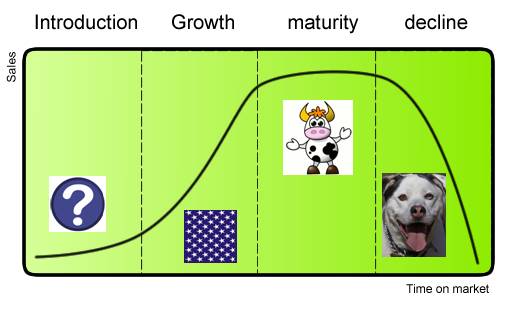
However, it is best to be careful as to how this is used. It is possible that a Question Mark is not early on in its life cycle - it might just have a low market share in a large market. In general, however, the connection is appropriate and the strategies employed when a product is in its infancy will be suited to Question Marks as will products in the growth (Stars), maturity (Cash Cows) and decline (Dogs) stages.
Using the BCG matrix
If you would prefer to view this interaction in a new web window, then please follow the link below:
Using the BCG matrix leads to a range of strategic options, which have been summarised in marketing literature through the use of agricultural analogies. These strategic approaches include:
- Sow: heavy investment in research and development and in significant promotion to raise customer awareness.
- Nurture: maintain heavy investment to develop greater market share and to expand distribution into new markets.
- Harvest: using healthy cash flows to fund the development of other products in the product portfolio.
- Plough or divest: either stopping sales or production of the product or selling the product to another business.
These approaches can then be applied to products in the four quadrants of the BCG matrix.
- Question marks: The likely strategic approaches are to sow or plough (divest). If research indicates that the product has been received well by the market and gaining customer loyalty, cash may be invested to increase market share and distribution networks. The firm may seek new markets and/or distribution channels. These Question Marks are, therefore, high cash users.
However, if sales are stagnant and the product does not seem to be satisfying customers, the firm may decide to pull the plug on the product altogether before it drains the finances of the firm further. Alternatively, if the product has a future, but the firm cannot, or does not want to make the required investment it may choose to sell the patent, brand name or design to another firm.
- Stars: Stars have the potential to become Cash Cows, but require further investment to gain further market share. Firms will nurture these products through expenditure on marketing initiatives such as advertising campaigns, joint ventures with other firms and penetrating new markets. Revenues are high, but so are costs.
- Cash Cows: Cash cows have high market share and customer loyalty. Sales are high, and there is less marketing support required because customers have a good understanding of the product and are often loyal. The high sales provide significant economies of scale so average unit costs are relatively low. Profit margins, as a result, are likely to be high and the product is a major cash generator. These funds can be harvested to fund investment into research and development and question marks.
Cash cows may remain in the maturity stage for many years but eventually they will begin to decline. The firm will have to decide at that stage, whether to introduce extension strategies. These strategies may be expensive
- Dogs: Sales revenues from Dogs tend to be low, although cash expenditure may be low as well, making them essentially cash neutral. However, revenues may become so low that the product is making losses and the firm may be wise to plough it - in other words to drop it completely from their portfolio. If there is some value left in the product the firm may seek to sell the rights to it to another firm or at least sell some of the assets used in the production process, such as tooling and equipment. This process is known as divestment.
Branding
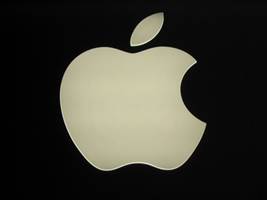
Branding is the way in which a firm differentiates itself and its productsfrom those of their rivals. The term originated from the use of a hot iron to leave a mark on livestock to prove ownership.
So what exactly is a brand? The Dictionary of Business and Management describes a brand as:

Brand
A brand is a name, sign, colour or symbol used to identify items or services of the seller(s) and to differentiate them from goods of competitors.
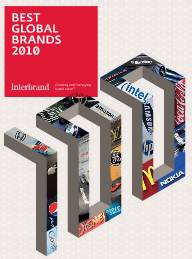
Firms will always attempt to protect their brand name as this may be their most valuable asset. Coke is ranked best global brand in 2010 by brand consultancy Interbrand for the 11th consecutive year, with a value estimated at $70.7bn. IBM was remained in second place up 7% from 2009 to $64.7bn, while Microsoft retained third place on $60.9bn. Google climbed from seventh to fourth place and increased its brand value by 36% to stand at $43.5bn
![]() An unregistered trademark is recognised by the letters TM - although unregistered the firm may still be protected from other firms using the brand name under misrepresentation laws, although protection may only operate within in the geographical area where it has been used.
An unregistered trademark is recognised by the letters TM - although unregistered the firm may still be protected from other firms using the brand name under misrepresentation laws, although protection may only operate within in the geographical area where it has been used.
 Once legally protected a brand name becomes a registered trademark. The owner may take legal action for trademark infringement to prevent unauthorized use of that trademark.
Once legally protected a brand name becomes a registered trademark. The owner may take legal action for trademark infringement to prevent unauthorized use of that trademark.
Brand names may be supported by catchphrases, slogans and logos that provide visual or auditory recognition for the product:
- symbol - Nike swoosh
- logo - Microsoft graphic
- a character - Frosties Tiger
- a sound - Intel inside
McDonalds, for example, combines a well recognised brand name with its Golden arches logo and the slogan "I'm lovin' it".
Much research has taken place on the psychological meaning of a brand. Brand experience refers to customer's thoughts, feelings, perceptions, beliefs and attitudes when they make their purchase. Over a period of time if these emotions are shared they combine to build into a brand image, with which loyal customers identify. Ideally, if a firm has marketed its product successfully, customers will use positive descriptors like 'trust, value, modern and fashionable' when asked for their opinions of its brand.
Brand names come in many different forms:
- Acronym - a name made up of initials, such as BMW, BP, KFC or IBM
- Descriptive or functional - representing a product benefit like Sparkle window cleaner or Mop and Glo floor cleaner
- Evocative- names that evoke a relevant vivid images like Fairy, Crest or Paramount
- Neologisms- Completely made-up words or phrases like Accenture (derived from 'accent on the future'), Aviva, IKEA or Motorola
- Personal names - products may be named after the original founder such as Chevrolet and Ford or combinations of names such as Adidas (after Adi Dassler)
- Abbreviations - Xerox is abbreviation of the word xerography
- Foreign language terms - Volkswagenliterally means "the people's car" in German
- Mistakes - Google is a misspelling of Googal, a very large number
- Geographical regions or landmarks - like Fuji Film or Olympus (the highest mountain in Greece)
- Myth- many brands use mythical characters like Nike the Greek goddess of victory
- Association - In 1976 Steve Jobs was working in a community farm in Oregon which made him think of Apple
Evidence of a truly successful brand is when that brand name becomes interchangeable with the generic name of the product. For example, people may say things such as:
- "I am going to Hoover the carpet" (vacuum)
- "May I have a rum and Coke" (cola)
- "I'm going to sneeze - pass me a Kleenex" (tissue)
The importance and role of branding
According to Aswath Damodaran, professor of finance at New York University's Stern School of Business, a brand's value is simply about the extent to which it can sell its goods and services at a premium price.
Damodaran believes that marketers often mistake attribute product quality, styling, service and reliability to a brand name's value, when all brand value ultimately comes down to is pricing power.

If you as a company tell me that you have a brand name, I'm going to ask you a question: 'Do you have the power to charge a higher price for the same product? If your answer is no, I don't think you have a brand. You may think you do, but I don't think your brand has any value.
Despite this very narrow interpretation, marketing literature describes the many other benefits associated with strong brands:
- Customers can identify products quickly in a retail environment, especially if the brand has a strong visual identity or logo.
- Brands provide multiple sensory stimuli to enhance customer recognition. A brand can be visually recognised from its packaging, logo, colour and shape. It can also be recognised through sound, such as hearing the name on a radio or TV advertisement or through conversations with other customers who talk about the brand.
- Increased revenues and market share are based on brand loyalty and positive brand associations. Loyal customers are less likely to switch to competitor brands.
- Decreased price sensitivity (low price elasticity of demand) - customers are prepared to pay a premium price for a perceived additional benefit of the brand over its competitors, which should lead to increased profitability.
- Suppliers and manufacturers will have a stronger negotiation position with retailers who know the brand will add to their image and generate reliable sales. As a result a high price may be charged and maintained.
- Increased shareholder and asset value as a result of the intangible value of the brand; the value of this brand equity can be realised by selling or licensing the brand.
- A shared vision among stakeholders focusing on the brand's values, and an increased capacity to motivate the workforce.
- Increased ability to extend the brand into new product and service categories. There are lower risks associated with introducing new products under the same "family" brand, as they are already recognised by customers.
- Increased ability to attract and retain high quality employees who like to be associated with a successful brand (and therefore organisation).
- A brand tends to have a much greater longevity than a product - a brand can be transferred to a related and updated product or version.
- A brand should offer a shorthand summary of all the information customers hold about the product. When customers associate benefits, especially emotional benefits, with a particular brand, it gains significant competitive advantage. Customers trust brands because they know what to expect.

Why not try the 'Guess the logo' game to see how well you know your brand logos?
 The rule of thumb among communications specialists is that about 80% of all human communication is non-verbal, and indeed, much of the meaning of verbal language itself is determined by nonverbal cues. Research shows that approximately 93% of the meaning contained in any message is non-verbal (Mehrabian 1971).
The rule of thumb among communications specialists is that about 80% of all human communication is non-verbal, and indeed, much of the meaning of verbal language itself is determined by nonverbal cues. Research shows that approximately 93% of the meaning contained in any message is non-verbal (Mehrabian 1971).
Furthermore, visual representations are processed differently than verbal messages and are not subject to the same logical scrutiny and counter arguments and as a consequence, brand images such as logos and symbols are more likely to be internalised, with the increased potential of affecting attitudes and behaviour. This is why firms are prepared to spend so much money of rebranding exercises and updating and modernising logos.
Some significant brand redesigns took place in 2009 including AOL, MSN, Hertz and Audi.

You can view the changes in logo in the window below or by following this link.
Branding - activities

Group activity
Working in groups of 3 to 4 people:
Select three of the new designs for the activity that you find most interesting:
- Each individual on their own:
- Analyses why the redesign was necessary
- Chooses 5 words to describe both the old and the new logos e.g. characteristics like 'trustworthy', ' flexible', 'modern', 'dynamic', 'classic', strong', international', 'technological' and 'friendly'.
- Consider why the colour(s) were chosen
Then each individual:
- Compares their analysis and keywords with the rest of the group and explains why they interpreted the logo in the way they did.
- Discusses the similarities and differences between the group members and see an agreement be reached.
Each group share its thoughts with the other groups.
As a large group:
- Examine your school logo:
- Discuss its meanings and it strengths
- Consider whether it could be improved
- Prepare a brief for a redesign
- Select an artistic student or a group of artistic students and commission them to produce a new, or updated, logo (these could be art or design students)
- When the new logo is prepared, discuss whether it meets your brief and why.
Extension Activity

Wolff Olins
Wolff Olins is the creative agency behind some of the world's biggest rebranding strategies. It was the agency that designed the 2012 Olympic logo for the UK, the new AoL logos and many more.
Visit the Wolff Olins site and watch its introductory video, which details some of its major design projects.
Produce a 1000 word report/case study on one of these design makeovers using the Wolff Olins site and further research on the Internet.
Brand development
A firm's brand may be its most valuable and enduring asset which needs to be protected and developed, modernised and nurtured. BrandZ reported in 2010 that consideration of brand in the purchase decision had risen by 20 percentage points since 2005.
Markets are becoming more crowded and competitive and consumers have greater access to more information about products than ever before. Consequently, consumers have more choices and firms need to seek more effective ways of increasing brand awareness and, more importantly, creating brand loyalty. Therefore, one of the most important tasks in a brand's success is an effective branding strategy.

Brand development
Brand development is a marketing approach designed to make a brand more successful by changing it over time to ensure it remains popular and fashionable; and creating a brand strategy for the firm that is consistent with its mission, values, and strategic vision.
Brand development includes changes to key elements of the marketing mix such as the logo and product positioning, as well changes to micro elements such as stationery, typography, colour palettes and signage aligned with the brand's core values. The firm seeks to provide an attractive, unique, and relevant message to current and potential customers, that incorporates an element of positive emotional attachment. The brand's message must stand out from the 'clutter' of the market place and capture the consumer's attention. Large firms will often appoint brand managers whose have responsibilities for specific brands.
Brand development is measured by a brand development index (BDI).

Brand development index
A brand development index compares the percent of a brand's sales in a particular area with the percent of the country's population in that area; so measuring the infiltration of a product's sales, usually per thousand population in that area. If 100 people in 1,000 buy a product, the product has a brand development index of 10% in that area. A BDI indicates where significant groups of a brand's customers live and helps direct marketing efforts.

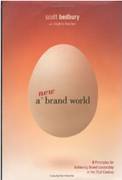 A New Brand World , Eight Principles for Achieving Brand Leadership in the 21st Century (2003) by Scott Bedbury and Stephen Fenichell analyses why certain brands like Nike and Starbucks have succeeded while others have failed. In the following extract the authors attempt to summarise some of the elements that contribute to this success or failure:
A New Brand World , Eight Principles for Achieving Brand Leadership in the 21st Century (2003) by Scott Bedbury and Stephen Fenichell analyses why certain brands like Nike and Starbucks have succeeded while others have failed. In the following extract the authors attempt to summarise some of the elements that contribute to this success or failure:

A brand is the sum of the good, the bad, the ugly, and the off-strategy. If is defined by your best product as well as your worst product. It is defined by award-winning advertising as well as by the god-awful ads that have somehow slipped through the cracks, got approved, and, not surprisingly, sank into oblivion. It is defined by the accomplishments of your best employee - the shining star in the company who can do no wrong - as well as the mishaps of the worst hire that you ever made. It is also defined by your receptionist and the music your customers are subjected to when placed on hold. For every grand and finely worded public statement by the CEO, the brand is also defined by derisory consumer comments overheard in the hallway or in a chat room on the Internet. Brands are sponges for content, for images, for fleeting feelings. They become psychological concepts held in the minds of the public, where they may stay forever. As such you can't entirely control a brand. At best; you only guide and influence it.
One of the ways in which some products maintain a distinct difference is through packaging. Many of us recognise products by their packaging e.g. Kellogg's Corn Flakes. What surrounds a product is a space where the firm can promote all the little things that make the product different from competitors. Firms want people walking into a supermarket and notice the packaging from a distance. So, shape, colour etc. all 'appeal to the eye'. Consumers relate to some colours better than others and shape can be a major influencer in purchasing decisions. A change in any of these can be a boost to sales. It adds fresh life to something that might have been becoming 'tired', but mistakes can be costly.
Developing a brand name for a business
Developing a brand name may prove crucial to the success of a business.

Read the following articles which provide advice as to the choice of an appropriate name:
Brand loyalty

Brand loyalty
Brand loyalty refers to a consumer's habitual preference for one brand compared to other similar available options and is measured in terms of repeat purchase behaviour irrespective of the marketing pressure generated by competing brands.
Brand loyalty is the ultimate goal of any firm and an aim for its marketing effort. If customers are brand loyal they perceive that the brand offers the right combination of quality and price to consistently repurchase and they may even be willing to promote the product though word of mouth advocacy.

What Brand Are You?
This first edition of these topic notes included a link to a website called What Brand Are You? which is no longer available. The idea behind the website was to generate a brand name for a business after the visitor to the site typed in their name, and the 'core values' and goals of their intended firm. The 'supercomputer' would then generate a personalised brand name based on this information. The site was set up by the Design Conspiracy reacting to the increasing number of neologisms (made up brand names), such as Aviva, Corus and Diageo, created by large companies at the time. The site was a spoof as there was no supercomputer, and the names were randomly selected when the user hit the submit button from a list of about 150 names already made up by the founders of the site.
"We were just literally trying to think of the most stupid company names"
Ben Terrett, Design Conspiracy
However, according to a BBC story, twenty of the brand names were later registered as trademarks of real companies including Bivium, Libero, Ualeo, Winnovate, and Tempero. However, there has been doubt cast on this claim as it appears that some of the brand names had been registered before the What Brand Are You? site went live on June 11 2002. This confirmed by searching whois.org, the domain name information site, which reveals, for instance, that the domain name for Winnovate was registered before this on June 15, 2001.
You can read the BBC article about the site, Spoof brand names picked up for real in the window below, or follow the previous link to open the article in a new window.
Types of branding

If you would prefer to view this interaction in a new web window, then please follow the link below:
U.S. Store Brands - How Deep is the Love?
According to Nielsen, three-quarters of U.S. households believe store brands are a good alternative to name brands and nearly two-thirds of households say that store brand quality is just as good as name brands. (A C Neilson October 8, 2010)

Task
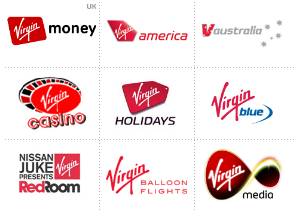
Why not investigate company brands a little further. Visit the Virgin web site and see how many different products and services they produce under the Virgin brand name. How many did you find?
Hint - when you are looking at a company site for financial information or general information about the firm, always look for a link to 'Investor information' or 'Corporate information' or 'About us'.

1 |
Family brandsFamily brands are best described as: |
Global Brands
Multinational organisations have a choice when it comes to marketing their products in the global market place. They can choose to focus on each individual market using an adjusted strategy and selling under different brand names or they can use the same brand name and marketing approach in every market.
Local branding has the advantage of identifying local tastes, fashions, beliefs and conditions and allows customers to believe that the product is locally manufactured or produced.
Global brands are brands that are recognised throughout much of the world and firms employing this unified approach use a similar marketing strategy to support the brand and its development everywhere. This ensures consistency in presenting the brand's values in all of its markets. The advantage of a global brand is that the firm can gain from marketing economies of scale. For example, the same advertising strategy can be employed worldwide using the same celebrities, words and images. With the massive global growth and development of the internet, presenting a unified image through a standardised brand has become increasingly popular.
Successful global brands focus on presenting a unique, meaningful, and enduring image to its target market, which can be adapted to local demands. Maintaining a consistent global approach allows consumers to find and understand the brand wherever they are and creates global brand loyalty. For example, McDonalds stores worldwide offer very similar menus (although there may be some adaption to local tastes) in restaurants with clearly recognisable design features.
Perhaps it is not surprising that the brands with the highest asset value, and those which have had the largest increases in value, operate as single brands worldwide. Obvious examples of these can be found from the top brands in both the Interbrand Top Global brands and the BrandZ rankings. Brands such as Coca-Cola, Microsoft, IBM and McDonalds use the same image, logos and visual wherever they are marketed.
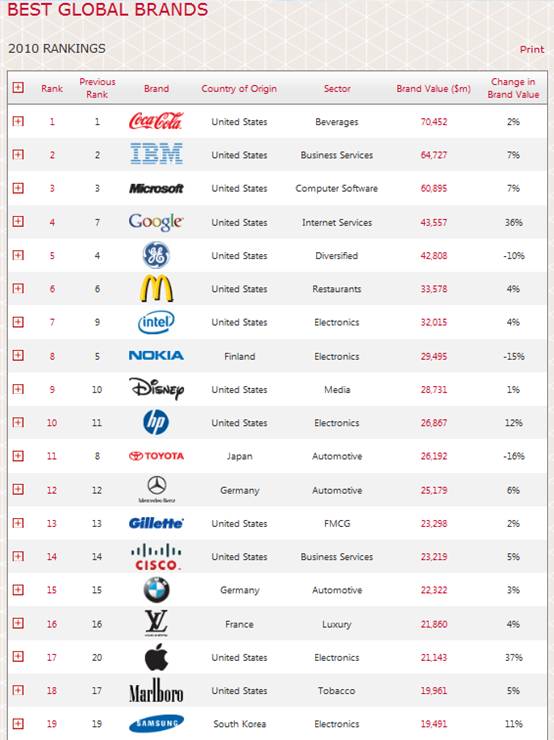
Well known brands in one national market may not be so in another, so the firm may need to raise awareness in some markets of their brand, whilst reinforcing brand values in others. Tesco found that it could not rely on brand recognition that it enjoyed in the UK when it expanded in Eastern Europe and as a result had to invest heavily in raising brand awareness in these new markets. They have taken a slightly different approach in their expansion into China accepting the need to enter into a number of joint ventures to improve brand recognition.
"Think global, act local" is the mantra for international companies of all shapes and sizes that have a global reach, but an awareness of local needs and aspirations.
Glocal branding is where a business acts like an international brand while behaving like a local one. To 'glocalise' a brand is to think globally and act locally. HSBC have built a long-standing advertising campaign based on this idea of being a local global bank, which accepts and promotes difference.
Market segmentation by brand recognises that consumers have differing lifestyles, attitudes about a promised benefit varies by target and geography. A brand can maximize its opportunity in virtually every locality by tailoring its message to the needs of local audiences.
According to a Malaysian Star report:

Worldwide consumer research found that while people appreciated the value of international organisations and services, they questioned the prevailing 'One size fits all' global model...
Consumers wanted to be treated as individuals and to feel that the companies cared about them, recognised their needs and understood what makes their community unique.
Synovate, the market research arm of Aegis Group plc, provides marketing solutions and employs over 6,000 staff across 62 countries. It makes a point of pointing out that it has no head office and that it offers local solutions backed by a global infrastructure
There may, however, be some problems with language and translation when a firm tries to turn its national brand into an international brand.
There are several potential problems a company's brand name and/or marketing slogans, could face in other countries and languages. The brand name:
- has a negative, unpleasant, offensive, suggestive, or embarrassing meaning in the target country
- has a spelling or pronunciation with negative connotations in the target country
- is already in use in the target country
- is difficult or impossible to pronounce in the target language
- has associated images or colours with inappropriate meanings in the target country
Marketing blunders

Marketing blunders
The Coca-Cola name in China was first read as "Kekoukela", meaning "Bite the Wax Tadpole". Coke researched 40,000 characters to find a phonetic equivalent "kokoukole", translating into "Happiness in the Mouth."
Pepsi also had problems with Chinese when their slogan "Come Alive with the Pepsi Generation" was translated for a Taiwanese billboard as "Pepsi brings your ancestors back from the dead."
KFC (Kentucky Fried Chicken) found that its "Finger-Lickin' Good" slogan was translated into Chinese as the command to "Eat Your Fingers Off."
General Motors made a marketing error when trying to market the Nova car in Central and South America. "No va" in Spanish means, "It Doesn't Go".
The Swedish car magazine Fart (meaning "speed" in Swedish) probably planned to remain in Sweden, so it failed to anticipate the reaction when it covered international racing events.
Traficante is an Italian brand of mineral water. Unfortunately, in Spanish it means drug dealer.
The Coors slogan "Turn it loose" in Spanish, became "Suffer from diarrhoea."
Even such renowned a brand as Rolls Royce can make marketing mistakes. The Rolls-Royce Silver Mist never sold well in Germany, possibly because in German, mist means "human waste."
Even though countries share the same language, meaning can become complicated by nuance and dialect. Following great success in the UK with a tagline in the UK, vacuum manufacturer Electrolux decided to use it in their American market, not realizing the alternative meaning of a key word: 'Nothing sucks like an Electrolux.'
Samarin, a Swedish over-the-counter remedy for upset stomachs produced an advert in the form of a comic strip with no text. There were three pictures. The first was a man looking sick, grasping his stomach; the second picture showed him drinking a glass of Samarin and in the third picture he was smiling again. The advertising campaign campaign proved successful in Europe. However, when Samarin ran the advert in Arabic-speaking newspapers they did not do as well because they did not appreciate that in those countries people read from right to left.

Brand-as-person
Brands can be seen in terms of a brand-as-person model. Some of the relationship you might have with people sharing those relationships are described below:
| Type | Characteristics | Example brands | Relationship model |
| Conservative | Trustworthy, old-fashioned, sincere | Marks and Spencer, AGA, Kodak, Guinness | Like that with a respected member of the family |
| Exciting | Fashionable, outgoing, young, fun | GAP, Nokia, Mini, Red Bull | Like the sort of person you would like to spend an evening or weekend with |
| Competent | Accomplished, able skilled, influential | Financial Times, BBC, IBM, Volkswagen | The relationship with a teacher or business leader |
| Sophisticated | Wealthy, stylish, pretentious | Mercedes, Harvey Nichols, Vogue, Mont Blanc | The relationship with a wealthy relative, or a powerful boss |

You can read more about the psychology of branding on the two 'whitepapers' on the excellent brandmaster blog.
- Brand and Corporate Personality as Relationships - systems theory
- Brand Dynamics and Eco-motive strategies
What a makes a brand successful or not and how can we compare the characteristics of brands and produce a pictorial representation of its strengths and weaknesses? One method is suggested on a brandmaster blog post. You can read this in the window below or from the previous link and then answer the questions that follow.

A final thought on this section - could you manage without buying branded goods? In 2006, Neil Boorman attempted to live for a year without brands and started this year with a bonfire of all his branded goods in central London.
This BBC article describes his feelings at the end of that year.
You might want to visit his blog Bonfire of the Brands which has become a homage to anti-consumerism:

Through the routine use of psychology in advertising, many brands now embody goals and values in life towards which we must strive. We proudly wear the logos of companies on our chests to identify where we come from, who we are and more importantly, who we want to be. The manufactured values of company brands have become our own.
I believe that brands have begun to mean too much. The symbol of a sports shoe manufacturer should not embody freedom. We should not be defining ourselves simply by the logo on our cars. In doing so, we hand over our identity and our self-worth to companies whose existence are geared not towards quality of life, but towards profit.
Neil Boorman
4.3 Product - questions
In this section are a series of questions on the topic - Product. The questions may include various types of questions. For example:
- Self-test questions - on-screen questions that give immediate marking and feedback
- Short-answer questions - a series of short-answer questions to help you check your understanding of the topic
- Case study - a case study with associated questions
- In the news - questions based around a topical business news article
Product life cycle & product portfolio- self-test

1 |
Product developmentHow many stages does a product normally pass through when it is under development? |
2 |
Product positioningYou might use a product positioning map to: |
3 |
Product life cycle and cash flowWhich of the following explains why it is normal for a new product to record a negative cash flow when it is starting its product life cycle? |
4 |
Extension strategyWhat is meant by the term 'extension strategy'? |
5 |
Boston MatrixWhich of the following does NOT appear within the Boston Matrix? |
Product - case study

Martha's Soaps began when her young daughter developed a skin complaint and it was traced to her having used a certain well-known brand of soap. Martha decided that soaps made only from natural ingredients would be a market winner. She developed a range, which were relatively expensive, but nonetheless sold well. Eventually, she was selling over half her output to just one large 'high street' retailer. Such a large exposure worried Martha, especially when the main buyer reported that it was undergoing a complete value assessment of its product range. This resulted in the buyer agreeing to order at the previous year's quantities only if prices were lowered, but quality maintained. The ingredients could not be lowered in price, although after careful research and negotiation packaging costs were reduced and Martha met her main client's requirements. However, she knew that she had less than a year to develop a lower cost production process and ingredients list to meet future demands for lower prices.

Question 1
What, in your opinion is the main value aspect of Martha's soaps?
Question 2
By adopting a more detailed value analysis, how might Martha be able to meet next year's requirements?
Question 3
Evaluate Martha's strategy of cutting costs to retain orders from its major buyer.
Product portfolio analysis - short answer questions

Question 1
Advise an ice cream manufacturer on the advantages and disadvantages of using a Boston Matrix before re-launching and developing their existing product range.
Question 2
At the monthly marketing meeting for 'Toys were Us', the marketing director made the following statement:
'Yes we have had some dogs, but we look carefully at product plans and aim to get as many cash cows as possible. Although this takes time and money it means we seldom get it wrong. Kids like our toys and parents trust them. It's a long process, but the result is that we now have a stable of stars.'
- Define the following terms:
- Dog
- Star
- Cash cow
- Explain how this toy manufacturer may have created its portfolio of 'star' products?
- Analyse marketing approaches to maintain their cash cows' popularity.
- Evaluate strategies for dealing with dog products
Product branding - short answer questions

Question 1
Outline what the main responsibilities of a Brand Manager.
Question 2
Explain the methods available to maintain customer loyalty for an established brand of breakfast cereal.
Question 3
Analyse marketing strategies to build brand recognition for a new chocolate fruit bar using fair-trade and natural ingredients.
Question 4
Design a marketing strategy for establishing a wider diffusion of the market for your range of specialist Indian Foods. They are sold in long-life vacuum-sealed plastic pouches and are priced at the mid to top end of the market.
Product positioning - short answer question

Question 1
Examine the marketing strategies that a new entrant to a market could use to differentiate its (a) perfume (b) yoghurt (c) sports shoes from those of its major, more established rivals.
Vorsprung durch Technik
Audi known for its catchphrase, progress through technology, is employing cutting edge marketing techniques to promote its new Audi A1 model. Audi's corporate strategy is to place itself firmly in the same premium brand category as its rivals such as Mercedes and BMW.

Read the articles:
- The strategy of the Audi A1 starts running
- A1 Augmented reality
- Spanish Mobile Advertising Campaign For Audi Sees 50,000 Impressions In A Matter Of Days
(you can do this in the windows below or follow the previous links to read the articles in a separate window) and then consider answers to the questions below.

Question 1
Describe the importance of innovation in the car market
Question 2
Outline Audi's marketing approaches for the Audi A1.
Question 3
Analyse the advantages and disadvantages for Audi if the demand for the Audi A1 exceeds production capacity.
Question 4
Evaluate the use of cutting edge marketing technologies to achieve Audi's corporate vision of "Audi: the number one premium brand,"
Branding - is it becoming a joke?
Read the article Has branding become a joke? (you can do this in the window below or follow the previous link to read the article in a separate window) and then consider answers to the questions below.

Question 1
Identify and explain three different types of branding.
Question 2
Explain why "brand valuation [is taken] into account when working out how much a corporation is worth".
Question 3
Analyse the importance of the logo as part of an overall branding strategy for a firm like Coca-Cola.
Question 4
Discuss the importance of branding as part of an overall marketing strategy.
Answering the call of nature in Lagos
Read the article Answering the call of nature in Lagos (you can do this in the window below or follow the previous link to read the article in a separate window) and then consider answers to the questions below.

Question 1
Define the term 'niche market'.
Question 2
Explain how marketing in a niche market differs from marketing in a mass market.
Question 3
Prepare a SWOT analysis for Dignified Mobile Toilets (DMT).
Question 4
With reference to the SWOT analysis prepared in question 3 and the article develop a marketing strategy for DMT.
AOL rebrands as Aol

We have a new mission: to inform, entertain, and connect the world - not with more of the same but with extraordinary content experiences. The internet has become tired and lazy and needs better quality content.
This is an ambitious mission, and we have a lot of work to do, but unlike most 21st Century media companies we are hiring, developing, and encouraging the best creative talent in the world.
Tim Armstrong, CEO AOL
Read the article AOL reveals details of rebrand to Aol (you can do this in the window below or follow the previous link to read the article in a separate window) and then consider answers to the questions below.

You may also like to read the following article as well, visit the Wolff Olins site and watch two videos of the AoL rebranding exercise:

Question 1
Define the terms:
- Mission
- Merger.
Question 2
Explain the functions of a business logo.
Question 3
Analyse the reasons why AOL feels that its brand needs a marketing makeover.
Question 4
With reference to AOL and other recent rebranding exercises, discuss the importance and role of branding in a global market.

Investigate the disastrous merger between AOL and Time Warner and produce a 750 word report on why the merger went so wrong.
Begin your research with the following Why AOL Time Warner failed to change the world.
3D or Holographic TV - is the world ready to upgrade?
Read the article 3D TV - Is the world ready to upgrade?(you can do this in the window below or follow the previous link to read the article in a separate window) and then consider exercise below.

Please read the following articles and view the videos included within them:

Assignment
Prepare a report on the commercial viability of 3D and 3D Holographic technologies. Examine their application in both the entertainment and marketing fields.
Bratz fighting back
Read the article Fading looks and passing fancies? and then have a go at the questions at the bottom of the post. You can either read the article in the window below, or follow the previous link to open the article in a new window.
4.3 Product - simulations and activities
In this section are a series of simulations and activities on the topic - Product.
DragIT - Build a Boston Matrix
Build a Boston Matrix in the diagram below by dragging the appropriate classifications into the right place in the matrix. Once you have got that right, you may like to have a go at the question below.

1 |
Boston MatrixMatch each of these product categories (as given in the Boston Matrix) with position they have in the market (their characteristics). |
4.4 Price - notes
In the previous sections we examined the role, definition and nature of marketing, marketing planning, the marketing mix, marketing objectives, positioning and market research. We then looked at the classification of products, new product development, the product life cycle, product portfolios and branding.
In this section we will analyse and evaluate pricing strategies and polices.

By the end of this section you should be able to:
- Analyse the effectiveness of each pricing strategy

- Evaluate the impact of changes in the conditions of supply and demand
- Calculate and interpret price, income, cross- and advertising elasticity
- Explain the relationship between elasticities and the product life cycle
- Analyse the relationship between price elasticity and sales revenue
Price
 The price of a product says far more than what it will actually cost the consumer to buy it. As an integral part of the marketing mix, the price point communicates additional information to customers related to quality, brand image, positioning and value.
The price of a product says far more than what it will actually cost the consumer to buy it. As an integral part of the marketing mix, the price point communicates additional information to customers related to quality, brand image, positioning and value.
Price also provides marketing communication about the retail outlet in which a product is placed. There usually is a trade-off between product quality and price, so price is an important variable in positioning. The prices of clothing will vary enormously from those in an iconic fashion outlet in a major city to those sold in multiple retail outlets in the provinces. Can you imagine the effect of selling budget clothing in an Armani store to the image of that retailer?
If the price does not cover costs for any period of the time, the existence of the firm will come into question. All business, small or large will probably begin the pricing process by totalling their per-unit production costs and expenses and then adding on a profit margin to reach a target price. At this point additional internal and external factors will come into play:
Internal factors:
- Objectives relating to the mission statement and corporate objectives, e.g. does the firm want to profit maximise or seek market share?
- Liquidity requirements may mean that a firm will set price low to generate higher sales levels and cash availability.
- The image required by the firm may underpin the pricing strategy. A firm wanting to be seen as a premium product will attempt to charge a premium price if they can be persuade their target market that the product has a unique selling proposition and is fundamentally superior to its rivals.
- Management attitudes to risk and growth. Traditional management may be more conservative in pricing decisions.
The mission statement is likely to be the basis of pricing decisions.
External factors:
- Pricing decisions by competitors.
- Economic conditions will influence what customers are prepared to pay.
- High barriers to entry will allow prices to be set at a higher level than markets which are vulnerable to new, leaner competitors.
- Pricing will change as a product moves through its life cycle.
- Regulation may play an important role in price setting in certain industries such as utilities where government regulators may have the power to restrict price increases or even demand reductions.
The combined influence of these internal and external factors may find its expression in a particular pricing strategy. Higher level students will be expected to know more of these than Standard level students:
Summary of pricing strategies - SL
Below is a summary of the pricing strategies required for SL students. Click through to the following pages for more detail on each of these strategies.
If you would prefer to view this interaction in a new web window, then please follow the link below:
Summary of pricing strategies - HL
Below is a summary of the pricing strategies required for HL students. Click through to the following pages for more detail on each of these strategies.
If you would prefer to view this interaction in a new web window, then please follow the link below:
Cost-based strategies
Cost-based strategies relate to the business decision to base the price of a product on the costs of production rather than external factors such as competition or the economic environment. This is traditional approach to pricing which may be appropriate in stable markets where competition is moderate.
Ultimately the price of a product must exceed its cost or the firm will make a loss.
Cost-plus pricing (mark-up pricing)
 This is a commonly used pricing technique, because it is simple to understand and implement and it appeals to organisations which are risk-averse. Cost-based pricing is when the price of the product is decided by its costs of production. The firm calculates the average cost of production and then adds a predetermined (agreed) percentage mark-up or profit margin. If successful this will ensure a certain amount of profit per unit sold.
This is a commonly used pricing technique, because it is simple to understand and implement and it appeals to organisations which are risk-averse. Cost-based pricing is when the price of the product is decided by its costs of production. The firm calculates the average cost of production and then adds a predetermined (agreed) percentage mark-up or profit margin. If successful this will ensure a certain amount of profit per unit sold.
The exact nature of this profit mark-up will depend on the market, but as a generalisation it is likely that high volume items will have a relatively low mark-up, whereas low volume items are likely to have a higher mark-up. This percentage is often governed by a corporate strategy on what is an acceptable return on the capital invested to make the product.
Ideally the firm will attempt to maximise its Profit Margin.
A cost-based pricing strategy ignores the effect of pricing levels on demand patterns and does not take into account market conditions and the pricing strategies of competitors.
Cost-based pricing problems
The focus of cost-based pricing is internal, not based on the needs of its customers. It also ignores the competition and the nature of the demand for the product. Will the market bear this price? To price in this way is very inflexible and unresponsive to market changes. One might assume that this method guarantees a profit, but this is far from true. If the price is too high, demand will fall. This will make indirect costs per unit higher. The firm may respond to this by raising price. This will reduce demand further and so the spiral continues ........
So the key disadvantages of cost-plus pricing are:
- Lack of responsiveness to market demand (and to the price elasticity of demand).
- Difficulties with calculation of costs - in particular the indirect cost element. Which costs should be attributed to the calculation and how much of each indirect cost is arte to allocate?
- Little attention paid to any investment that has taken place or is required. How will this be funded and how will any return on capital be included in the pricing?
- Little or no account is taken of what price is being charged by competitors, which may result in under-pricing or more likely over-pricing.

Marginal cost pricing
One variation of cost-based pricing is to price a product according to its marginal cost.

Marginal cost
Marginal cost is the addition to the total cost from producing one more unit of output.
 Marginal cost focuses on variable or marginal cost (rather than indirect/fixed costs), such as wages and raw material costs. It ignores any indirect/fixed costs in relation to the product, such as rent or interest payments.
Marginal cost focuses on variable or marginal cost (rather than indirect/fixed costs), such as wages and raw material costs. It ignores any indirect/fixed costs in relation to the product, such as rent or interest payments.
If the price is set higher than the marginal costs the surplus can be used to pay off the fixed costs. Once the fixed costs are paid, this surplus will become profit, so any price higher than the marginal cost will be profitable for the firm.
Marginal cost pricing is likely to be most appropriate where demand fluctuates considerably - perhaps, for example, where demand is seasonal or varies according to time of day. Marginal cost pricing is frequently used by utilities and public services.
Advantages and disadvantages of marginal cost pricing
Advantages
- It is a relatively simple pricing method - quick to calculate and easy to implement
- Can help to smooth fluctuations in demand.
- It can be very useful where the firm has spare capacity and may not be able to put its resources to other, perhaps more profitable, uses.
- Can be a useful way to attract other different market segments into the market e.g. low peak train travellers may be attracted by lower prices and only travel during the day because of low prices - they may not otherwise have travelled.
- Can be a good way to remain in business and price-competitive in a time of difficult trading. Prices can then be raised later when the economic situation improves.
Disadvantages
- Not sustainable as a long-term pricing strategy as the firm will need to recover the full costs of production.
- Can result in lower price expectations and make it more difficult to raise prices again at a later stage.
- If markets are not fully separated then there can be leakage between the markets with different prices. Customers who might have paid a higher price may take advantage of the lower marginal cost price.

Pricing - Contribution pricing

Contribution pricing is very similar to marginal cost pricing. The direct cost of production for each product is calculated and price is then set at a higher level. The difference between the direct costs per unit and the price is called the contribution, so called because this is NOT PROFIT, but a 'contribution' to the unpaid indirect/fixed costs of production.
No one product will need to account for all the indirect costs, but each product sold will contribute a proportion to the payment of the firm's overall fixed costs.

For example, let's assume that Maze Green Yachts has indirect/fixed costs of $200 000 and faces the following situation:
| Product | Sales | Direct costs per unit ($) | Price ($) | Contribution per unit ($) | Total contribution ($) |
|---|---|---|---|---|---|
| 21i | 17 | 28 000 | 29 000 | 1 000 | 17 000 |
| 25i | 18 | 33 000 | 36 000 | 3 000 | 54 000 |
| 32i | 15 | 43 000 | 48 000 | 5 000 | 75 000 |
| 38i | 11 | 62 000 | 66 000 | 4 000 | 44 000 |
| 45i * | 11 | 80 000 | 88 000 | 8 000 | 88 000 |
| Total contribution | $278 000 |
* Note that the product number refers to the size of the yacht, so the larger the number, the larger the product.
Have a careful look at this data. Why do you think the contribution from each product is different? What factors might lead to these differences? Have a think about these issues and then follow the link below.
Maze Green Yachts - contribution pricing strategy
Since the indirect/fixed costs are only $200 000, Maze Green's contribution will cover these and leave a net profit of $78 000.
Advantages and disadvantages of contribution pricing
Advantages
- Contribution pricing allows flexibility in the pricing of individual products - low volume or successful products can be priced to give a higher contribution to indirect costs
- Demand factors can be taken into account with contribution pricing
- Pricing can be linked with the nature/position of the product (N.B. Consider the link with product life cycle and the Boston Matrix - newly introduced products could even be priced with a negative contribution to boost demand and push them into their growth phase while cash cows could command a higher contribution)
Disadvantages
- It may be difficult to allocate costs accurately or appropriately across the full product range and so difficult to assess the most appropriate contribution.
- If costs are difficult to allocate then this may lead to the pricing being inaccurate
- It may lead to an excessively product and cost-oriented approach and so not be sufficiently flexible to customer needs.

Pricing - Absorption cost and full cost pricing

If a firm produces a range of products, one accounting issue is how it deals with its fixed/indirect costs, such as rent and interest. This is a subject dealt with in greater detail in the operations and management pack.
Absorption cost and full cost pricing are methods used to allocate all the indirect/fixed costs when determining the price.
- Full cost pricing is simple, because the same formula is used to allocate all the costs to each of the product. The full-cost pricing formula may, for instance, be based on the area of the factory used to create each product.
 For example, if a product takes up 45% of the factory space, then the firm will allocate 45% of all of the indirect costs (rent, security, interest payments and so on) to that product. The price will therefore be made up of the direct costs per unit, 45% of the indirect costs per unit and a profit mark-up.
For example, if a product takes up 45% of the factory space, then the firm will allocate 45% of all of the indirect costs (rent, security, interest payments and so on) to that product. The price will therefore be made up of the direct costs per unit, 45% of the indirect costs per unit and a profit mark-up.
- Absorption pricing is a more sophisticated variant on this where costs are allocated more precisely. Each indirect cost will be treated separately and allocated accordingly.
 Rent may be allocated according to the factory space used (i.e. the product that takes 45% of the factory space will have 45% of the rent apportioned to it), but other indirect costs may be apportioned differently. Interest payments, however, may be allocated according to the amount of investment in each product. For example, a product where there has been significant investment made in its production, may bear a higher apportionment of the indirect costs than a product where little investment has been made. Marketing costs may also be apportioned according to the products where most marketing effort has been directed.
Rent may be allocated according to the factory space used (i.e. the product that takes 45% of the factory space will have 45% of the rent apportioned to it), but other indirect costs may be apportioned differently. Interest payments, however, may be allocated according to the amount of investment in each product. For example, a product where there has been significant investment made in its production, may bear a higher apportionment of the indirect costs than a product where little investment has been made. Marketing costs may also be apportioned according to the products where most marketing effort has been directed.
Advantages and disadvantages of absorption/full cost pricing
Advantages
- It recognises the importance of indirect costs as an element of overall cost
- It allows for more accurate and precise apportionment of costs
- It offers a more flexible pricing approach than other cost-based pricing approaches
Disadvantages
- It may appear to offer an accurate approach, but in some instances it can be difficult to calculate an accurate apportionment of costs
- If used in isolation it may focus too much on product and costs and not be sufficiently flexible to take into account changes in demand and customer needs

Competition-based pricing
Competition-based pricing is when a business bases its prices on competitive influences. This strategy is likely when competition is intense in the market in which the firm operates.
The main types of competition-based pricing are:
- Price leadership
- Predatory pricing
- Going-rate pricing
Price leadership

Price leadership
Price leadership refers to a market situation where customers perceive that there is a dominant firm; one which other firms in the industry also accept as the leader. As a result this firm can set its own prices. Competitors will tend to follow the pricing strategy and level set by the market leader.
The market leader must have sufficient market share or status for the other firms to accept it as the leader. Economists would argue that this situation is a form of price collusion with prices being set by a single dominant firm. Since the competition in this type of market is skewed in favour of the dominant firm, the consumer may face relatively higher prices than in a more balanced and intensely competitive market.

Predatory pricing

Predatory pricing takes place when a deliberately low price is charged in an attempt to lever out some of a firm's competitors from the market. When aggressive price cutting is used to deter competitors or to try to push competitors out of the market, this approach is known as destroyer pricing. The aim is purely and simply to 'destroy' the competition. Normally the price reduction is temporary, because the low price may not be profitable. This strategy may be perceived as anti-competitive by the government regulators.
Another strategy that might be used is deterrent pricing, which is where a company keeps its prices as low as possible as a barrier to entry. Potential rivals may be dissuaded from entering the market as they fear they cannot earn sufficient returns.
So when might predatory pricing be appropriate?
To be able to use a predatory pricing strategy effectively, a firm will need to consider:
- The financial strength of the firm - predatory pricing techniques will mean much lower (or even negative) margins, so the firm will require the financial reserves to be able to cope with this.
- The financial strength of competitors - how financially secure are the firm's competitors? The greater the reserves they possess, the longer they will be able to hold out and match the lower prices.
- The importance of price - what is the price elasticity of demand for the product? If the price elasticity of demand is very low (i.e. the product is price unresponsive) then a lower price will not be a significant factor in persuading people to switch from other firm.
- The strength of the brand and competitor's brands - if competitors have strong brands, then this will make it more difficult to persuade consumers to switch away as a result of lower prices.

Going rate pricing


Going rate pricing
Going rate pricing is a pricing strategy where firms examine the prices of their competitors and then set their own prices broadly in line with these.
Going rate pricing is most likely to occur where:
- there is a degree of price leadership taking place within a particular market
- businesses are reluctant to set significantly different prices because of the risk of setting off a price war, which would reduce profits to all firms
- there is a degree of collusion taking place between firms
If there is one price leader and firms are tending to follow the prices set by the price leader, then they will often feel frustrated that they are not able to mark themselves out by reducing their prices. To compensate for this, they may try, through their marketing strategy, to establish a strong brand identity. This will enable them to differentiate themselves from the competition.

Market-based pricing
This is sometimes known as customer-oriented pricing as the key determinant of price is what customers are willing to pay. This strategy is more difficult to get right than cost-based pricing because the 'right price' for customers is difficult to judge, and may change constantly as markets are dynamic. This pricing strategy may be best suited to markets which are segmented allowing the firm to price discriminate by charging different prices to different groups of consumers.
The main types of market-based pricing are:

- Penetration pricing
- Skimming pricing

- Price discrimination
- Loss leader pricing
- Psychological pricing
- Promotional pricing
We look in more detail at these on the next few pages. Click on the right arrow at the top or bottom of the page to look at these strategies in more detail.
Penetration pricing
 Penetration pricing is appropriate for new products into a market - those at the introductory stage of its life cycle. The price is deliberately pitched at a low level to build demand and to capture market share from existing products. The price will normally be advertised as a 'special introductory price'. This pricing strategy will only be suitable if customer demand is price elastic (responsive to price changes).
Penetration pricing is appropriate for new products into a market - those at the introductory stage of its life cycle. The price is deliberately pitched at a low level to build demand and to capture market share from existing products. The price will normally be advertised as a 'special introductory price'. This pricing strategy will only be suitable if customer demand is price elastic (responsive to price changes).
At this relatively low introductory price, the firm may be making a loss and cash flow may be negatively affected. It is expected, therefore, that at some time in the near future the price will rise, so the firm may have a relatively short time to build brand loyalty.
If the firm entering the market is large, and/or aggressive, it may put some competitors out of business. This is why small retail shops fear the entry of large multiple retailers into their area. The character of a shopping area may be dramatically altered when the 'big boys' arrive.
The expected lifespan of the product will affect the decision to adopt a price penetration strategy. If the product is likely to have a short life, low prices will probably not allow for initial costs (e.g. research and development) to be covered. In addition, firms will normally only use price penetration for non-durable products, such as 'Fast Moving Consumer Goods' (FMCGs) sold in high volumes. There is little point in charging a low price for a product that will last several years (durable good), like a laptop or car.
As the firm establishes market share it is likely to gain economies of scale, which will increase its profit margin.
Skimming pricing
 The stage of the product in its life cycle will influence the pricing strategy. Price skimming describes the process of charging a relatively high price for a product. Skimming tends to be used when the product is new to market (in its introduction or growth phase) and has few rivals. Put simply, the company is using price inelasticity to boost revenue; customers are relatively insensitive to price.
The stage of the product in its life cycle will influence the pricing strategy. Price skimming describes the process of charging a relatively high price for a product. Skimming tends to be used when the product is new to market (in its introduction or growth phase) and has few rivals. Put simply, the company is using price inelasticity to boost revenue; customers are relatively insensitive to price.
Some buyers will want to be seen with this product even if they have paid rather a lot for it. Though this may impact on sales volume, the margins will be higher. The firm is seeking to 'cream' the profit off the top of the market.
So why would a customer pay a high price? There are several reasons - the product may:
- include new technology and is considered the 'latest' gadget.
- be a 'fad' product that everyone wants 'now'.
- be in very limited supply, e.g. original art, high status goods such as a Ferrari.
The company will therefore be able to earn a high return from capital employed. However, skimming tends to be a short-lived strategy as high prices and high profits tend to attract competitors into the market forcing price reductions.
As the product moves through its life cycle, the firm will move away from a price skimming approach. As demand and production increase, the firm will gain economies of scale, lowering unit costs and therefore enabling it to make the same margin despite lower prices.
Price discrimination

In reality price discrimination is really a form of demand-based pricing and relies on various price elasticities recorded in a particular market. Most markets can be divided into separate segments. If these segments can be identified, and distinguished from the main market, the firm can charge different prices in different segments of the markets and increase total sales revenue.

For example, consider the various different elasticities for a bus journey from a rural area into a town. Early in the morning, people may be using the bus to travel into work. They have no choice but to use the bus at this time to get to work on schedule, so their demand for the service will tend to be price-inelastic (unresponsive to changes in price). The bus company will therefore want to charge relatively higher prices at this time if they can. However, later in the day the bus may be used by people travelling into the town for leisure purposes - perhaps shopping. They have a choice about travelling and so their demand may be much more price elastic (responsive to changes in price). The bus company will want to charge relatively lower prices at this time to attract them to travel.
Students and teachers are also very aware of price discrimination in the travel market where prices of flights and accommodation jumps during the school vacation period.
By charging different prices at different times, the bus company is using a price discrimination strategy.
This type of pricing only works if:
- The market can be divided into separate sections or segments
- One set of buyers cannot move from one section of the market to another and so buy for a cheaper price
- The elasticity of demand differs for the various customer groups.
- The product or service cannot be resold for a higher price by the consumer. So price discrimination would not work for a product such as a football shirt. If the shirt was sold at a cheaper price in one part of the country, traders would simply buy from this area and resell in the more expensive area.
Can you identify examples of price discrimination where you are?

Loss leader


Loss leader
A loss leader is a product or service sold at a substantial discount, or at a loss, in order to generate additional sales.
Firms use loss leaders to attract customers to enter a retail outlet in the hope that they will purchase other products sold at a profit.

For example, a games console may be sold at below cost price to attract people to buy that particular console. The games for it will then be sold at a higher margin and this will more than compensate for the losses made on the console (if the console manufacturer is also the games publisher).
A loss leader pricing strategy should only be used on products where demand is price elastic (responsive to price changes). It is a strategy that will often be used by retail stores - supermarkets and hypermarkets in particular. A common approach is to focus large discounts on products that are termed 'known price items' (KPIs); in other words where customers have a good price perception and, therefore, recognise the excellent value.

Known price item
A known price item is a product that is regularly purchased by a consumer and where the price is very familiar to them.
By using known price items as loss leaders, firms will make them appear more attractive to consumers and encourage them to purchase. If they then purchase other products along with the loss leaders then the firm should more than recover the loss on the loss leader with the purchase of other products where the consumer is less familiar with the price. Attracting consumers into the store may also create customer loyalty.

Psychological pricing

Retail prices are often expressed as odd prices at a little less than a round number, e.g. $19.99. Psychological pricing is a marketing theory that this form of pricing has a psychological impact that drives demand higher than would be expected if consumers acted rationally in their purchasing decisions. It is hoped that this strategy will attract people to purchase the product as it appears to offer better value for money. Psychological pricing is an underlying reason for the use of price points. A price point is a price where demand is relatively high. Increasing the price beyond a price point decreases demand by an amount more than proportional to the price increase.
 The strategy is based on the belief that consumers ignore the least significant digits, rather than round the price up to the higher figure. It is thought that this effect may be increased if the cents are in a smaller print, e.g. $1999.
The strategy is based on the belief that consumers ignore the least significant digits, rather than round the price up to the higher figure. It is thought that this effect may be increased if the cents are in a smaller print, e.g. $1999.
Historically the practice of odd pricing was developed to control employee theft. For a cash transaction with an odd price, the employee is forced to record the purchase through the till to give the customer change, thus lowering the risk of theft by an employee who simply pockets the cash.
However, this is not the only form of psychological pricing. Firms which produce high value, high-status items may employ the opposite strategy. They do not want the product to be perceived as cheap or good value as they want the price to help confer some 'status' on the product. So, for a product that may be around $200 in price, instead of charging $199, they may instead charge $225 to try to match consumer expectations of higher quality.

Promotional pricing

Promotional pricing is the use of pricing strategies to support specific promotional strategies. This may include the use of offers (buy one, get one free - BOGOF), discounts or perhaps simply offers. These offers will often be associated with a particular promotional campaign or perhaps time-limited. An example may include the sales that most retail stores will have a few times a year.
The aim of these sales is to encourage people to purchase at a time when demand might otherwise have been low and perhaps the firm has excess stock. This discounted policy is likely to happen towards the end of a product's life cycle. It may also be employed when a new outlet opens and the firm wants to create a buzz of excitement and encourage customers to visit the store.


1 |
Pricing strategiesMatch the definitions below to the appropriate pricing strategy. |
2 |
Pricing strategiesMatch the definitions below to the appropriate term. |
Supply and demand

 N.B. The Business and Management IB syllabus does NOT require students to produce supply and demand diagrams in examinations. However, supply and demand is difficult to understand and apply without knowledge of the diagrams that underpin the concepts.
N.B. The Business and Management IB syllabus does NOT require students to produce supply and demand diagrams in examinations. However, supply and demand is difficult to understand and apply without knowledge of the diagrams that underpin the concepts.
A market is a place where buyers and sellers meet to trade and it is the market that determines the price of the goods and services that we buy. The market price (or equilibrium price) is determined by the levels of demand and supply in the market. Figure 1 below shows a market in equilibrium with an equilibrium market price of P* and an equilibrium quantity being bought and sold of Q*.
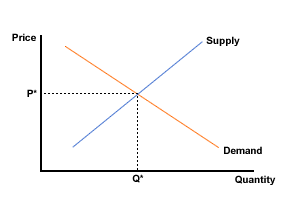
Figure 1 Market equilibrium
Though markets aim to reach equilibrium they can record excesses. This can happen both with demand and supply. When this occurs it is called a disequilibrium and figure 2 below shows possible excess supply and excess demand.
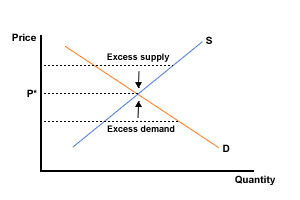
Figure 2 Excess demand and excess supply
Where there is excess demand in a market this will tend to drive the price upwards, whereas excess supply will tend to drive it downwards.
Demand and supply alter because of changes in certain conditions. If the price of the product you are looking at changes there will be a MOVEMENT along its demand or supply curve (see figure 3 for a move along a demand curve and figure 5 for movements along a supply curve), whilst if any other condition, apart from price of the item you are looking at, changes, then you will have to SHIFT either the demand or the supply curve (see figure 4 for shifts in a demand curve and figure 6 for shifts in a supply curve).
A movement along the demand or supply curve is called a contraction or an extension.
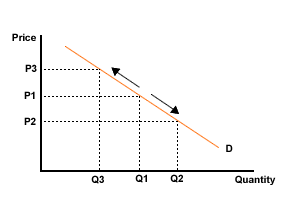
Figure 3 Possible movements along a demand curve
A shift in the demand or supply curve is either an Increase or a Decrease.
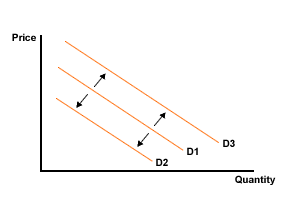
Figure 4 Possible shifts of a demand curve
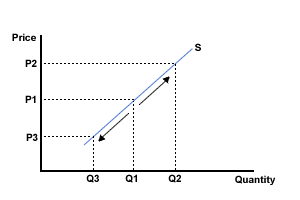
Figure 5 Possible movements along a supply curve
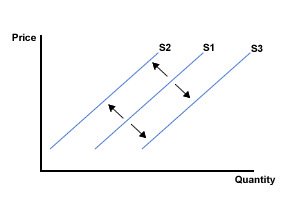
Figure 6 Possible shifts of a supply curve

A short exercise

Hint: Ask yourself the following questions when attempting supply and demand questions:
- Has the price of the item you are looking at changed? If yes, you move along the existing curve. If no, you will have to construct a new curve to the right or left.
- Is the factor examined a condition of demand or a condition of supply?
- Is the change positive or negative for the demand or supply of the product?
On demand and supply diagrams illustrate the following:
(a) An increase in the price of a product - on the demand curve.
(b) A fall in consumer income.
(c) An increase in the production costs of a product.
(d) A fall in the price of a product - on the supply curve.
(e) A rise in the price of a direct competitor's product.
Once you have had a go at these follow the links below to see how the diagrams should have looked.
Answer (a)
Answer (b)
Answer (c)
Answer (d)
Answer (e)

Elasticity

Elasticity is a measure of how sensitive demand is to a change in something that affects it.
You can think of the relationship in terms of the dependent and the independent value.
The DEMAND for a product is the dependent variable, as it is the variable being influenced. It can be influenced by a number of different or independent variables such as:
- Price
- Income
- Advertising
- The prices of other substitute or complementary goods
The dependent variable (the factor being influenced) - in this case, demand - is always placed on the top of the equation as it is being influenced and the independent variable (the factor causing the change in demand) is placed on the bottom of the equation.

We will be start by looking at price elasticity of demand with a definition:

Price elasticity of demand
Price elasticity of demand is a measure of the sensitivity of the demand for a product to changes in its own price. In other words, it is a measure of how much demand for a good or service responds to a change in its price.
Price elasticity of demand is calculated and defined as:
![]()
The following 'aide memoire' may be of use. You usually put your dinner (demand) on your plate (price). Demand is over price, D over P!

Price and demand are usually in inverse relationship. In other words, as price falls, demand increases; and as price increases, demand falls. The result of any calculation of price elasticity normally results in a negative elasticity. In practice, the negative sign is usually excluded.
The value of the elasticity ranges from zero to infinity, and is given different names over different numerical ranges. The table below gives all these possibilities.
| Value | Description | Explanation |
|---|---|---|
| O | PERFECTLY INELASTIC | Price has no effect on demand at all |
| Under 1 | INELASTIC | Price has a small effect on demand. The % change in price is larger than the % change in demand |
| Exactly 1 | UNITARY | % Change in price and % change in demand are the same. Remember, though, the signs are different. |
| Over 1 | ELASTIC | Demand is very sensitive to price. The % change in price is less than the % change in demand. |
| Infinity | PERFECTLY ELASTIC | Any increase in price kills demand. |
It is usual to represent the degree of elasticity graphically. The common shapes for demand curves and their elasticity values are given in the diagrams below.
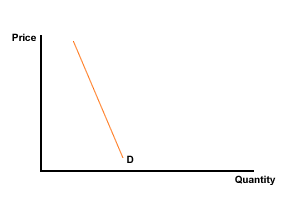
Figure 1 Inelastic demand curve
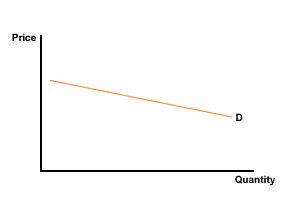
Figure 2 Elastic demand curve
The special shape that represents a price elasticity of 1 is known as a rectangular hyperbola! This is shown below.
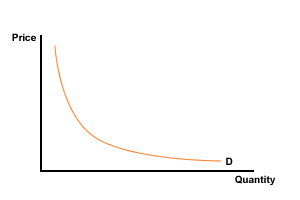
Figure 3 Unit elastic demand curve
Price elasticity of a good or service depends on a range of factors:
- The number of close substitutes in the market. The more substitutes available the greater the elasticity.
- Is the product a luxury or a necessity? Luxuries are more elastic than necessities.
- Amount of income spent on the product. Cheap items tend to be inelastic.
- Is the product habit forming? If so demand will become price inelastic.
- The stage of the product life cycle.

You will be expected to:
- calculate elasticity.
- interpret elasticities.
- explain the relationship between elasticities and the product life cycle.
- analyse the relationship between elasticity and sales revenue.
Elasticity and sales revenue
As we have seen, one of the most important uses of elasticity is to see the impact that a change in price will have on the demand for a good. This will affect the amount of revenue a firm can earn from a good or service. The table below summarises the possibilities:
| Price elasticity value | Price change | Impact on firm's revenue | Explanation |
|---|---|---|---|
| Elastic | Increase | Fall | Elastic demand will mean that when price increases, demand will fall by more than the price increased. This means a fall in revenue. |
| Elastic | Decrease | Increase | Elastic demand will mean that when price falls, demand will increase by more than the price decreased. This means an increase in revenue. |
| Inelastic | Increase | Fall | Inelastic demand will mean that when price increases, demand will fall by less than the price increased. This means an increase in revenue. |
| Inelastic | Decrease | Increase | Inelastic demand will mean that when price falls, demand will increase by less than the price decreased. This means a fall in revenue. |
If a firm makes a product which is price elastic, the firm will need to consider carefully before increasing the price as part of a change in the marketing mix. However, if the product is price inelastic, the firm may be able increase price and gain sales revenue.
n.b. Remember that the elasticity varies at different prices.
Price elasticity and the product life cycle
The price elasticity will tend to vary at each stage of the product life cycle.
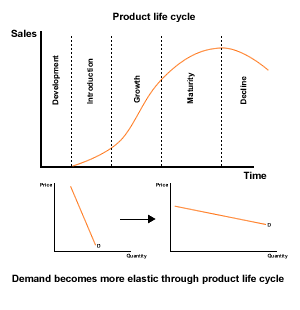
Figure 4 Product life cycle and elasticity
In the growth phase of the product life cycle, the product will tend to be fairly inelastic. This is because of the nature of the demand. People buying at this stage will tend to be 'innovators' and they are prepared to take risks with new products and are willing to pay a high price to have the latest technology.
However, as the product moves towards maturity, the elasticity will increase. The amount of competition will increase and the increasing number of substitutes will make consumers more price sensitive. The nature of the consumers will also change and they are likely to be more motivated to buy by factors like price, functionality and reliability.

Income elasticity of demand (YED)


Income elasticity of demand (YED)
The income elasticity of demand is a measure of the sensitivity of the quantity demanded to changes in real income.
N.B. In economics the abbreviation of Income is 'Y'. This is because 'I' is used for Investment.
Formula:
![]()
Normal and inferior goods
Elasticity can be calculated and a range of values found. What do they show? What do they tell an economist?
Income elasticity may be positive or negative. If income elasticity is negative, demand actually falls as real income rises, which is not the normal reaction. Demand will normally increase as incomes increase as consumers can afford to spend more. As a result, goods or services with such elasticity are called inferior goods.

List some examples of inferior goods.
If the income elasticity is positive, demand increases with real income. These goods are known as normal goods.

List some examples of normal goods.
Elasticity ranges from plus infinity to minus infinity. The sign reveals whether the good is inferior or normal.

Elasticity is given different names over different numerical ranges. Learn these, and the related diagrams.
Some examples of calculations:
Example 1 - income elasticity of demand
Example 2 - income elasticity of demand

Cross elasticity of demand (XED)


Cross elasticity of demand
The cross elasticity is a measure of the sensitivity of the demand for one product to changes in the price of another.
Formula:

Cross price elasticity varies from zero to infinity. As before, the now familiar descriptions are used:
| Value | Description |
|---|---|
| 0 | Perfectly inelastic |
| Under 1 | Inelastic |
| 1 | Unitary |
| Over 1 | Elastic |
| Infinity | Perfectly elastic |
Significance of XED sign
The sign is as important as the numerical value, however.
Some products tend to be bought together, others are purchased in competition to each other.
- Products which are in joint demand are called complementary goods.
- Products which are in competitive demand because customers see them as interchangeable, are called substitute goods.

Examples of complements are strawberries and cream, fish and chips, cars and petrol, printers and printer ink. Complementary goods have negative cross price elasticities. Perfect complements will have a cross price elasticity of infinity.
Example - complements

Examples of substitutes are beef and lamb, gas and heating oil, petrol and diesel fuel. (Note that the substitution may not be possible at once). Substitutes have positive cross price elasticities.
Example - substitutes
Cross price elasticity can change with time.

Advertising elasticity of demand (AED)


Advertising elasticity of demand
Advertising elasticity of demand is a measure of how much advertising expenditure affects the demand for a good or service.
Advertising elasticity of demand (AED) is a useful measure of advertising effectiveness. It measures the percentage change in demand for the product or service compared to the percentage change in the level of advertising expenditure.
Formula:

The value that is derived as a result for the advertising elasticity will vary from zero to infinity. As before, the now familiar descriptions are used:
| Value | Description |
|---|---|
| 0 | Perfectly inelastic |
| Under 1 | Inelastic |
| 1 | Unitary |
| Over 1 | Elastic |
| Infinity | Perfectly elastic |
Significance of AED sign
If the value for AED that is calculated is below one, then the product is said to be inelastic in response to advertising expenditure. This means that an increase in advertising expenditure of, say 20%, has led to a growth in demand for the product of less than 20%. The lower the value of the AED, the less effective advertising expenditure has been at boosting demand.
A value of greater than 1 indicates that the demand for the product is highly responsive to changes in advertising expenditure. This means that an increase in advertising expenditure will generate a greater increase in demand for the product.
Limitations of the AED value
However, while the AED value may be very useful, a simple numerical interpretation of the value may not be entirely appropriate for a number of reasons. These might include:
- The purpose of a lot of advertising may not be to directly boost demand, but to help with building a brand image or brand loyalty - the AED value cannot show the effectiveness of this strategy
- If dealing with a family of brands, it may be difficult to isolate the effect of the advertising spending on a single product or service and this may distort the apparent effectiveness of the expenditure
- It may be difficult to isolate the impact of advertising expenditure to a specific time period - some campaigns are ongoing over a considerable period and other factors may also influence demand over an extended period

As in all things economics, the assumption of ceteris paribus applies - that is, all else remains equal. In other words the assumption is that demand can only be affected by one variable at a time. In reality, of course, demand may be affected by price, income and adverting all at the same time, and consequently it may prove difficult to isolate the exact variables affecting demand and the strength of each variable.

4.4 Price - questions
In this section are a series of questions on the topic - Price. The questions may include various types of questions. For example:
- Self-test questions - on-screen questions that give immediate marking and feedback
- Short-answer questions - a series of short-answer questions to help you check your understanding of the topic
- Case study - a case study with associated questions
- In the news - questions based around a topical business news article
Elasticity of demand - self-test


1 |
Price elasticity definitionWhich of the following is the formula we use for price elasticity? |
2 |
InelasticA product is said to be inelastic when its: |
3 |
InelasticWhich of the following would NOT be an influence on the price elasticity of a product? |
4 |
Revenue and elasticityThe impact on a firm's total revenue of an increase in price in an elastic market would be: |
5 |
Elasticity and product life cycleIn which phase of the product life cycle would a product be MORE likely to be inelastic? |

Price, income and cross elasticity - self-test questions


1 |
Price elasticityA cut in price from $1.50 to $1.20 sees demand for a product rise by 10%. What would the price elasticity of demand be for this product? |
2 |
Price elasticityA firm increases its price from $8 to $12 and sees demand for the product fall by 20%. What would the price elasticity of demand be for this product? |
3 |
Income elasticityWhat type of good would you expected to have a negative income elasticity of demand? |
4 |
Income elasticityIf disposable incomes rise by 5% and the income elasticity of demand is known to be 0.5, what change in demand would we expect to see? |
5 |
Price elasticityIf a price cut does not lead to an increase in revenue, we might infer that the demand for this product is? |
6 |
Price elasticityIf the price elasticity of demand for a product is known to be (-) 2.5 and the firm cuts the price of this product by 5%, what change would we expect to see in the demand for this product? |
7 |
Price elasticityIf the price elasticity of demand for a product is known to be (-) 0.5 and the firm increases the price of this product by 10%, what change would we expect to see in the demand for this product? |
8 |
Price elasticityIf the price elasticity of demand for a product is known to be (-) 2.5 and the firm increases the price of this product by 5%, what change would we expect to see in the demand for this product? |
9 |
Sales in a recessionIn a recession, which sort of good would we expect to see a rise in sales for? |
10 |
Price elasticityA cut in price from $75 to $60 sees demand for a product rise by from 1,200 units to 1,500 units. What would the price elasticity of demand be for this product? |
11 |
Income elasticityIf disposable incomes rise by 2% and the income elasticity of demand is known to be 1.5, what change in demand would we expected to see? |
12 |
Price elasticity
The image below shows a medium size yacht. What would you expect the value of the price elasticity of demand for yachts to be?
|
13 |
Price elasticity
The image below shows cigarettes. What would you expect the value of the price elasticity of demand for cigarettes to be?
|
14 |
Price elasticity
The image below shows wheat being harvested. What would you expect the value of the price elasticity of demand for wheat to be?
|

Non - price competition

One purpose of marketing is to reduce the impact of price on purchasing decisions by differentiating the firms' products from that of the competition. This will only be possible if customers genuinely believe that there is a difference worth paying a premium price for.
These other factors are called non-price factors and are usually referred to as non-price competition.
If a firm can get customers to base their purchase decision on non-price factors then there is an opportunity to increase prices without losing many customers, because demand is price inelastic.
The firm may establish competitive advantage by focusing on a Unique Selling Proposition such as superior quality, image, function or any other factor which differentiates their product from their closest rivals.
Pricing and quality
The various elements of the marketing mix need to be consistent with each other. It is important, therefore, when choosing a price that it fits with the other elements of the marketing mix. If a product is priced towards the top end of the market, the promotion must develop a high quality image.
In the same way there will be a close correlation between price and product. A product that is perceived by consumers as high quality may command a premium price, but the reverse is true as well. In his book Marketing Management, Philip Kotler proposes a price quality strategy matrix. This is shown below.
| High price | Medium price | Low price | |
|---|---|---|---|
| High quality | Premium price | Penetration pricing | Superbargain |
| Medium quality | Overpricing | Average price, average quality | Bargain |
| Low quality | Hit and run pricing | Shoddy goods | Cheap goods |

Place examples of products in each of these segments.
Pricing - Conclusion
Unlike the other ingredients of the marketing mix, price generates revenue, so arriving at the correct price is vital to the success of the business. However, there is no one magic pricing strategy that will guarantee success, so a firm should be constantly researching the market to identify a correct policy for its product or service.
One crucial factor to recognise at the end of this section is that firms may use a combination of pricing strategies in response to changes in the market and the marketing activities of competitors.

- Whenever you are faced with a question on pricing... think ELASTICITY - the two go together like complementary goods! No pricing change should be made without reflecting on the effect on sales revenue and profit, caused by consumer reaction to the change. Do not forget that reducing price can lead to an increase in sales revenue if the market is very price sensitive.
- No firm works in isolation so a change in price may be met by a similar reduction by competitors, so changing the nature of elasticity and the significance of revenue changes.
Pricing policy

Question 1
Explain how the Ford Car Company might use demand based pricing.
Question 2
Why might the pricing of the original Sony Walkman have been an example of skimming?
Question 3
How might you use price to introduce a product into a very competitive market?
Question 4
When travelling by train are you subjected to price discrimination?
Question 5
Using examples, explain what is meant by psychological pricing.
Mega yachts and mega money
Read the article Mega yacht maker pushes out the boat (you can do this in the window below or follow the previous link to read the article in a separate window) and then consider answers to the questions below.

Question 1
Define the term 'income elasticity of demand'.
Question 2
Explain the factors that affect the value of the income elasticity of demand for a product like mega yachts.
Question 3
".....the global yacht market is growing steadily at some 10-15% per year". Analyse two external factors that determine the rate of growth of the market for yachts.
Question 4
Prepare a SWOT analysis for the Azimut-Benetti Group and evaluate their future strategy.
Certainly not Dinky prices
Read the article Dinky toy van fetches £6,400 in furious bidding at auction (you can do this in the window below or follow the previous link to read the article in a separate window) and then consider answers to the questions below.

You may also like to read the following articles to support your answers to the questions below:

Question 1
Distinguish between price and income elasticity
Question 2
Explain how sale of Dinky toys at auction is an excellent representation of the supply and demand process in establishing price.
Question 3
Examine the role of branding in the toy market.
Question 4
Auction prices have fallen in the last few years. Discuss the role of the external environment in setting prices across an economy.
Hold the Frills
Read the article Hold the frills: How budget airlines broadened our horizons and then have a go at the questions below. You can either read the article in the window below, or follow the previous link to open the article in a new window.

Question 1
Define the following terms:
- Trade union
- Commission.
Question 2
Explain the effect of deregulating the airline industry.
Question 3
Analyse the advantages and disadvantages of 'cutting out the middleman' in the distribution chain.
Question 4
Using information from the article and from other sources you can find, evaluate the marketing strategy of Ryanair, with particular emphasis on its pricing structure.
Pricing
The News
Read the following blog post:
Market Competition Drives Down Drug Prices
- Explain what the CPI measures (consumer price index) and how it is calculated.
- Summarise the reasons for falling pharmaceutical prices.
The theory
This piece of news considers pricing and related issues. For information on related theoretical topics, follow the links below.
What is meant by price?
Different pricing policies

Questions
- Define the following terms:
- skimming pricing
- penetration pricing.
- Explain the market conditions which will allow a market skimming pricing.
- Examine the process of setting a price for a new 'me-too' product entering an established market.
Suggested answers
4.4 Price - simulations and activities
In this section are a series of simulations and activities on the topic - Price.
TryIT - Pricing yachts
 Now that you have considered many of the different strategies that companies use to price their products, why not try it out for yourself.
Now that you have considered many of the different strategies that companies use to price their products, why not try it out for yourself.
In the window below is the Maze Green Yachts online business simulation. In this, you get to see how well you can run a major international yacht manufacturer.
To test how well you can price their yachts, go to the Maze Green business simulation (you can either do this in the window below or you can open it in a separate window by following the previous link).

Question 1
How do you think that the values of the price and income elasticities differ between the Maze Green products at the bottom of the price range and the top of the price range? (See elasticity section for more detail on elasticity - click on appropriate page in table of contents on the left)
Question 2
Try running the simulation for one year while increasing the prices of the yachts by 5%. How much have sales gone down by? What is the value of the price elasticity of demand for the yachts?
Question 3
Now try the same while increasing the prices of the yachts by 20%. How much have sales gone down by? Has the price elasticity of demand for the yachts changed?
Question 4
Now try the same while increasing the prices of the yachts by 50%. How much have sales gone down by? Has the price elasticity of demand for the yachts changed?
Question 5
Try running the simulation for one year while decreasing the prices of the yachts by 5%. How much have sales gone up by? What is the value of the price elasticity of demand for the yachts?
Question 6
Now try the same while decreasing the prices of the yachts by 20%. How much have sales gone up by? Has the price elasticity of demand for the yachts changed?
Question 7
Now try the same while decreasing the prices of the yachts by 50%. How much have sales gone up by? Has the price elasticity of demand for the yachts changed?
Question 8
Analyse how the value of the price elasticity of demand is likely to affect your optimum pricing strategy.
Question 9
Develop an appropriate pricing strategy for Maze Green Yachts for the launch of a new yacht. The new product is aimed at the highest income earners and is the largest yacht in their product range. Customers are able to individualise the yachts to a significant extent.
AnimateIT - Markets and prices

In this section we look at animated versions of the supply and demand diagrams. It is worth going through these to see how the changes in supply and demand build up.
Demand curve - shift left
Demand curve - shift right
Supply curve - shift left
Supply curve - shift right

Diagram toolkit

In the diagram toolkit you get given a panel showing possible curves and labels and you then drag these curves onto targets on the diagram to try to build an appropriate diagram. Why not see how well you understand demand and supply by having a go?
There are a number of sections. Follow the links below to access the different sections or use the table of contents on the left.
- The market for air travel (1)
- The market for air travel (2)
- The market for air travel (3)
- The market for iPods (1)
- The market for iPods (2)
- The market for iPods (3)
Why not try the one below as some practice? Drag curves and labels onto the targets on the diagram to build a demand and supply diagram showing a market in equilibrium. Once you think the diagram is right, click 'Check answer'. To see the correct answer, click the 'Feedback' button.
Click on the right arrow to start trying out the diagram toolkit.

Air travel (1)

On the diagrams below, drag curves and labels from the panel on the right to build the appropriate diagram. Once you think the diagram is right, click 'Check answer'. To see the correct answer, click the 'Feedback' button.
Number 1
Number 2
Number 3
Number 4
Click on the right arrow try some further examples.

Air travel (2)

On the diagrams below, drag curves and labels from the panel on the right to build the appropriate diagram. Once you think the diagram is right, click 'Check answer'. To see the correct answer, click the 'Feedback' button.
Number 1
Number 2
Number 3
Click on the right arrow try some further examples.

Air travel (3)

On the diagrams below, drag curves and labels from the panel on the right to build the appropriate diagram. Once you think the diagram is right, click 'Check answer'. To see the correct answer, click the 'Feedback' button.
Number 1
Number 2
Number 3
Click on the right arrow try some further examples.

iPods (1)

On the diagrams below, drag curves and labels from the panel on the right to build the appropriate diagram. Once you think the diagram is right, click 'Check answer'. To see the correct answer, click the 'Feedback' button.
Number 1
Number 2
Number 3
Number 4
Click on the right arrow try some further examples.

iPods (2)

On the diagrams below, drag curves and labels from the panel on the right to build the appropriate diagram. Once you think the diagram is right, click 'Check answer'. To see the correct answer, click the 'Feedback' button.
Number 1
Number 2
Number 3
Click on the right arrow try some further examples.

iPods (3)

On the diagrams below, drag curves and labels from the panel on the right to build the appropriate diagram. Once you think the diagram is right, click 'Check answer'. To see the correct answer, click the 'Feedback' button.
Number 1
Number 2
Number 3

4.4 Promotion - notes
In the previous sections we examined the role, definition and nature of marketing, marketing planning, the marketing mix, marketing objectives, positioning and market research. We then looked at the classification of products, new product development, the product life cycle, product portfolios and branding and analysed and evaluated pricing strategies and polices.
In this section, we will analyse promotional tools.

By the end of this section you should be able to:
- Distinguish between the different types of promotion
- Analyse the various promotional tools and discuss their effectiveness
Promotion
Promotion refers to all the various ways in which a firm can communicate with its existing and potential customers to make them aware of the goods and services it offers, and then persuade them to purchase. Promotion is also used to explain the uses and benefits of a firm's products and to differentiate them from competitors in the market. The tool box of promotional methods is known as the firm's Promotional Mix.

Promotional Mix
The Promotional Mix refers to the specific combination of ingredients that make up a firm's marketing communications strategy. The major elements of the mix are advertising, sales promotion, personal selling, direct marketing and public relations.

It must be recognised that the impact of new technologies and the growth of the World Wide Web have significantly extended the opportunities available to a firm for promotional activities.
Some forms of promotion are paid for, while others are 'free', although even free promotion, such 'word of mouth' may be the result of many years of paid for promotion.
Promotion is part of the firm's marketing plan, which in turn must reflect its mission and corporate objectives. If this is not the case, customers will become confused about the nature and character of the firm.
Promotion of products and services aims to:
- Build brand awareness, so cementing the major main selling points in the minds of customers, both current and prospective.
- Develop recognition of the firm's range.
- Attract attention to the whole 'family' of products offered by the firm.
The key promotional objectives are to:
- Inform
- Persuade
- Remind
The importance of these three aims will change as a product moves through its life cycle:
- In the early stages, customers may not have a good understanding of the firm's products and services, so promotion is used to inform by explaining the nature of the product offer; its key features and characteristics.
- As a product moves into the growth phase, the firm will need to persuade customers of other brands to change their brand allegiance. Obviously all campaigns must be 'truthful and honest' and not break the various laws on Trades Descriptions. In some countries 'comparative advertising' (this can be little more than disparaging rival products!) is not allowed.
- When the product is mature, the firm will need to remind loyal customers to repurchase, or encourage them to buy in larger quantities.
Promotional campaigns might also be aimed at achieving other promotional objectives. These may be tactical in nature rather than the more general strategic objectives of increasing sales and profitability. For example, the firm may wish to build awareness of their brands ahead of a new product launch or they may simply wish to clear excess stock in advance of that launch. They may target a specific campaign at reducing seasonality of demand for their products. All of these are tactical promotional objectives as opposed to the more general strategic promotional objectives.
DAGMAR & AIDA
One model that can be useful to the firm when they are trying to build awareness of their product is the DAGMAR model of buying behaviour:
DAGMAR
This stands for Defining, Advertising, Goals and for Measured Advertising Results.
The model aims to increase awareness of the firm's product and is based on FIVE key stages.
| Stage | Consumer | Promotion |
|---|---|---|
| Unaware | Doesn't know us | Use the media to inform |
| Aware | Knows something of us | Build the media presence |
| Comprehension | Recognises us | Introduce product information |
| Conviction | Prefers us | Reinforce via advertising |
| Action | Purchases | Personal selling |
The promotional mix is then designed to allow the potential consumer to move smoothly though to purchase. It is based on following the psychological pattern that human beings follow when deciding whether to buy or not. So, we tend to buy low cost products more on impulse than we do high cost items. When moving people through the five stages the firm has to be aware of competitor reactions and have plans ready to combat actions and successes of others.
Advertising will be one of the key promotional methods at the early stages of this buying process, but other forms of promotion may be more effective at later stages in the process. The DAGMAR model can be a great help when determining an appropriate promotional mix.
AIDA
AIDA is a model similar to DAGMAR as it identifies the processes in successful selling.
AIDA is an acronym of the four stages of the sales process. Devised in 1898 by the American E. St. Elmo Lewis it is practical tool outlining the processes involved in successful sales. AIDA stands for Attention, Interest, Desire and Action. The 'proven models' site provides an excellent summary of the model. You can see this in the window below of following the link to view in a new window.

Prepare a summary of the four elements of the AIDA process
Types of Promotion
If you would prefer to view this interaction in a new web window, then please follow the link below:
Above-the-line promotion - summary
If you would prefer to view this interaction in a new web window, then please follow the link below:
For more detail on each of these types of promotion, look at the following pages. Click on the right arrow at the top or bottom of the page to work through them.
Above-the-line promotion (ATL)
Above-the-line marketing refers to marketing expenditure on advertising in the media such as the press, radio, television, billboards, cinema and the World Wide Web.
Advertising is directed at a mass audience with the intention of reducing the level of price sensitivity by generating customer loyalty and repeat purchasing, which allows the firm to produce or buy in bulk and enjoy the advantages of economies of scale. Advertising is a media message paid for by a sponsor. It is clear who the advertiser is, and in most cases that the message is an advertisement. However, ATL promotions are difficult to measure in terms of actual sales generated.
The most important decision facing those responsible for advertising is which 'medium' to use. This decision will be influenced by considerations such as:
- The target audience - What do our target consumers read, watch and interact with?
- The size of the market - There is little point advertising a niche product to a mass market.
- The relative cost of the various media - firms will need to justify the cost of marketing by increases in sales revenue. Advertising can be very expensive so the choice of advertising may be restricted by the financial resources of the business.
- The time frame of the advert - How permanent does the firm wish the message to be? Does the firm want potential customers to have future reference?
- The nature of the product - What is the best medium to o get across the nature of the product? Is a visual impact necessary?
Successful advertising not only allows new products to be launched it also extends the life cycle of older lines within a product family.
Advertisers really need to understand the behaviour of potential and existing customers and to track social and cultural change to make their advertising as effective a possible and to reach the most number of customers. The following data from Ofcom on the UK identifies that not only are customers viewing a range of media, but that the time of day is important in the placement of advertising:

For advertising to be considered effective it should:
- reach the desired target audience
- be attractive and appealing to the target market
- generate more sales revenue than it costs the firm
Many companies employ agencies to design and track advertising campaigns. The agencies perform certain functions, which most companies either can't afford or don't have the expertise to run. These include:
- Doing the market research for the firm against an agreed format.
- Selecting the best medium for advertising the product or service.
- Developing and testing the campaign materials.
- Applying the funds the firm has set aside for the campaign.
- Tracking the outcome of the campaign and reporting back.
In addition to these functions, agencies also offer specialist services, expert advice and the combination all of the advantages in a cost effective package. Competition in this area of business is normally fierce and companies often change agencies and/or spread their products across a range of agencies.

For a short diversion, why not watch the video below to see some creative use of images in advertising?

Advertising is an area that you may feel confident with because you are immersed in the 24 hour media world! However, this is an area where students perform badly in examinations, because answers tend to be generalised and lack substance and relevant data. For example, telling the examiner about advertisements you have viewed is unlikely to earn many marks.
There are two other major problems:
- Marketing is not JUST advertising - it is ALL the elements of the marketing mix (4 or 7 Ps).
- Promotion is not JUST advertising - it includes ALL the elements, such as PR and direct selling.
Yes, advertising is important and many firms spend a significant proportion of their marketing budget on it - but do not underplay the role of the other elements of the market and promotional mixes.
Television Advertising
 Television is the biggest of the mass media available to advertisers. However, in recent years with the growth of satellite broadcasting, the numbers of channels available has grown substantially. This has meant that the audience size on the established terrestrial channels has declined. However, new channels are often more focused on a particular market segment or niche, which permits adverts to be played to an audience which is more likely to be receptive to the message.
Television is the biggest of the mass media available to advertisers. However, in recent years with the growth of satellite broadcasting, the numbers of channels available has grown substantially. This has meant that the audience size on the established terrestrial channels has declined. However, new channels are often more focused on a particular market segment or niche, which permits adverts to be played to an audience which is more likely to be receptive to the message.

Examples of Specialist Satellite Channels:
- Fishing Channel
- Eurosports
- The God Channel
- Fashion TV
- Sailing Channel
- Dating Channel
- Extreme Sports
- Travel Deals Direct
- Create and Craft
- Medical Channel
- History Channel
One potential problem facing advertisers is that newer technologies, incorporating a hard disk, allow the viewer to both record, and pause, live television. This also provides the opportunity to fast forward through the advert break, so removing any benefit to the advertiser.
Peak time advertising costs on television can be huge as can adverting during major cultural and sporting events:

Prices for a 30 seconds advert in the USA during the Super Bowl final in 2010 typically cost $2.6 million dollars and $5million dollars for a similar length spot during the Olympic Games in China.
Indeed, following the success of the Olympic Games, China is projected to become the fourth-largest global advertising market. Advertising spending in China stood at $120 billion in 2010. By far the greatest expenditure was on television advertising, supported by big-spending toiletries companies such as Procter & Gamble, Unilever and L'Oreal. Overall, the top-spending categories in China are toiletries, business and services, foodstuffs, pharmaceuticals and beverages.
The advertisement shown in the window below commemorates the 20th anniversary of Proctor & Gamble China. The advert links a variety of P&G products ranging from its Olay skin cream, to Rejoice shampoo and Pringles potato chips and demonstrating how much P&G's products have been incorporated into Chinese consumers' lives - so much so that viewers may even mistake the company for a Chinese firm. You can watch this advertisement in a separate window.
The following Coke advertisement celebrated the 2010 Chinese New Year and shows that like P&G, Coke has fashioned its campaigns for the Chinese mass market. The advert features the popular Taiwanese boy band Fahrenheit. Shows them exchanging red envelopes stuffed with cash, but then reunite via a live webcam chat to bring in the New Year. You can also watch this advertisement in a separate window.
Source: The China Observer
Advantages of television advertising
- Visual impact is high if advertisement is well designed
- Can be used to convey nature of the product through demonstration, sound and vision
- Some targeting of market segments is possible through selective use of advertising slots and appropriate channels
- Reaches a significant audience
- Can be effective for raising awareness and brand development
- Television ownership worldwide has increased as incomes rise
- High Definition and 3D technology has improved the impact of advertisements
Disadvantages of television advertising
- Expensive - not appropriate for all companies as large portions of the budget may be lost to inappropriate market segments
- Unsuitable for small firms where large demand could not be met
- Increasing use of recording and TV on demand services is leading to adverts not even being watched
- Increasing number of TV channels may water down message and reduce potential audience (though this may offer increased opportunities for greater market segmentation with more specialist channels)
- Not appropriate for conveying complex information or large amounts of information as timeslots tend to be short
- Viewers cannot refer back to the advert unless they record it
Consumers can now choose to watch television or video on other devices other than a traditional television set. In 2010, AC Nielsen, the US marketing research company, reported on how people were watching television and other video media. The introduction to this report says:
The history of video consumption has been additive. Consumers globally have proven their insatiable appetites for video-delivery of information and entertainment and new means and screens have proliferated. Whether it be standard TV, on the computer or on a mobile phone, viewership continues to grow, and will likely do so as new technologies enhance the experience and convenience.
To get a better sense for how the world is consuming video today, Nielsen recently conducted a survey of more than 27000 online consumers in 55 countries, asking simple questions about how they watch video. Looked at, in the context of Nielsen's more detailed syndicated measurement of video consumption across many markets, the result is a baseline understanding of the state of cross-platform consumption amongst global online consumers
You can view the slide show of this report by following the link below:
Radio advertising
 Radio listening has recently enjoyed a renaissance as the methods for listening have expanded considerably and the number of stations available have proliferated. Apart from the portable radio, car radio and radio found in other music systems, consumers can listen online and through internet radios. Governments around the world are promoting Digital Audio Broadcasting (DAB) systems as they seek to move television viewers and radio listeners to accept digital broadcasting.
Radio listening has recently enjoyed a renaissance as the methods for listening have expanded considerably and the number of stations available have proliferated. Apart from the portable radio, car radio and radio found in other music systems, consumers can listen online and through internet radios. Governments around the world are promoting Digital Audio Broadcasting (DAB) systems as they seek to move television viewers and radio listeners to accept digital broadcasting.
Radio advertising is significantly cheaper than television advertising, because audience size tends to be much smaller. The peak times for listening to the radio are the morning and evening. Unlike television, the radio is often an accompaniment to some other activity such as eating, driving or getting up, which means that the listener's attention may not always be on an advertisement.
Advantages of radio advertising
- Can be effectively targeted geographically through local radio stations
- Some targeting is possible though analysis of the profile of listeners
- Relatively inexpensive (particularly against TV advertising)
Disadvantages of radio advertising
- As with TV and some print media, adverts will have a relatively short life and full campaigns may be required to catch consumer attention
- All auditory and no visual stimuli - no images are possible to differentiate one product from another
- Can be difficult to stand out and grab people's attention given nature of radio listening
Newspaper and magazine advertising
The print market is coming under pressure from digital news and entertainment output, but nonetheless national newspapers and magazines still hold the loyalty of millions of readers and represent the whole range of opinions and lifestyles within a population. It is relatively easy for potential advertisers to establish the demographics of the target market and advertise to a mass market or focus their advertising on particular market segments.
Compared to television advertising, print advertising is relatively cheap. Local newspapers will appeal to regional businesses, while multinationals will look for the 'wow factor' that a national newspaper or magazine can offer. Magazines provide even greater value added with enhanced quality through glossy photographs and quality paper, appealing to high end and fashionable organisations.
Advantages of newspaper and magazine advertising
- Good coverage - national or local options (local newspapers offer good geographical selection)
- Can be used to convey a significant amount of information
- Relatively cost-effective
- Some targeting possible by knowing the profile (socio-economic group etc) of the readership of the newspaper or magazine
- Readers have the opportunity to refer back to advertisements at a later date. Magazines, in particular, may be kept for long periods if they contain articles that readers wish to keep or refer to at a later stage
Disadvantages of newspaper and magazine advertising
- Short lifespan - adverts may need to run for lengthy campaigns to ensure impact
- Newspapers are more transitory in that news dates rapidly. Consumers are less likely to retain a newspaper for long
- May be difficult to catch attention in amongst extensive advertising from other companies
- Magazines tend to be overloaded with advertisements and this can lead to advertising clutter that the reader chooses to flick through and ignore.
To compete with digital output, most newspapers and magazines have their own website and some have ventured into the subscription market such as the Times Group and the Wall Street Journal offered as Apps on smartphones and e-readers such as the iPad.
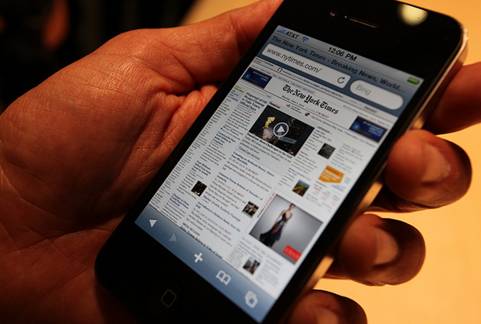
Billboards, posters and advertising hoardings
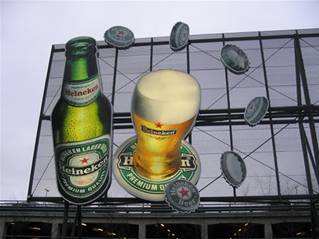 Outdoor advertising has existed for centuries in many forms, promoting local events such as plays and entertainment - including no doubt Gladiatorial combat and Shakespeare productions. Posters and billboards are excellent ways of informing and reminding customers of products and brands.
Outdoor advertising has existed for centuries in many forms, promoting local events such as plays and entertainment - including no doubt Gladiatorial combat and Shakespeare productions. Posters and billboards are excellent ways of informing and reminding customers of products and brands.
Outdoor advertising has often been accused of failing to engage because of its static nature. However, advertisers have found new and innovative ways of using these traditional advertising forms by imaginative placement and design and by incorporating the latest technologies using movement and sound. For example, when watching Champions' league football and other major sporting events, it is difficult to ignore the constant changing of the electronic hoardings around the ground. Billboards, posters and hoardings now incorporate interactive features as shown in the following videos:
Advantages of advertising on billboards, posters and advertising hoardings
- Can be effectively targeted geographically
- Relatively inexpensive
- Can be effective at building awareness and reinforcing brand identity
- Can be made to be visually stimulating
- Relatively high coverage if situated appropriately
- Increasing use of technology makes outdoor advertising more versatile, eye-catching, interactive and engaging
Disadvantages of advertising on billboards, posters and advertising hoardings
- Difficult to convey much information
- Can be lost in amongst other elements of the urban landscape
- Difficult to target specific market segments (except through location)
- Difficult to monitor the effectiveness and return on expenditure
- Prone to damage from weather and vandalism
- Pressure groups campaigns against advertising clutter in the environment
Digital promotion techniques
Firms are increasingly using web banners and web search engines to promote brands.
- Web banners are a form of online advertising where advertisements are embedded into a web page. The intention is to attract traffic to a website by linking to the website of the advertiser. Affiliates earn money usually on a cost per click (CPC) basis.
Web banners have the same purpose as traditional advertisements by informing consumers of products or services and then persuading them to buy. It is, however, easier to monitor the results and effectiveness of web campaigns and can be targeted to the viewer's interests. Online behaviour can be measured through the use of click tags which record how often a consumer views a sites and the interest shown on links on the site.
- Firms can pay for a sponsored link on a search engine such as Google to appear at the top of a list of results for a particular search word or phrase. Pay per click (PPC) is an Internet advertising model used on websites, where advertisers pay their host only when their ad is clicked. With search engines, advertisers typically bid on keyword phrases relevant to their target market. Google AdWords, Yahoo! Search Marketing, and Microsoft adCenter are the three largest network operators, all operating a bid-based model.

Activity -Keywords on Google Adwords
Below-the-line promotion - summary
If you would prefer to view this interaction in a new web window, then please follow the link below:
For more detail on each of these types of promotion, look at the following pages. Click on the right arrow at the top or bottom of the page to work through them.
Below-the-line promotion (BTL)
By using below-the-line promotion techniques the firm can keep control over its promotional efforts and does not have to pay intermediaries and external agencies. As a result, BTL promotion is relatively cheap compared to ATL promotion.
BTL promotions target individuals based on their needs or preferences and can lead directly to sales. The results can be easily measured providing valuable data to estimate return-on-investment.
Examples of BTL promotion are:
- Sales promotion
- Direct marketing and direct mail
- Public relations (PR)
- Sponsorship
- Personal selling
- Branding and merchandising
- Packaging
- Telemarketing
- Trade fairs and exhibitions
Sales promotion
Sales promotions are temporary methods to improve sales by attracting new customers and encouraging existing customers to purchase more. Although offers may be short-term, there is a belief that trial of the firm's product will to create brand loyalty.
Naturally sales promotion is not without cost. Discounts and free samples, for example, reduce a firm's profit margin.
Sales promotion can be divided into two types:
- Into the pipeline: these are promotional activities designed to encourage retailers and wholesalers to stock the product. These include incentives such as discounts, credit terms, prizes, merchandising and display materials and equipment.
- Out of the pipeline: these are promotional activities carried out by manufacturers to encourage customers to buy in greater quantities. These include incentives such as discounts, free gifts and samples, BOGOF offers (buy one, get one free), vouchers, competitions.
Point-of-sales promotions are promotional activities directed at customers in retail outlets, such as special displays, tastings, demonstrations and sales presentations. These are normally combined with vouchers and other special offers on purchases in that shop. This merchandising is to encourage impulse buying.
Direct marketing
Whenever you buy a product, your information may be collected somewhere in the process, especially if the purchase is online. Firms like to collect as much information about you as they can, because this information can be even more valuable than the purchase itself and you may not always notice the small print about sharing your details with 'trusted partners', meaning that you are likely to be targeted by a range of additional organisations in the future.
Firms use loyalty cards to gather data about your purchasing behaviour, which they can use to target you with additional offers or sell that information to other businesses. Even governments sell information gathered about you using information from the census, student cards or passport and driving licence applications.
Direct marketers target customers without using traditional formal channels of advertising, such as TV, newspapers or radio. Firms communicate straight to with consumers with advertising techniques such as fliers, catalogues and promotional literature. If an advertisement asks the customer to respond in some way, such as calling a free phone number or visiting a website, this is called direct response advertising.
 Of all the forms of promotion, direct marketing is probably the fastest growing area. There are many research organisations which examine market trends, focus on customer behaviour and sell their findings. They are likely to gather and sell lists of potential customers to businesses - if you want to sell kitchen knives, there will be a list of customers who buy kitchen equipment on a regular basis and the same applies for even the most specialist organisations. If you use online sites, like Amazon, you will know they will target you with products they think will be of interest based on your previous purchase behaviour.
Of all the forms of promotion, direct marketing is probably the fastest growing area. There are many research organisations which examine market trends, focus on customer behaviour and sell their findings. They are likely to gather and sell lists of potential customers to businesses - if you want to sell kitchen knives, there will be a list of customers who buy kitchen equipment on a regular basis and the same applies for even the most specialist organisations. If you use online sites, like Amazon, you will know they will target you with products they think will be of interest based on your previous purchase behaviour.
Direct marketing is predominantly used by small to medium-size enterprises with limited advertising budgets that do not have a well-recognized brand message.
Direct mail
Direct mail is a direct marketing technique involving the delivery of promotional material to named individuals at their homes or organisational premises, selected from a list of known customers.
This is sometimes referred to as 'junk mail' because the majority of people simply bin the materials when they receive them as they are not seen as relevant or desired. However, if direct marketers target the correct customers with goods and services they are likely to be interested in, the chance of the mail being thrown away is significantly reduced.
It is more of a personalised way of promoting the business, but it often fails to produce a large enough sales revenue to justify its use. Telephone selling can be used as a slightly cheaper method of direct contact with potential consumers.
Advantages of direct mail
- Can be effectively targeted geographically
- Can be used to convey a significant amount of information
- Relatively cost-effective if targeted specifically at certain market segments
- If databases are up-to-date, then can be quite selectively targeted
Disadvantages of direct mail
- Mailing lists can become obsolete if not maintained
- Relatively low return rates/uptake
- Can be expensive if large blanket/national campaigns are used
Public relations (PR) - Publicity
Most organisations handle the outflow of information with great care. The main goal of a public relations department is to enhance the firm's reputation. Publicity is far more cost-effective than advertising, because unlike advertising, where the firm pays for the message, public relations messages are not paid for.
 Traditional PR tools include press releases and media kits which are sent out to generate positive press on behalf of the organization which consist of promotional materials that give information about an event, organisation, business, or person. The purpose is to show the company in a positive light no matter what. Good publicity has greater longevity than advertising. A positive article about a firm will be remembered far longer than an advertisement, which is clearly sponsored and so may not be believed. Publicity has greater credibility with the public than does advertising. Readers feel that if a magazine, newspaper or radio reporter is featuring a business it must be doing something worthwhile.
Traditional PR tools include press releases and media kits which are sent out to generate positive press on behalf of the organization which consist of promotional materials that give information about an event, organisation, business, or person. The purpose is to show the company in a positive light no matter what. Good publicity has greater longevity than advertising. A positive article about a firm will be remembered far longer than an advertisement, which is clearly sponsored and so may not be believed. Publicity has greater credibility with the public than does advertising. Readers feel that if a magazine, newspaper or radio reporter is featuring a business it must be doing something worthwhile.
For the media, good PR is often treated as a news story even though it promotes the organisation at the same time. Other tools used to provide positive information including brochures, newsletters and annual reports.
Markets are extremely competitive so firms need something to make them more appealing and interesting to both the public and the media. Firms are becoming more imaginative in their promotional techniques. Increasingly PR departments are using social networking sites, such as Twitter and Facebook, to support their campaigns. These social media sites allow the firm to engage in two-way communication, and receive immediate feedback from their various stakeholders.
Sponsorship/celebrity endorsement
Companies are keen to get their brand name associated with celebrities and major events, believing that the excitement and vitality of the event and the celebrity will become associated with the brand.
Sponsorship is where an organisation pays to be associated with a particular event, cause or image. It is most in evidence in the sports' arena, where no major event is without at least one significant sponsor. The hope is that the celebrity endorsement will encourage fans to equate the image of the athlete with their products and services Therefore, firms look for positive qualities such as an athlete's global popularity and recognition, credibility, fitness, physical attractiveness, trustworthiness, expertise and personal strengths.
The salaries and winnings of the best known athletes will often be dwarfed by the value of their 'image rights'. Firms pay celebrities to adorn themselves with their brand name or products. Top tennis players, for example, receive huge sponsorship fees for clothing and tennis equipment and even for using a particular brand of drink between games. Footballers wear clearly branded boots and appear for their sponsors in advertisements and at company events, where they endorse the firms' products.

Roger Federer is contracted to Nike to wear their footwear and clothing. Nike designed a personalised jacket for Federer emblazoned with a crest of four tennis racquets, symbolising the four Wimbledon Championships he had previously won. He also has his own logo, an R and F joined together.
Federer endorses Gillette, Jura (a Swiss-based coffee machine company), as well as Mercedes Benz and NetJets. He also endorses Rolex watches, although he was previously an ambassador for Maurice Lacroix. In 2009, Federer became brand ambassador for Swiss chocolate makers Lindt. In 2010 his endorsement by Mercedes-Benz China was extended into a global Mercedes-Benz partnership deal.
Source: Wikipedia

- Select four top sports celebrities and investigate the companies who sponsor them. Then suggest what characteristics those celebrities bring to the brand that justifies their sponsorship agreement.
- Tiger Woods is one of the world's richest sportsmen. Research his sponsors' different reactions to the negative events around his personal life and explain why you think these companies acted the way they did.
Design, logos and other symbols
Visual representations of a firm are crucial as part of its overall identity. It is very easy for us to think of myriads of businesses where its logo or symbol is more important than its brand name. You are likely to think instantly of the golden arches based on the 'M' of McDonalds, the Nike tick and the three stripes of Adidas. We have discussed the value of such brands earlier in this topic, but it may be more difficult to value a logo separate from the brand. A logo should be shorthand for the trust in the firm and for the value of the product.
The logo should:
- reflect the brand's positioning, image and positive attributes
- differentiate the brand from its competitors
- allow easy recognition
- be based on a strong creative idea
- be flexible in its use, so that it can be used in a variety of sizes and colours
Packaging
Some marketing academics believe that packaging should be a separate P in the marketing mix because of its importance in the promotion of a product and the time and cost entailed. Packaging has many functions; it can be used to:
- highlight both the logo and brand name
- protect and preserve the product during transportation and on the shelf
- help carry the product
- facilitate quick recognition of the product
- provides information on ingredients, nutrition, weight and function
- add-value through attractive packaging which acts as a gift wrapping
Trade Fairs and Exhibitions
 Trade fairs offer the opportunity for firms to meet with both the trade and the individual consumer. It also allows representatives of the firm to see what competitors are doing and to learn about innovations and new product offers. There are also opportunities for collaborations and joint ventures to be established as firms identify other organisations with complementary offers.
Trade fairs offer the opportunity for firms to meet with both the trade and the individual consumer. It also allows representatives of the firm to see what competitors are doing and to learn about innovations and new product offers. There are also opportunities for collaborations and joint ventures to be established as firms identify other organisations with complementary offers.
Exhibitions allow firms to showcase new products and elicit responses from potential customers. The purpose is to increase awareness and to encourage trial; the main focus is not on immediate sales, even though there may be some generated by special 'show promotions and discounts. They are highly focused in that they attract a specific segment of the market; for example major computer, car and boat exhibitions will attract those who are current or potential purchasers or those with a particular interest.
By having a stand at an exhibition firms will be promoting not only their products, but their brand.
Digital media
When we examined ATL promotion we considered the promotion of firms through search engines and other company websites. Clearly, increasingly significant BTL promotional opportunities exist through a firm's own website.
Website design is crucial in the firm's attempt to capture the interest and attention of potential customers. The site itself is likely to carry a range of articles, images, pages and general information that promote the firm, provides its story and informs customers of their products and services and the benefits they will bring. Some websites have games and videos; others collect information about products and services and have links to other relevant sites of interest to the customer. Full access to a website may be by subscription only which provides an additional income stream for the business.

1 |
Types of promotionMatch the description below to the appropriate type of promotion. |
Promotional tools

Digital Advertising
4.5 Promotion - questions
In this section are a series of questions on the topic - Promotion. The questions may include various types of questions. For example:
- Self-test questions - on-screen questions that give immediate marking and feedback
- Short-answer questions - a series of short-answer questions to help you check your understanding of the topic
- Case study - a case study with associated questions
- In the news - questions based around a topical business news article
Promotional techniques - short answer questions

Question 1
In the very competitive business of chocolate bars explain how a chocolate manufacturer would try to build customer loyalty.
Question 2
Explain how a firm can communicate its 'value' and 'qualities' to potential customers.
Marketing case study (1)

The Royal Sun Alliance has, like many of its competitors, passed through a very difficult time. A pensions' scandal, fall in share values and other problems saw a once famous brand suffer a dramatic fall in its popularity. New, low cost pension and insurance schemes, which used technology to cut costs, saw their customer base decline and potential purchasers started to ask more and more difficult questions. Royal's products began to look dated.
Management decided that the best way to guarantee the survival of an old and trusted company was to move into different sections of their core markets and offer some new products as well. They moved up market and looked for business amongst the professional classes. Products were sold in new ways, with technology being a major influence on how customers received their services. The 'direct' approach was introduced to a wide range of the services they offered. Customer care and convenience were stressed in all the advertising literature. New products such as car insurance were introduced and a range of 'financial services' were added to the product range.
At the same time cultural changes were made within the business with 'customer care' being the largest single factor in staff training. Costs were reduced by both redundancies and the increased application of technology.
So, as the century closed a business of many years standing felt confident that it would survive whatever the future held. Alas, the early years of the new century have seen little improvement in the market standing of this once proud enterprise.

Question 1
Define (a) core business and (b) corporate culture.
Question 2
Explain how Royal felt it would build business in the new era of direct selling.
Question 3
In what ways might Royal increase its use of technology and why might this not always meet with positive customer reaction?
Question 4
How might the company expand its business horizons?
Marketing case study (2) - It's all in the colour?

Until recently orange was the advertising world's least favourite colour. For them their research suggested that it was a colour associated with looking cheap. Yet now a wide assortment of businesses has adopted orange as their corporate colour. The merger of Smith Kline and Wellcome saw the rather bright shade of tangerine appear as the colour of the new company. Their research found that people 'feel better and inclined to think of a long and healthy life' - just what the company was aiming to do with its product range. So, why has orange made such a strong re-appearance? Well, it seems that we think of the colour as representing:
- Hope
- Fun
- Freedom
- Friendly things
- Extroverts
- Modern
- Powerful
We are all familiar with easyJet and it love affair with all things orange. They say it represents being 'up for it and passionate and sharp! Even those who have not gone over to orange for everything they have added just a touch - signal that they 'want to be liked' - look at Renault and Intel.

So, why does a colour signify so much? It seems to be part science and part art. Experts suggest that red excites, whilst blue calms us. Pink seems to mean that we eat less and of course orange, would you believe it stimulates our desire to eat. We seem to moving away from primary colours and turning our attention to the secondary. Again if one asks the experts they report that they allow breaking away from tradition and showing our desire for freedom.
If we leave colour alone for just a minute and think about how we shop then some things might become a little clearer. In the US, they believe that we make our minds up about what we like in less than 90 seconds. Once in a shopping environment (and that is a question on its own) we buy between 60 and 90 percent of our purchases on colour stimulus. This might explain why Cadbury's fight to keep purple their own. These 'visual triggers' are a vital part of our buying processes and manufacturers know this.
Another interesting fact about colour is that it means different things in different countries. The Japanese consider that red shows luxury, whereas Italians hate it as it brings bad luck. Red to Chinese people is a good luck colour, yet in many other countries it is a symbol of passion, competition and normally pitched at male products. The well-known coke can is red, as are many consumer goods, as this helps recognition. Colours change over a period of time and a visit to the Coke head office would allow us to note who the red has altered since its big introduction back in the days of the First World War. Blue, they other big primary colour also crosses cultures. It seems to symbolise cool, calm, authoritative and is seen as 'safe' - hence many banks and financial institutions choose it.
It is therefore very important to consider colour when designing logos and corporate colour schemes. Think just where we be without those 'golden arches and their close cousin the red packaging?'
Let's conclude by analysing the most popular colours.
- Red = Coke. Red means power and in the Far East good luck - hence the number of companies based there who use red in their logo - Canon, Sharp and HSBC.
- Pink = FT. This makes us think innocence, which might not be the obvious shade for business. But then salmon pink is a popular corporate colour. The FT has used pink since 1893 and so it's easily recognised - in the late nineteenth century it was the cheapest colour!
- Yellow = Kodak. This is a young and dynamic colour. Kodak first used it in 1906 but now interlace red into their main logo. Their logo is one of the best recognised around the globe.
- Green = BP. Green says money, nature and luck (at least in some cultures). It is now very political and attempts to convey a strong environmental stance. The new BP logo, launched in 2000 contains some yellow as well and was put past a 'feng shui' expert before final release.
- Brown = UPS. This colour suggests solidity and a clean, straightforward approach. UPS have thought about a change but have always returned to their trusted brown. It maybe that we like memories of parcels, which is why the US market always likes the brown!
- Purple = Cadbury's. Since Roman times this colour has been associated with leadership. It still features in official government publications. It's not that popular at present as some feel it's retro and rather 70's. However, it is tipped for a return - soon.
- Blue = IBM. Blue is said to be the world's favourite colour and suggests calmness and authority. Just look at the list of names that use it - Hewlett-Packard, AT&T, Ford, P&G, Gillette, General Motors, Pepsi, Wal-Mart and Unilever. They all have their own shades but it's still blue.
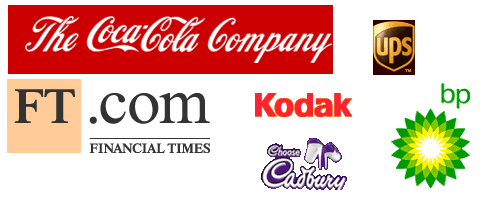
Have a think about the questions below and try to answer them. Once you have had a go, follow the link below the question to compare your answer with ours.

Question 1
Explain why colour is such a powerful element of the 4P's of the marketing mix.
Question 1 - answer
Question 2
Identify methods used to incorporate colour in a firm's marketing mix.
Question 2 - answer
P&G boost their advertising expenditure
Read the article P&G plans to boost advertising spend (you can do this in the window below or follow the previous link to read the article in a separate window) and then consider answers to the questions below.

Question 1
Define the terms:
- Consumer goods
- Innovation
Question 2
Explain how P&G are employing market segmentation, targeting and positioning in its promotional activities.
Question 3
Analyse the use of television in the promotion of household products, such as detergents.
Question 4
Evaluate the market research methods that P&G can use to identify the effectiveness of its advertising campaign.
TryIT - Promoting Maze Green Yachts
 Now that you have considered many of the different strategies that companies use to promote their products, why not try it out for yourself.
Now that you have considered many of the different strategies that companies use to promote their products, why not try it out for yourself.
In the window below is the Maze Green Yachts online business simulation. In this, you get to see how well you can run a major international yacht manufacturer.
To test how well you can promote their yachts, go to the Maze Green business simulation (you can either do this in the window below or you can open it in a separate window by following the previous link).
In the simulation you can change the levels of promotion spending. You can also adjust the pricing of the various products and see how this affects their sales. Have a go at answering the following questions.

Question 1
Distinguish between above the line and below the line promotion.
Question 2
Try running the simulation for two years while increasing promotion spending by 5%. Explain the impact on sales.
Question 3
Try running the simulation for two years while increasing promotion spending by 20%. What impact has this had on sales? How much did this differ from increasing by 5% each period.
Question 4
Try running the simulation for two years while decreasing promotion spending by 5%. What impact has this had on sales?
Question 5
Try running the simulation for two years while decreasing promotion spending by 20%. What impact has this had on sales? How much did this differ from increasing by 5% each period.
Question 6
What conclusions would you draw from the above experiments about the effectiveness of promotion spending for the promotion of yachts?
Question 7
Develop an appropriate promotion strategy for Maze Green Yachts for the launch of a new yacht. The new product is aimed at the highest income earners and is the largest yacht in their product range. Customers are able to individualise the yachts to a significant extent.
4.6 Place (distribution) - notes
In the previous sections we examined the role, definition and nature of marketing, marketing planning, the marketing mix, marketing objectives, positioning and market research. We then looked at the classification of products, new product development, the product life cycle, product portfolios and branding and analysed and evaluated pricing strategies and polices.
We then analysed promotional tools.
In this section we will discuss and evaluate distribution channels and distribution strategies.

By the end of this section you should be able to:
- Discuss the effectiveness of different types of distribution channels

- Evaluate the effectiveness of different types of distributions channels including producers, wholesalers, agents and retailers
- Examine how organisations can increase the efficiency of the supply chain
Place (distribution)
Place is referred to as one of the 4Ps for the sake of simplicity and to create a memorable shorthand for the marketing mix. However, the marketing concept of 'place' is more accurately described as 'distribution'. Where a product is sold is place; getting it from the producer to the consumer is distribution, which is an active process. The process is also known as physical distribution management (PDM), which is concerned with ensuring the product is in the right place at the right time. PDM is often carried out by specialist companies, which use logistics (computer controlled distribution) to maximise channel efficiency and cost-effectiveness.
 Whatever a firm is producing, it has to reach those who want to buy it. There is little point if a firm makes a product that consumers want, promotes it effectively and creates a demand, but then fails to place it in outlets where customers want to buy it. Getting the 'place' right is crucial to the success of the sales process and this involves understanding the customer and their purchasing behaviour.
Whatever a firm is producing, it has to reach those who want to buy it. There is little point if a firm makes a product that consumers want, promotes it effectively and creates a demand, but then fails to place it in outlets where customers want to buy it. Getting the 'place' right is crucial to the success of the sales process and this involves understanding the customer and their purchasing behaviour.
The path from producer to consumer normally involves more than one organisation, though in recent times cutting out parts of the distribution process have become more popular e.g. insurance companies selling direct to consumers rather than through brokers. New technologies have supported the shortening of the distribution chain and encouraged firms to sell directly to the consumer, so reducing costs and lowering prices.

With price competition in markets being so fierce, firms are constantly looking for efficiencies. Once a firm has examined ways of making human resources more productive and squeezing suppliers for the best deals, there are few remaining cost efficiencies except the distribution process. Indeed, it is here that many firms are now finding the extra edge over their rivals.
In the examination, you should not forget the vital role of distribution, even though it is less 'glamorous' than promotion. Distribution topics are also well suited to the internal assessment and the extended essay
Channels of distribution
If you would prefer to view this interaction in a new web window, then please follow the link below:
Channels levels of distribution
If you would prefer to view this interaction in a new web window, then please follow the link below:

To look at each of these in more detail it's easiest to look at some EXAMPLES of how certain goods arrive at the ultimate consumer.
Effectiveness of distribution channels
The effectiveness of different types of distribution channel
Direct marketing is where the goods are sold directly from the product direct to the customer. A producer does not have to share its profit with intermediaries and so it is a low cost channel. The producer controls the whole marketing process and as a result can protect and maintain its brand image. Customers are increasingly using direct sales though the internet and can purchase from the comfort of their own home
However, it can be expensive to set up these channels and all the cost of distribution such as storage and damage rest on the producer. In addition, a recent trend is for customers to search online for products and then purchase them physically from outlets after making comparisons on price.
Wholesaler
A wholesaler is normally an intermediary between the producer and the retailer; although some wholesalers have their own outlets. Wholesalers are prepared to buy in considerable bulk from a producer. They break bulk by distributing smaller quantities to individual retailers. Goods are normally stored in regional warehouses where they are distributed using the wholesaler's vehicles to retailers.
Wholesalers, like major retailers, may have international networks and distribute worldwide. Examples of multinational wholesalers are Makro and Costco.
The advantage for a producer of using a wholesaler is that the wholesaler will:
- store the producer's output so freeing up space for new products
- improve the producer's cash flow by purchasing in bulk
- market the products to retailers
- bear the cost of storage
- bear the risk of storage such as theft, fire and damage
- ensure that the distribution process is cost effective.
However, in return for the costs and risks they bear, wholesalers will expect a significant discount from the producer to allow a mark-up when they sell the products on to retailers. Producers cannot be sure that the wholesalers will maintain the brand image.
Agents/Brokers
Agents and brokers are intermediaries between the producer and the wholesaler and/or retailer. They are experts in certain markets and bring buyers and seller together in return for a commission on the value of the sales. They very rarely take possession of any physical items; they just a facilitate negotiations and the selling process.
Agents and brokers are particularly useful when a firm is selling into a market or geographic region, of which they have little knowledge and experience. Brokers and agents will know the local market and, if it is in an overseas location, will help with the language and the legal requirements. They may also negotiate joint ventures with local firms.
Agents and brokers are probably best known in the buying and selling of land and travel services, but virtually all markets require employ such intermediaries.
Retailers
A retailer is an intermediary, which buys products either from manufacturers or from wholesalers and resells them to consumers. They come in all shapes and sizes from the corner shop to the hypermarket. The advantage of manufacturers using retailers is that they:
- are prepared to buy in bulk
- accept responsibility for storing stock and for any unsold items
- may have strong customers loyalty which may is an attractive proposition for the brands that they stock.
Clearly the disadvantage for the producer is that the retailer will demand a share of the profits and they will also decide how, and where, to display the product. With considerable competition for shelf space in multiple retailers, this placement of a product is a key element of the purchasing decision.
Retailers themselves may choose to use the services of distribution specialists. Marks and Spencer, for example, do not distribute their own products to individual stores. This is done for them by a subsidiary of British Oxygen. M&S prefer to concentrate on presentation at the point of sale.
Channels of distribution
There is considerable debate about how long distribution channels should be. Some years ago the basic rule of thumb was that industrial goods had shorter routes than consumer products, but this is now changing. Many of the traditional routes have seen casualties as wholesalers and specialists have gone out of business.
Modern technology allows goods to be tracked along their distribution route and the next buyer in the chain can remain fully informed of just where the products are.
Most producers will use a range of channels to distribute their products; this approach is known as a multichannel distribution.
Supply chain management & logistics


Supply chain
The supply chain is the systems and networks used by a company to move the product from the origin to the point of sale. This includes the movement of raw materials to the point of production.

Supply chain management
Supply chain management is the process of planning and organising the supply chain as efficiently as possible.
Supply chain management has become an important consideration for firms as supply chains become increasingly complex. The supply chain is the movement of all raw materials from their origin to the production facility (or facilities) and then on to the final consumer. In a globalised market place firms are sourcing raw materials from suppliers all over the world.
New technologies have allowed for ever-increasing flexibility in channel processes. Physical Distribution Management (PDM) is carried out by specialist companies, which use logistics (computer controlled distribution) to maximise channel efficiency and create cost-effective distribution.
Maintaining supply chain efficiency
To ensure an efficient supply chain, a company may have to look at a number of areas of operation. These may include:
- Supplier relationships - working closely with suppliers is an essential element of an efficient supply chain. This may require suppliers being located close physically to the main production facility and perhaps working on a just-in-time basis. This should reduce average levels of stocks. Firms may require shared computer systems to manage the process and to support closer supplier relationships.
- High quality IT hardware and software systems - many supply chains are managed by computer software and given their complexity, this is essential if they are to reach optimum efficiency. As well as high quality software, good hardware systems will be required to minimise or even eliminate any down-time in the supply chain.
- Efficient management of orders and customer communication systems - many companies now sell directly through e-commerce (B2B e-commerce as well as B2C e-commerce) and need to ensure that they have efficient communication systems.
- Strategic sourcing of raw materials - sourcing raw materials may be a trade-off between cost, quality and availability. The cheapest raw materials may be the furthest away and therefore lead to higher transport costs and a longer lead time.
- Ensuring an appropriate mix of production locations to be able to serve all customer markets as quickly and efficiently as possible.
- Efficient distribution and logistics management - to make sure that the product gets to the customer as quickly and cost-effectively as possible may require the use of vehicle routing analysis systems.
- Efficient stock (inventory) management systems - an efficient stock control system is a vital part of any supply chain and the efficient management of stock levels will help to reduce costs. This may involve the use of just-in-time to build closer supplier relationships (see above).
- Benchmarking against competitors - globalisation has led to radical changes in supply chains and it is essential for a firm to benchmark their supply chain against their competitors if they are to ensure they will remain competitive.
- Demand forecasting - being able to forecast customer demand will help with production and distribution planning and so help improve the supply chain.
A solution that many companies have adopted is the outsourcing of their supply chain management to a specialist supply chain company. For companies who perhaps do not have the skills or expertise within the company, this may offer an efficient solution.
There is often some confusion between the two terms logistics and supply chain management. Supply chain management is generally considered to have a broader focus and apply to the whole process of managing relationships with suppliers, customers and perhaps retailers. In other words it the management of the supply chain across multiple enterprises. Logistics on the other hand is usually considered to refer to the procedures and processes for distributing products within a single company.
Online distribution

Read the following article Armani's online store seeks to tap Chinese market (you can either do this in the window below or you can open it in a separate window by following the previous link).

Produce a report outlining a marketing strategy for a new high end product using an online focus.

Cisco Systems
Cisco Systems, founded in 1984, was one of the first firms to sell computer routers. In late 2000, at the height of the dot-com boom, Cisco was the most valuable company in the world with a market capitalisation of more than US$500 billion. In July 2009, with a market capitalisation of about US$108.03 billion, it was still one of the world's most valuable companies.
Cisco adopted a brand-winning model by shedding its role as an equipment manufacturer. It no longer manufacturers most of what it sells, nor requires vast amounts of physical and human capital. Although the initial order goes to Cisco, suppliers ship 55% of orders direct to the customer. However, Cisco bills the customer, pays the supplier and keeps the rest. As a result it has no debt, yet has expanded rapidly. Cisco's return on capital is greater than 25%.
This new distribution method is not quite the same as outsourcing. Suppliers do not keep large inventories and are paid rapidly. There is little paperwork. Cisco has created a seamless supply chain through closer links with suppliers and through the operation of Just-in-Time methods. Most large corporations still manufacture most of what they sell and are highly integrated, e.g. Procter and Gamble. However, technology companies like Cisco, Dell and Microsoft have re-engineered their businesses. They have fewer blue-collar workers and many more skilled engineering and marketing employees. They are becoming 'brand-owning' companies. They are not so much selling products as selling customer satisfaction.
Ford is looking to follow the Cisco model, transforming itself into an e-businesses and a leaner and meaner company. As a result, it has spun-off parts of its business, selling physical assets and investing in more intangibles, such as brand names. In recent years Ford has paid out $12 billion to acquire brands such as Jaguar, Aston Martin, Volvo and Land Rover. They have little plant, but help to develop customer value. They hope that they can use the internet to change to product pull operations. Customer orders are quickly communicated down the supply chain. As a result paint manufacturers will know what colour pigments to order on a real time basis. Ford use Electronic Data Interchange - EDI - to send information down their distribution chains.
Ford is reaching out to the new generation, Generation Y, the baby boomers in the USA through the internet. By marketing through teen portals, they are engaging youngsters in issues such as the environment and new car design and features.

4.7 International marketing - notes
In the previous sections we examined the role, definition and nature of marketing, marketing planning, the marketing mix, marketing objectives, positioning and market research. We then looked at the classification of products, new product development, the product life cycle, product portfolios and branding and analysed and evaluated pricing strategies and polices. We then analysed promotional tools and discussed and evaluated distribution channels and distribution strategies.
In this section we will analyse and evaluate international marketing opportunities.

By the end of this section you should be able to:
- Evaluate the opportunities and threats posed by entry into international markets
- Analyse given situations considering the cultural, legal, political, social and economic issues of entering international markets
International marketing
International marketing is marketing carried out by firms overseas or across national borderlines. This strategy is an extension of the marketing techniques applied in the domestic market to meet the different demands, buying patterns, demographics and market segments of overseas customers.

International marketing
International marketing is the multinational process of planning and executing the conception, pricing, promotion and distribution of ideas, goods, and services to create exchanges that satisfy individual and organizational objectives
American Marketing Association (AMA)
International marketing and global marketing are often used interchangeably, although there is a significant difference. Global marketing is employing a uniform approach to the marketing of goods in overseas markets rather than adapting marketing to the local conditions. For example, global brands such as McDonalds and Adidas try to keep a consistent product, message and offer around the world.
Increasing globalisation is a facet of most firms, markets and brands, because selling into overseas markets has distinct advantages:
- Increased profitability - larger markets result in increases in sales and profitability as well as greater economies of scale. Overseas markets may be more lucrative and as the costs of sourcing from abroad can be considerably lower. In some markets it might be possible to sell at higher prices than can be charged in the domestic markets.
- Diversification and spreading of risk - economic problems in one country can be avoided if the company sells in more than one country. A fall in economic activity in one market may be mitigated by shifting production and sales promotion to other markets that are not undergoing an economic downturn.
- Increased brand exposure and recognition - brands are a valuable intangible asset. Global recognition of a brand will increase this value substantially as well as making it easier for the firm to introduce new products and services into new and existing markets.
- Legal differences - not all countries apply the same standards of health, safety etc and so it might be easier, or less costly to produce and or sell in one country than in another.
- Market saturation - in competitive market situations a firm might be able to both boost sales and prolong the life of a product of the range by selling overseas. In some cases, such as tobacco products, this has enabled companies to continue production when the economic, political and social circumstances have changed in their domestic markets.

The news
Read the article UK Grocery Market To Grow 3.9% a Year till 2015 and then have a go at the questions below. You can either read the article in the window below, or follow the previous link to open the article in a new window.

Question 1
Identify four effects of market saturation.
Question 2
Outline four economies of scale that will benefit large grocery outlets.
Question 3
Analyse the effect of online operations on the traditional marketing mix of a grocery retailer.
Question 4
Evaluate the impact on multinational supermarkets, such as Tesco and Wal-Mart, of the recent economic recession.

1 |
International marketingWhich of the following is a reason why international marketing is different from domestic? |
Entry into international marketing
There are many opportunities by entering into international markets. However, firms considering moving into overseas markets need to be aware of the potential threats to such a strategic from the external environment.
Overseas markets may carry certain problems either absent in the domestic market, or present to a lesser extent. These include:
- Language and cultural differences
- The presence of import controls
- Economic and/or political instability
- Additional documentation
- Transportation and insurance costs
- Exchange rate fluctuations
- Different legal and tax systems
- Corruption
- Packaging modifications
Political problems
The stability, civil society and the general state of the political map within a country can all impact on the success of new entrants to an overseas market. Some governments may be protectionist in that they have significant barriers to entry of both new firms and their products.
Barriers may exist in terms of the awarding of trading licences as well as a whole range of international trade barriers such as quotas, tariffs, embargoes and subsidies for local competitors.
A firm must adapt its products to local laws and customs. In Islamic countries, the law forbids use of animal fat. Some countries forbid the inclusion of non-sugar sweeteners and food preservatives. In India, terms such as 'Giant' and 'King Size' are prohibited as misleading. In Venezuela, prices must be stated on the product; in China this is illegal.
Accounting techniques, ownership, land tenure and many other legal aspects of business life also differ from one country to another.
Social and Cultural constraints
If you would prefer to view this interaction in a new web window, then please follow the link below:
Ethics
Many ethical principles extend across cultures and nationalities. However, what is acceptable in one country may not be in another, such as the nature of working conditions to forms of promotion. Firms have to be sensitive the beliefs of local populations and whether it is ethical to export cultural norms and values.

The tourist industry is an example of the effects of globalisation and the reduction in barriers. By 2020, it is forecast that there will be 1.6 billion international tourist arrivals worldwide. These tourists will spend over US$2 trillion. These figures represent sustained average annual rates of growth of 4.3 per cent, far above the maximum probable expansion of 3 per cent per year in the world's wealth.
Tourism employs one in ten workers worldwide, around 250 million people. At current growth rates, this could rise to over 400 million by 2015. Globally, tourism accounts for roughly 35 per cent of exports of services and over 8 per cent of exports of goods. These figures would make tourism the world's largest employer and arguable its largest business in terms of income.
There are consequences to the globalisation of business activity. As tourists, you and I often seek out destinations, which are new, exciting, and relatively unexplored; difference is the change we are seeking. The fastest growing markets in terms of annualised growth for travel and tourism demand are Angola, Mexico, Turkey, China and India. Tourists bring 'cultural baggage' with them when they travel. We often look to experience different cultures and sights, but seek hotels that offer traditional home luxuries and an environment that mirrors our domestic lifestyle. We also bring enormous wealth with us and this can distort employment patterns within countries as local employees seek the higher rewards offered by the tourist industry. Areas of high tourist activity in relatively poor communities tends to encourage the development of less acceptable 'industries' such as prostitution and the crime' industry', which frequently accompanies this.
We also tend to export our cultural norms and values. Western tourists are prepared to walk around even town centres in beachwear, when local populations regard modesty as a virtue and/or a religious requirement. The tourist industry can be regarded as unethical in its aims and operations.
Of course, the tourist industry is not the only cultural export. Many people learn to use English, not just in the classroom, but in the words of millions of pop songs broadcast across the world. Fashion trends are 'exported' through videos and on the worldwide web. Pop stars, film celebrities and, increasingly, sports icons such as Michael Jordan, Rafael Nadal, Cristiano Ronaldo and David Beckham endorse multinational brands and set fashion directions.
The export of cultural values will affect the aspirations and dreams of local populations. This inevitably will have implications for the political development of a country as the 'new generations' demand economic, cultural and social reform.
Cultural and ethical issues within international marketing extend into employment practices of multinational corporations, including how they treat local employees. Whether the local population perceives them as a foreign or local firm may influence purchasing decisions and attitudes to further expansion, especially by government.
Ethical and policy considerations for multinationals, acting in international markets, will include some of the following:
- Does the firm understand the societies and cultures in which it operates?
- Does it offer local staff similar terms and conditions to those offered in other parts of the business?
- Does it provide equal opportunities for local employees?
- Is the firm aware of the norms and values of the local communities?
- Do the firm's operations have a negative effect on the local and/or national community?
- Does it encourage local suppliers?
- Do local customers and suppliers trust the firm?
- Is ite regarded as a foreign or 'local' firm?

An actual example may help provide a suitable example for an examination.
Ways of entering overseas markets
Firms can enter markets by a variety of routes. These include:
- Direct exporting - the company makes the products at home and then sends them to the country of consumption.
- Franchising - this involves selling the right to trade under your name and logo.
- Licensing - this is almost the same as franchising but now a company buys the right to physically produce your goods.
- Joint venture - which is when two or more companies join together to fulfil a particular contract.
- Direct investment - this is when a company sets up the means of producing and distributing products in an overseas market.
- Mergers and takeovers - here a business buys another that is operating in the country they want to sell in.
Problems with each method
- Exporting - a lack of control over the marketing of the product, especially if the exporter sells via an agent. To counter this some firms may set up fully-owned subsidiaries.
- Franchising - the franchisee keeps some of the profits. The exporter is dependent on the franchisee to maintain the quality and reputation of the brand, though ultimately most franchise agreements would allow for removal of the franchise. This may be too late to prevent damage to the brand reputation.
- Licensing - though the goods are actually produced abroad, which saves costs, the quality control is not directly the responsibility of the original company.
- Joint ventures - the risks are shared by those participating in the venture, but conflicts can arise and the venture may disintegrate.
- Direct investment - this appears to have few problems associated with it, a long as the initial investment can be afforded.
International competitiveness
To trade in international markets firms need to develop a competitive cost base which will allow them to be attractive to consumers in other markets. Why then is it that trade of this type has increased so much in recent years?
- The increase in the number of trading blocs - such as the EU and NAFTA. These reduce tariffs and other barriers between member states e.g. quotas.
- Costs of production - to sell across the continents a company needs to keep its cost base competitive. In particular labour costs have to be kept low, whilst encouraging high productivity. This has promoted the use of outsourcing to low labour cost economies.
- Corporate policies - to remain competitive businesses need to respond to consumer needs. They therefore need to research, innovate and apply technology. To be ahead of the market normally helps and this requires careful training of employees.
- Liberalisation of trade - such organisation as The World Trade Organisation (WTO) work to remove the barriers that stop free trade. The WTO has set itself the task of: phasing out agreements which offer protection to select group of economies, liberalising trade in agricultural goods, preventing the exploitation of intellectual property rights, opening up markets to tenders from other nations and removing voluntary export restraints. As they are more successful so more countries enter the international environment. Other groupings such as the G20 work to promote world trade.

Read the article G20: Leaders' statement from Seoul summit and then have a go at the questions below. You can either read the article in the window below, or follow the previous link to open the article in a new window.

Produce a summary of the G20 summit identifying ten key strategies to promote international trade.
Firms from the developed countries are building trade links with NIC's - the newly industrialised countries, such as the BRIC countries - Brazil, Russia, Indonesia and China.

1 |
Entering overseas marketsWhich of the following is NOT a way of entering overseas markets? |
4.7 International marketing - questions
In this section are a series of questions on the topic - International marketing. The questions may include various types of questions. For example:
- Self-test questions - on-screen questions that give immediate marking and feedback
- Short-answer questions - a series of short-answer questions to help you check your understanding of the topic
- Case study - a case study with associated questions
- In the news - questions based around a topical business news article
Nadal is Building Endorsement Portfolio
Read the article Nadal is Building Endorsement Portfolio and then have a go at the questions below. You can either read the article in the window below, or follow the previous link to open the article in a new window.

Question 1
Define the following terms:
- Celebrity endorsement
- Global marketing.
Question 2
Explain the link between a brand image and pricing strategy.
Question 3
Analyse the advantages and disadvantages of using social networks as part of a promotional campaign.
Question 4
Evaluate the role of celebrity endorsement in the promotion of fashion brands.
4.8 E-commerce - notes
In the previous sections we examined the role, definition and nature of marketing, marketing planning, the marketing mix, marketing objectives, positioning and market research. We then looked at the classification of products, new product development, the product life cycle, product portfolios and branding and analysed and evaluated pricing strategies and polices. We then analysed and evaluated promotional tools, distribution channels and strategies and international marketing opportunities.
In this final section we analyse and discuss the effects and benefits of e-commerce.

By the end of this section you should be able to:
- Analyse the effect of e-commerce on the marketing mix
- Discuss the costs and benefits of e-commerce to firms and consumers
E-commerce
Electronic commerce, commonly known as e-commerce, commonly is defined as the buying and selling of products or services over electronic systems such as the Internet and other computer networks. However, it can include a much wider range of commercial electronic exchanges. It also includes other business transactions such as electronic funds transfer, supply chain management and logistics, e-marketing, electronic data interchange (EDI - the transfer of electronic documents and data from one computer system to another computer system), automated stock control management systems, and automated data collection systems.
E-commerce has grown dramatically in recent years because it allows firms to operate 24 hours a day in the global market. It typically uses the World Wide Web at least some point in the process.
Business-to-business (B2B)

Business-to-business e-commerce (B2B refers to businesses selling to other businesses. For example, when a shop (whether an online or a physical outlet) orders new products for its shelves or a factory orders new steel to make its products.
Business to business e-commerce offers benefits in cost savings and improved efficiency. Consider a completely electronic example: a supermarket that uses bar-code scanners at the cashier (it also uses bar code scanners in other areas to monitor incoming inventory, what's on the shelves, pricing and more). A computer is able to keep track of inventory, monitor buying trends and order new products when necessary. The new orders are made via a network to the computer at a factory. This computer records the order, and sends information to the sales department, production department, distribution department and accounting department to ensure the sale is made, the products are produced and delivered and a bill is sent.
Since computers can operate automatically once programmed, it saves on the cost of staff performing all operations. Computers information is precise and can be up-to-the minute if it is operating in a real-time environment. If used to underpin just-in-time systems, less storage space is required and fewer products become spoiled because they are not sold in time. Also by monitoring buying trends, retailers and manufacturers can make observations about new products that might interest consumers and when is a good time to have a sale to clear excess inventory.
Research shows that B2B e-commerce is being driven from two sides. At the practical level businesses are looking to use technology to develop improved ways of working and relationships with trading partners up and down the supply chain. At the other end of the spectrum are the e-commerce product and service providers who are developing new ideas and concepts and hoping that some will take off. There is a huge difference between using e-commerce to improve the efficiency and effectiveness of existing trading procedures and exploiting the newer business concepts in a way that only a small percentage of organisations are currently doing. Much of the attention given to B2B relates to the emerging developments such as e-marketplaces, and e-exchanges, but in reality most of the actual use is at a lower level in the e-commerce cycle.
B2B e-commerce is used to:
- Attract, develop, retain, and cultivate relationships with customers
- Streamline the supply chain, manufacturing, and purchasing processes and automate corporate processes to deliver the right products and services to customers quickly and cost effectively
- Capture, analyse, and share information about customers and company operations in order to make better and more informed decisions
Delivery
Taking an order is the easy part of any e-commerce activity. The goods have then to be delivered. Much of the B2C success has been associated with the ability to download products such as music or learning material, directly from the web. Although the same model can be applied to B2B, it is more likely that there will be a need for physical delivery.
The five steps to B2B e-commerce
If you would prefer to view this interaction in a new web window, then please follow the link below:
Business-to-customers (B2C)
If you would prefer to view this interaction in a new web window, then please follow the link below:

Websites
- 234 million - The number of websites as of December 2009.
- 47 million - New websites added in 2009.
Source: Pingdom

The Long Tail
Chris Anderson, editor of the online magazine 'Wired' in his best seller, The Long Tail, explores how niche markets are increasingly accessible through the power of the web, so that there can be a Long Tail Distribution beyond the major sellers. Markets are now accessible to small firms selling less popular items, and lots of them, in markets within markets.
Anderson's basic thesis is that the instantaneous transmission of ideas and thoughts that the Internet allows has given rise to powerful niche cultures that are as lucrative and pervasive as mainstream products and culture. The niche (the Tail), while sold in smaller and smaller quantities, still create enough sales to be a significant source of revenue. Such patterns are difficult to sustain in a typical retail shop, with its limited space; but with the Internet, shelf space is not a problem.
According to Anderson, the Long Tail is everywhere, from politics to public relations, and from sheet music to college sports.
"What people intuitively grasped was that new efficiencies in distribution, manufacturing, and marketing were changing the definition of what was commercially viable across the board. The best way to describe these forces is that they are turning unprofitable customers, products, and markets into profitable ones."
Anderson has maintained and developed his interest in niche strategies on his blogs and in his editorials in Wired.
If you would prefer to view this interaction in a new web window, then please follow the link below:
4.8 E-commerce - questions
In this section are a series of questions on the topic - E-commerce. The questions may include various types of questions. For example:
- Self-test questions - on-screen questions that give immediate marking and feedback
- Short-answer questions - a series of short-answer questions to help you check your understanding of the topic
- Case study - a case study with associated questions
- In the news - questions based around a topical business news article
Operation Payback
Operation Payback cripples MasterCard site in revenge for WikiLeaks ban
Read the article Operation Payback cripples MasterCard site in revenge for WikiLeaks ban and then have a go at the questions below. You can either read the article in the window below, or follow the previous link to open the article in a new window.

Question 1
Distinguish between business-to-business (B2B) and business-to-customers (B2C) marketing.
Question 2
Explain how 'hackers' managed to damage the operations of major online businesses.
Question 3
Analyse the effect of e-commerce on the marketing mix.
Question 4
Discuss the costs and benefits of e-commerce to firms and consumers.






